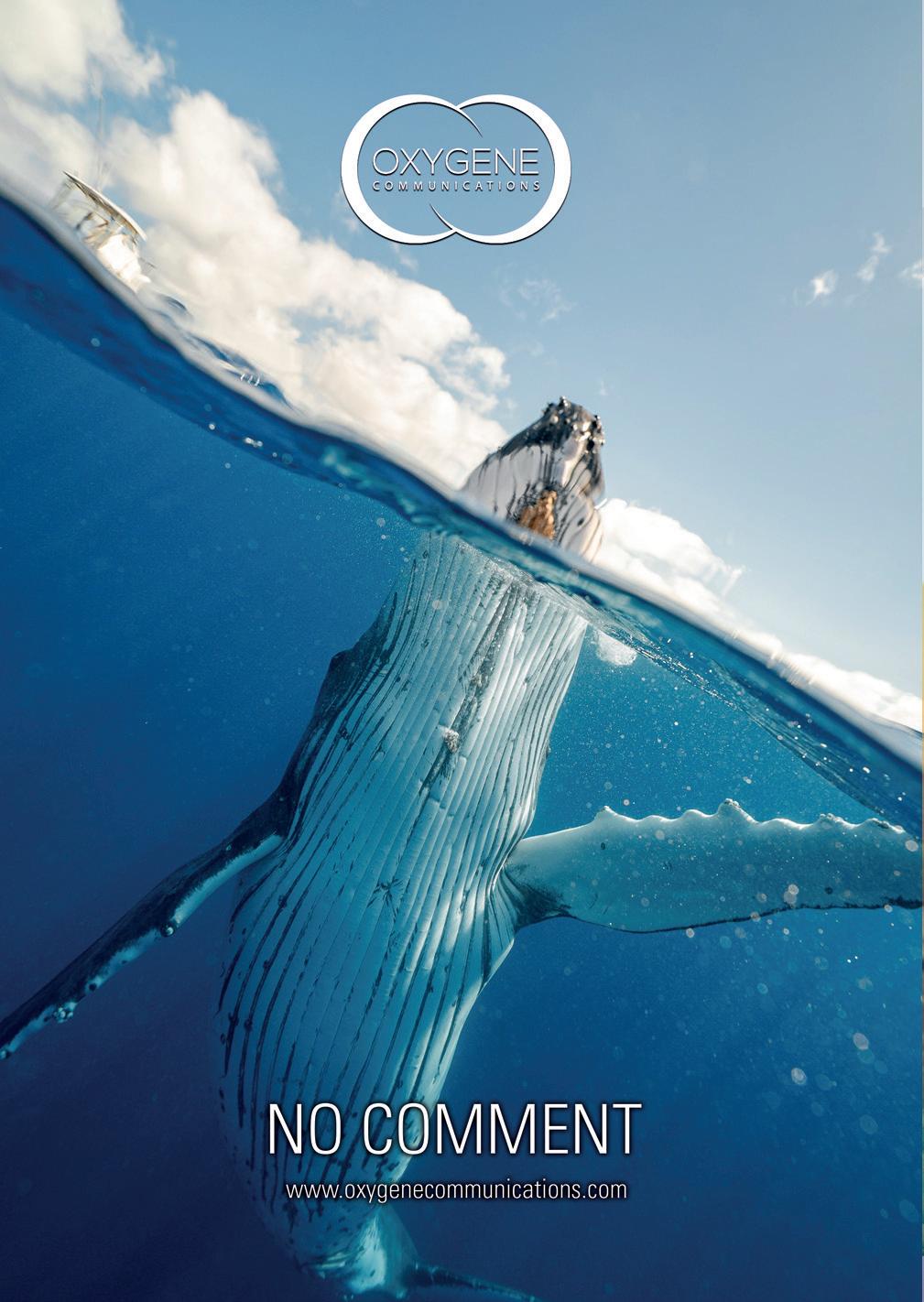
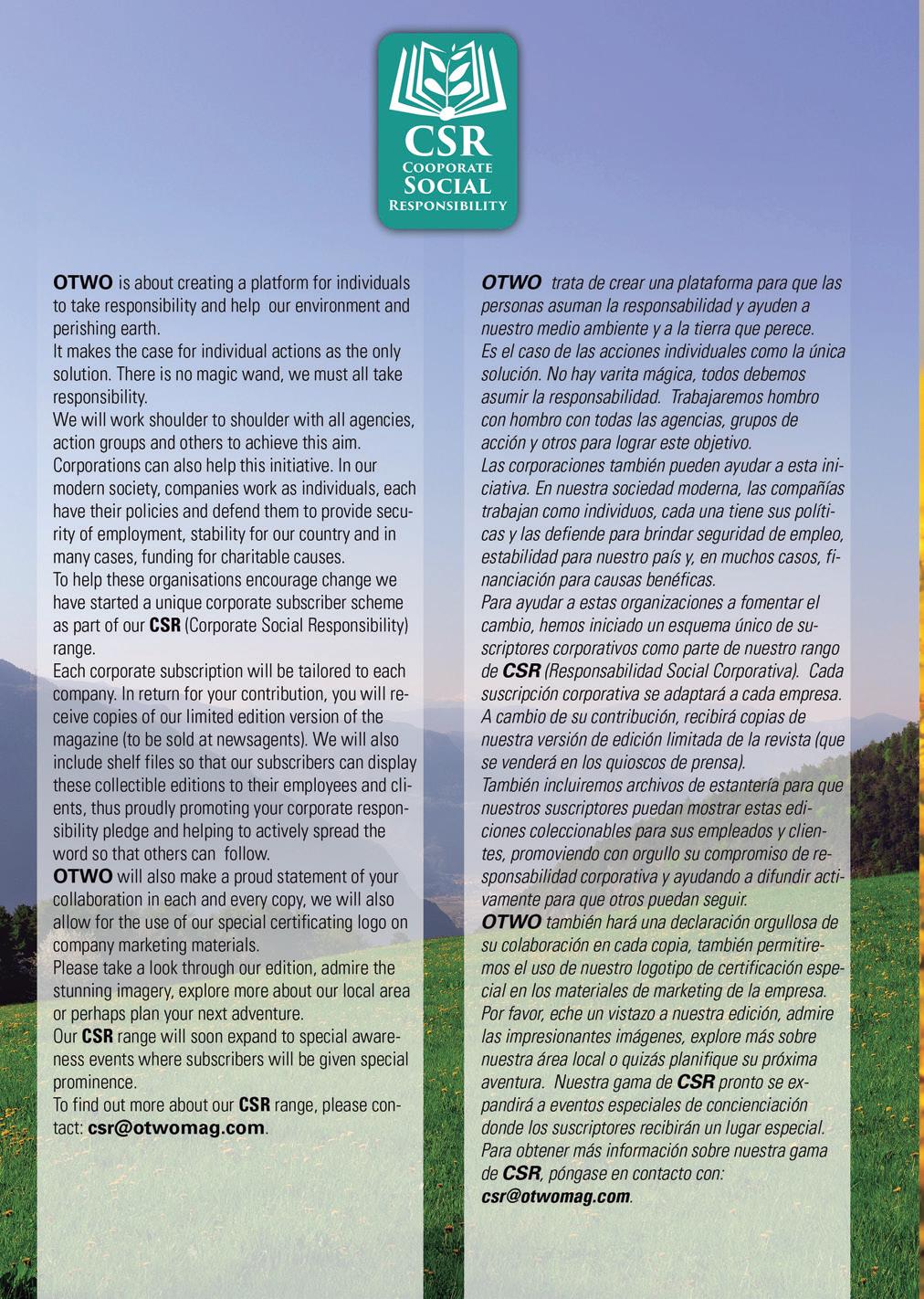

CARPENTRY • MASONRY • GENERAL DECORATION • PLUMBING • ELECTRIC • KITCHENS • BATHROOMS • BEDROOMS
PROFESSIONAL STANDARDS AND BEST PRICES GUARANTEED. REGISTER NOW FOR A NO OBLIGATION ESTIMATE AND RECEIVE A £50 DISCOUNT ON WORKS. WE WILL CALL YOU WHEN LOCK DOWN IS LIFTED : BE THE FIRST AND AVOID THE RUSH!
Admin offices: Suite D 122 Irish Town Call 54083022 or email minorworks@evgib.com
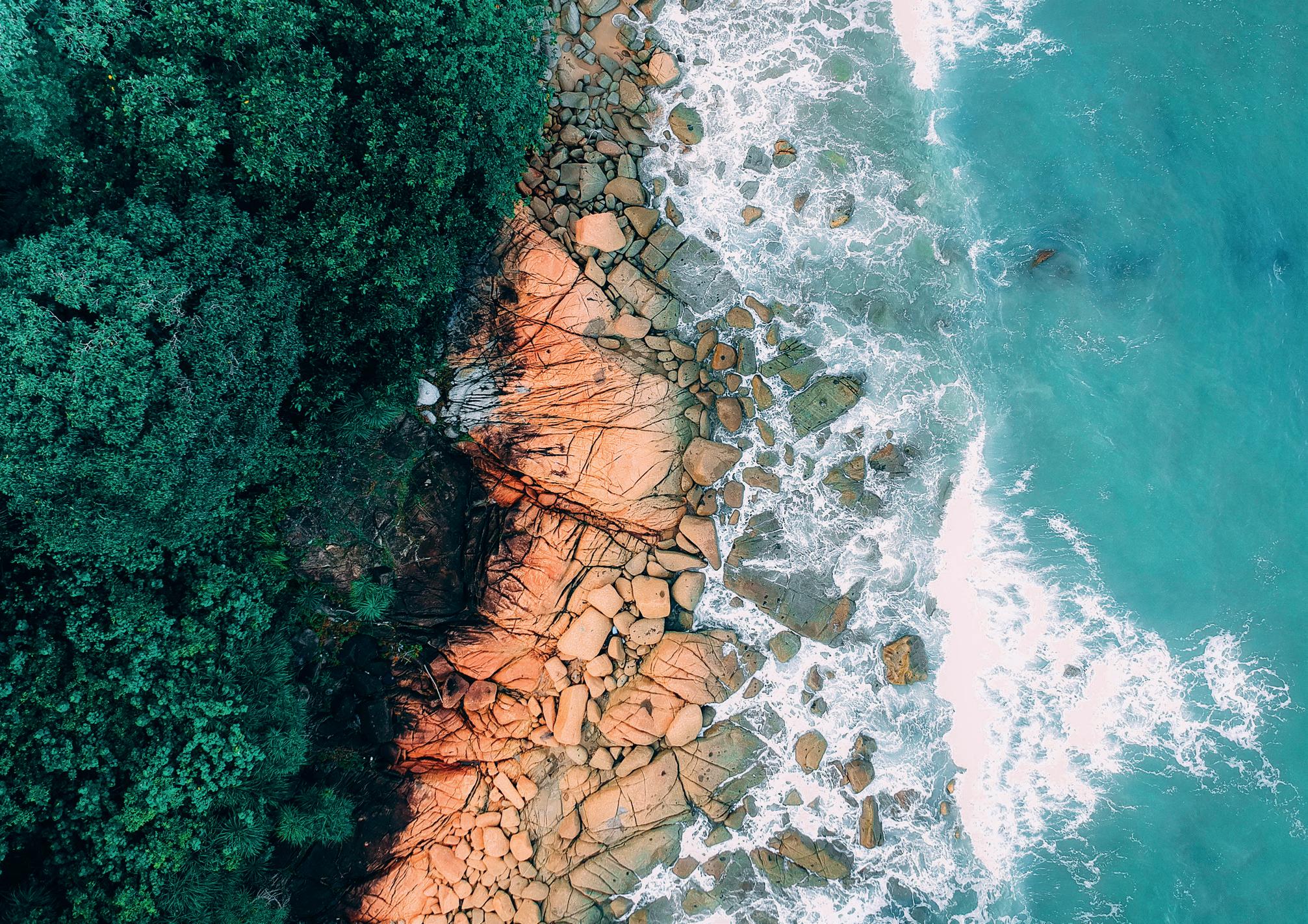
“The breaking of a wave cannot explain the whole sea.” (Vladimir Nabokov).
«El romper de una ola no puede explicar todo el mar.» (Vladimir Nabokov).
PHOTOGRAPHY: PEXELS.COM

“Friendship is a disinterested commerce between equals.” (Oliver Goldsmith).
“La amistad es un tráfico desinteresado entre iguales.” (Oliver Goldsmith).
PHOTOGRAPHY: PEXELS.COM
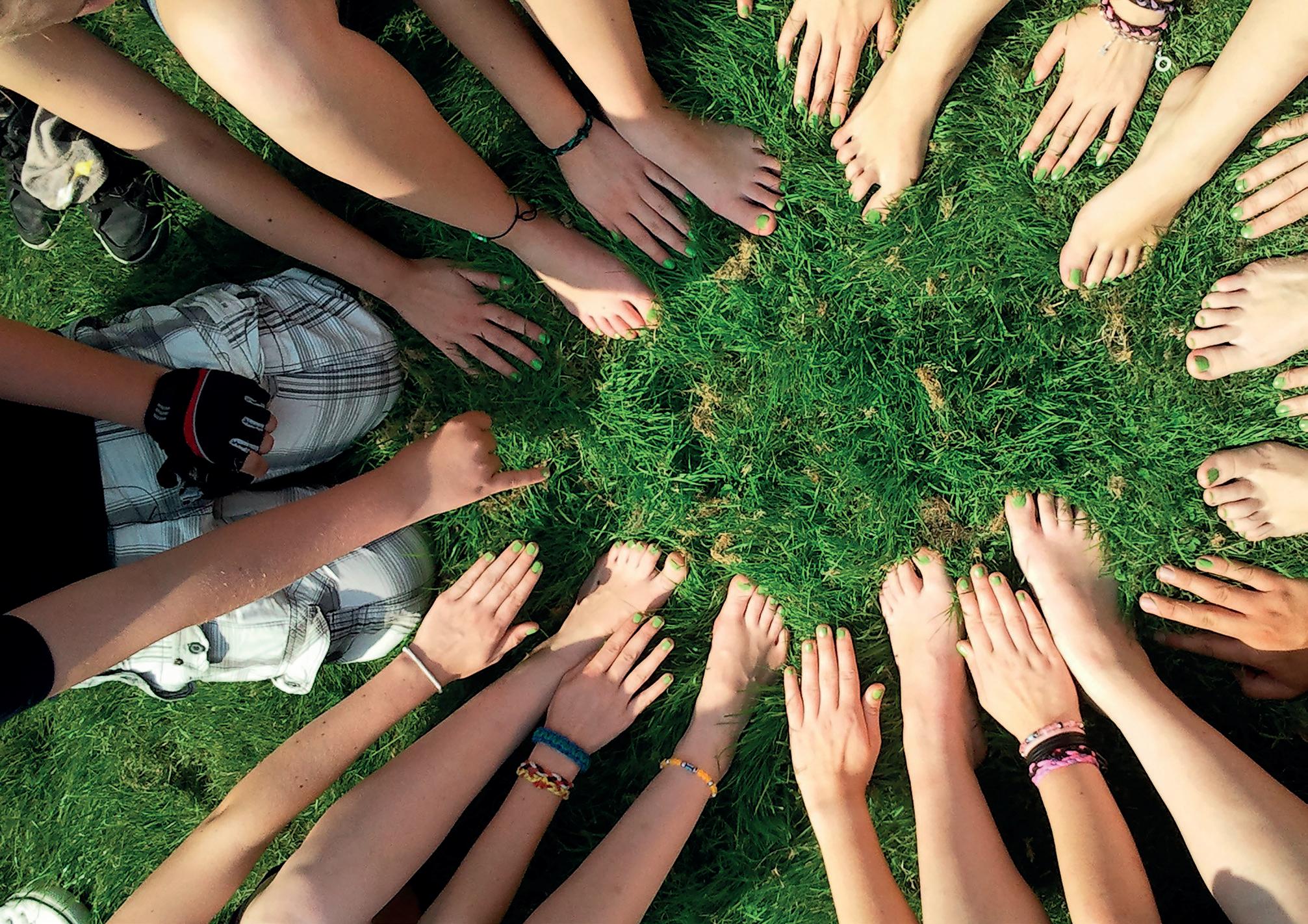
“None of Us is as Good as All of Us.”. (Ray Kroc).
“Ninguno de nosotros es tan bueno como todos nosotros juntos.. (Ray Kroc).
PHOTOGRAPHY: PEXELS.COM

This volume was published in August 2020 by Oxygene Ltd.
OTWO Issue 13
Oxygene Ltd.Business Centre.
19 George´s Lane.
GX11 1AA, Gibraltar Tel. +00350 54080331
www.oxygenecommunications.com
© Publishing: Oxygene Ltd.
Vanessa Byrne

Managing & Commercial Director Juanjo Trujillo
Creative Director & Chief Designer
Sarah Birch
Columnist & Translation
Ana Villalta
Columnist & Translation
Jenny Brown
Design & Social Media
Photographer: Keith Bensusan, Montagu Park & Line Wall Boulevard, Juan Luis González, Pexels, Juan Martín Bermúdez, Antonio Luna, Felipe Muñoz, J. Antonio Gil, EBikes Gibraltar, In2Adventures.
Cover photo: Caio.
Back Cover photo: Elianne Dipp
Translation:
Sarah Birch, Ana Villata and Merlin Gutherless.
Printing:
Santa Teresa Industrias Graficas SA
All rights reserved. No part of this publication may be reproduced, stored in a retrieval system or transmitted in any form or by any means, electronic, mechanical, photocopying, recording or otherwise, without the prior permission in writing from the publishers.
All rights reserved.
Editorial
Collection “The flower of the month”. Colección “La flor del mes”.
Shorts / Cortos.
Eco Passion.
Green Space Planning: Expand, Share & Connect.
Planificación de espacios verdes: Expandir, compartir y conectar
Pinar del Rey. Bahía de Cádiz Natural Park. Parque Natural Bahía de Cádiz.

Interview with Steven Barea: 5G. Entrevista con Steven Barea: 5G.

ESG: EMG Radiation.
ESG: Radiación EMF.
Birds:The sublime conquest of the environment.
Aves: Aves: La sublime conquista el medio.
Narrowing the Strait Estrechando el Estrecho
92


95
Quick Guide to Andalucía. Guía Rápida de Andalucía.


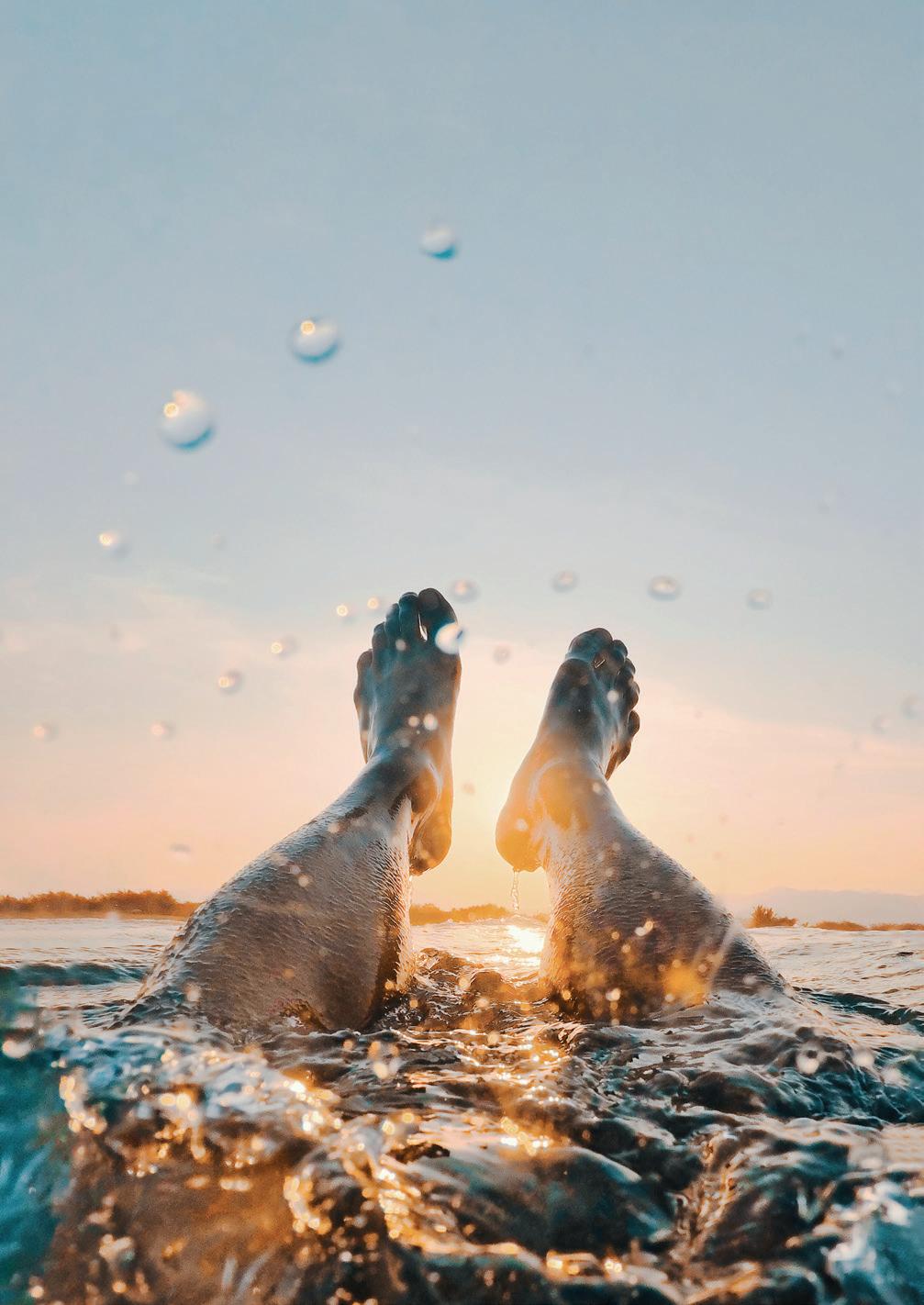
OTWO 13
001
82 68
34
58 48
72
10 26 22 14 12
Experience Catalog
ILLUSTRATION: JUANJO TRUJILLO

A note from the editor
Vanessa Byrne / Managing Director
It’s our 1st year anniversary. On one hand I feel like I’ve been doing this all my life while on the other its incredible how quickly the months fly by.
How much the world has changed in just one year… Yes, unfortunate Covid19 comes to mind when I say this but it’s not all been bad… We have improved our focus to that of sustainability. This is growing month after month and fingers crossed it stays this was until our shared environment is so prominent in minds that it will be the primary consideration when making any major decision. There
Es nuestro primer aniversario. Por un lado, parece que hemos estado haciendo esto toda la vida, mientras que por el otro, es increíble lo rápido que pasan los meses.
Cuánto ha cambiado el mundo en solo un año ... Sí, desafortunado Covid19 me viene a la mente cuando digo esto, pero no todo ha sido malo ... Hemos mejorado nuestro enfoque hacia la sostenibilidad. Esto está creciendo mes tras mes y tengo mis dedos cruzados se mantienen hasta que nuestro entorno compartido sea tan prominente en nuestras
are still many worrying problems but I genuinely believe we will change the world for a better, cleaner and of course more sustainable model.
What we do, we will all do for our future generations because after all, if We don’t do it for them, who will? We nurture them, always want the best for them, give our all, but isn’t the greatest gift we can give our children safety and a better world than we leave behind? At present the world is suffering and it will only get worse if we don’t step up and protect our environment for our children and grandchildren. #noplanetb
We cannot be more grateful for our support this past year, our contributors and collaborators that have been with us from the start and joined us through our first year’s journey. We feel so incredibly blessed to have met such inspiring people along the way and learned so much to change our own lifestyle. We were honored by The Nautilus Project in collaboration with the GFSB with The Sustainability Influencers Award for 2020. Amazing, that’s all I can say and truly reflective of the passion and effort our entire team has dedicated to this project. Proud moment indeed.
Most importantly, from the bottom of my heart I thank you for being a dedicated reader. This first year would not have been possible without you guys. I am incredibly grateful to the entire OTWO team who work tirelessly to bring you this publication month after month. I am truly excited about the future of OTWO and believe the best is yet to come. May thisissue inform, empower and inspire you.
Peace & Love
mentes que será la consideración principal al tomar cualquier decisión importante. Todavía hay muchos problemas preocupantes, pero realmente creo que cambiaremos el mundo por un modelo mejor, más limpio y, por supuesto, más sostenible.
Lo que hacemos, lo haremos todos por nuestras futuras generaciones porque, después de todo, si no lo hacemos por ellos, ¿quién lo hará? Los cuidamos, siempre queremos lo mejor para ellos, lo damos todo, pero ¿no es el mejor regalo que podemos brindarles a nuestros hijos seguridad y un mundo mejor del que dejamos atrás? En la actualidad, el mundo está sufriendo y solo empeorará si no intensificamos y protegemos nuestro medio ambiente para nuestros hijos y nietos. #noplanetb
No podemos estar más agradecidos por vuestro apoyo el año pasado, nuestros colaboradores y contribuyentes que han estado con nosotros desde el principio y se unieron a nosotros durante el viaje de nuestro primer año. Nos sentimos increíblemente bendecidos de haber conocido a personas tan inspiradoras en el camino y de haber aprendido mucho a cambiar nuestro propio estilo de vida. Fuimos honrados por The Nautilus Project en colaboración con GFSB con The Sustainability Influencers Award for 2020. Increíble, eso es todo lo que puedo decir y realmente refleja la pasión y el esfuerzo que todo nuestro equipo ha dedicado a este proyecto. Momento orgulloso e impresionante. Lo más importante, desde el fondo de mi corazón, es lo que te agradezco por ser un lector dedicado. Este primer año no hubiera sido posible sin ustedes. Estoy increíblemente agradecida con todo el equipo de OTWO que trabaja incansablemente para brindarle esta publicación mes tras mes. Estoy realmente entusiasmada con el futuro de OTWO y creo que lo mejor está por venir.

Que OTWO te informe, te dé poder y te inspire. Paz amor
10 OTWO 13 / AUGUST 2020 11


AUGUST / Agosto
Collection “The flower of the month”
Pitahaya Hylocereus undatus
Dr Keith Bensusan Director
Gibraltar Botanic Gardens, The Alameda.
Most of us are familiar with the fruits of the Prickly Pear Opuntia ficus-indica, but other cacti also produce edible fruit. An increasingly popular fruit is that of the Pitahaya, which is known as Dragonfruit. It is frequently seen in markets across the Mediterranean, sometimes including the Public Market in Gibraltar.
The Pitahaya is a more unusual species of cactus, in that it grows as a very large climber or creeper, on the ground, walls or cliffs, or up trees. A particularly fine specimen grows up a large pine tree near the entrance to the Botanic Gardens. The eastern wall of Trafalgar Cemetery is also a very good place to see this cactus, which does very well in Gibraltar’s climate and often dominates areas of wild vegetation when left untended. The Pitahaya blooms at night, when it produces large and spectacular white flowers. Its flowering period in Gibraltar is during the month of August. In the wild, these flowers would be pollinated by species of bats that feed on their nectar. The flowers are short-lived, lasting only a few nights. The species’ original distribution is difficult to ascertain, but it is certainly native to Central America.
Casi todos estamos familiarizados con los higos chumbos que produce la Opuntia ficus-indica, pero hay otros cactus de los que también brota fruta comestible. Un ejemplar de creciente popularidad es la pitahaya, conocida como fruta del dragón. Puede encontrarse con frecuencia en mercados de todo el arco mediterráneo, lo cual a veces incluye el mercado público de Gibraltar.
La pitahaya constituye una variedad inusual de cactus por crecer en una enredadera de gran tamaño que trepa muros, acantilados o árboles. Un ejemplar especialmente bonito se encuentra en un pino de gran altura a la entrada de los jardines botánicos. El muro oriental del cementerio de Trafalgar constituye otro muy buen enclave para ver este cactus, que está muy habituado al clima gibraltareño y suele predominar en las zonas de vegetación salvaje desatendida. La pitahaya florece de noche, cuando de ella brotan flores blancas espectaculares de gran tamaño. Florece en el mes de agosto. En un entorno totalmente natural, diferentes especies de murciélagos polinizan esta flor tras alimentarse de su néctar. Las flores son de vida corta y apenas duran unas cuantas noches. La distribución original de esta especie es difícil de identificar, pero se sabe a ciencia cierta que es autóctona de Centroamérica.
Pitahaya Hylocereus undatus
Photography: Brocken Inaglory

THE SECOND ANNUAL SUSTAINABLE BUSINESS AWARDS



The Second Annual Nautilus Project Sustainable Business Awards, in collaboration with the Gibraltar Federation of Small Businesses, took place in midJuly, praising local businesses for effecting green initiatives in the workplace.
The awards were presented by Minister for Environment Dr John Cortes together with Eran Shay from GFSB and Lewis Stagnetto from the Nautilus Project.
Earlier this year, companies in Gibraltar were invited to submit a presentation under the theme ‘New Decade, New Habits’, outlining their commitment to sustainability with a focus on green initiatives implemented over the past year.
Throughout the evening, a total of 9 awards were handed out to local businesses that demonstrated outstanding green credentials, with Hassan’s Law Firm awarded the main prize - The Sustainable Business Award 2020.
Marking nearly one year since its first publication, OTWO Magazine is honoured to have received the Sustainability Influencers Award.
The other organisations selected for their outstanding green credentials were; Gibbeau, with the Award for Innovation; Eroski Centre Gibraltar as Green Business Leaders; Alameda Wildlife Conservation Park for Environmental Stewardship; Europa FC won the Sustainability Team of the Year award; Playtech won the Daring to be Greener Award; SM Seruya received the Sustainability Vision Award and the Rotary Club of Gibraltar obtained the Green Beacon Award.
OTWO would like to thank the Nautilus Project and GFSB for the award and for promoting sustainability within business and congratulate all the winners for their commitment to green initiatives.
Segunda edición de los premios al desarrollo sostenible en empresas
La segunda edición de los Premios del Proyecto Nautilus al Desarrollo Sostenible en Empresas, en colaboración con la Federación de Pequeñas Empresas de Gibraltar, tuvo lugar a mediados de julio y sirvió para reconocer la implantación de iniciativas ecológicas por parte de empresas locales en los lugares de trabajo.
Los premios fueron presentados por el ministro de
Medio Ambiente, John Cortes, junto a Eran Shay de la GFSB y Lewis Stagnetto del Nautilus Project.
Con anterioridad, las empresas gibraltareñas habían sido invitadas a enviar una presentación bajo el título ‘Nueva década, nuevos hábitos’ en la que mostraran su compromiso con la sostenibilidad enfocado a las iniciativas ecológicas adoptadas durante el año anterior.
A lo largo de la velada se entregaron un total de 9 premios a empresas locales que habían demostrado credenciales ecologistas sobresalientes, recibiendo el bufete de abogados Hassan el premio principal: el Premio a la Empresa Sostenible 2020.
Cumpliendo casi un año desde la publicación de su primer ejemplar, OTWO Magazine tiene el honor de haber recibido el Premio a la Influencia en Sostenibilidad.
Las demás organizaciones elegidas en base a sus credenciales ecológicas fueron Gibbeau, ganadora del Premio a la Innovación; Eroski Centre Gibraltar como Empresa Líder en Ecologismo; el Parque de Conservación Alameda por su Administración Medioambiental; Europa FC como Equipo Sostenible del Año; Playtech el del Empeño por ser más Ecologistas; SM Seruya por la Visión de Sostenibilidad y el Rotary Club como Faro Verde.
OTWO quiere mostrar su agradecimiento al Nautilus Project y a la GFSB por el premio recibido así como por promover la sostenibilidad en el marco empresarial. También queremos felicitar a todos los ganadores por su compromiso para con las iniciativas ecológicas.

SIBERIAN HEATWAVE ‘ALMOST IMPOSSIBLE’ WITHOUT HUMAN-MADE CLIMATE CHANGE
The heatwave in Siberia that saw temperatures soar to 5C above average and reaching a scorching 38C in some areas would have been ‘effectively impossible’ without human-made climate change, scientists have found.
Since the beginning of 2020, record-breaking temperatures have caused severe wildfires in the region, pumping millions of tonnes of CO2 into the atmosphere. It has also accelerated the melting of permafrost, resulting in an oil tanker stationed on frozen ground to collapse, leading to one of the regions worst-ever oil-spills.
Leading researchers from around the world, including scientists from Oxford University, used a previously used research method called attribution science to create computer simulations that compare the current climate (which is around 1C warmer than the preindustrial era) to a model that generates temperatures as they would have been without human influence.
They concluded that the current temperature anomalies could only occur once in every 80,000 years, making it almost impossible for these extreme heatwaves in the Arctic region to happen without human-made greenhouse gas emissions. They also found that CO2 pollution has made these extreme weather events 600 times more likely to occur.
Global average temperatures have been rising year on year for the last five years, with 2020 set to become the hottest year yet. The poles, however, are warming at an accelerated rate. Earlier this year, Antarctica saw record-breaking temperatures, with some areas reaching 20C.
The climate in the Arctic has a global reach, affecting weather patterns and circulation around the world. If temperatures in the region continue to increase, extreme weather events could become more frequent.
La ola de calor en Siberia sería “casi imposible” sin el cambio climático provocado por el hombre
La ola de calor en Siberia, con el aumento de las temperaturas en 5 grados centígrados respecto a la media y llegando a 38 grados en algunas zonas habría resultado “imposible de facto” de no haber mediado el cambio climático provocado por el hombre, según han manifestado algunos científicos.
Desde comienzos de año, los registros históricos en las temperaturas han causado incendios severos en la zona, emitiendo millones de toneladas de CO2 a la atmósfera. También ha acelerado el derretimiento del permafrost, provocando que un buque petrolero fondeado sobre el hielo colapsara y diera pie a uno de los mayores vertidos petrolíferos vividos en la zona.
Investigadores prominentes de todo el mundo, incluyendo científicos de la Universidad de Oxford,
14 OTWO 13 / AUGUST 2020 OTWO 13 / AUGUST 2020 15
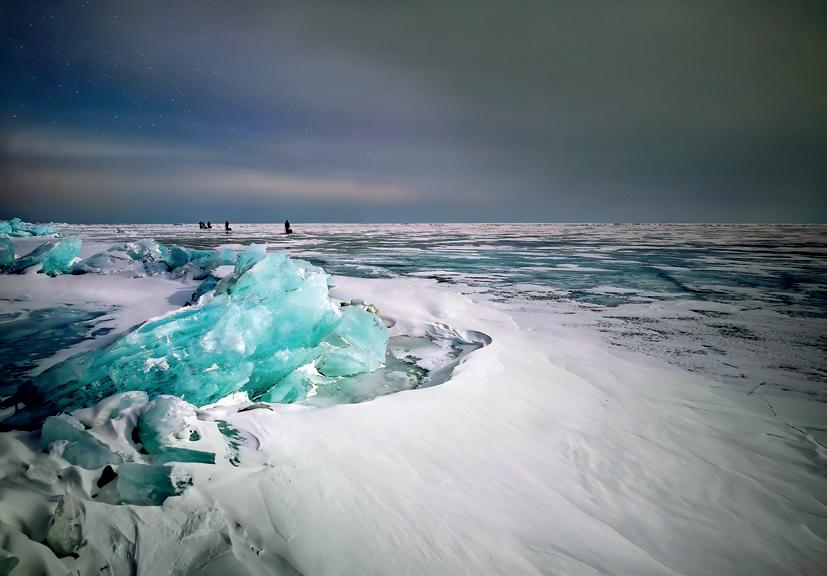
hicieron uso de un método empleado anteriormente, denominado ciencia atributiva, para crear simulaciones por ordenador que comparasen el clima actual (que es 1 grado centígrado más alto que el existente en la era preindustrial) con un modelo que genera las temperaturas que se habrían dado sin la influencia del hombre.
Concluyeron que las anomalías actuales sólo podrían darse una vez cada 80.000 años, de modo que resultaría casi imposible que las olas de calor extremo en la región ártica se estuviesen produciendo sin el detonante de las emisiones de gas invernadero producidas por los humanos. Descubrieron asimismo que la contaminación por CO2 ha motivado que la probabilidad de estos patrones meteorológicos se multiplique por 600.
Las temperaturas medias han crecido cada año durante el último lustro, con 2020 siendo el curso que marcará los registros más altos hasta la fecha. Los polos se están calentando a una velocidad acelerada. En el primer tramo de este año la Antártica experimentó registros históricos de temperatura, con algunas zonas alcanzando los 20 grados.
El clima ártico tiene impacto global y afecta a los patrones meteorológicos de todo el mundo. De seguir creciendo las temperaturas en esta región, los sucesos de causa meteorológica se podrían hacer más frecuentes.
THE CITY OF SYDNEY GOES 100% RENEWABLE
As of July, the centre of Australia’s largest city, Sydney, will be powered by 100% renewable energy, which is forecast to save the city an estimated half a million dollars a year in energy bills and cut CO2 emissions by around 20,000 tonnes each year.
The clean energy will be sourced from local solar and wind farms in New South Wales to power the CBD (Central Business District) as well as inner-city residential areas. Solar panels have also been installed on several municipal buildings, with an aim to increase these to more than 7800 solar panels by 2021.
All the city’s operations including 23,000 street lamps, 75 parks, 115 buildings, several sports faci-
lities and the historic town hall will run exclusively from renewables. This historic deal is the biggest green energy agreement made by any council across the whole of Australia, valued at almost 60 million dollars.
Cities consume around two-thirds of the world’s energy and produce 70% of global CO2 emissions. However, more and more cities are turning to renewables to cut their greenhouse gas emissions with over 100 cities including Auckland, Nairobi, Oslo, Seattle, and Vancouver sourcing at least 70% of their energy from solar, geothermal, wind and hydropower.
The City of Sydney achieved carbon neutrality in 2007 with a target of reducing emissions by 70% by 2030, but thanks to this historic green energy agreement, they are now set to achieve this goal by 2024.
La ciudad de Sídney se vuelve 100% renovable
A partir de julio, el centro de Sídney, la mayor ciudad de Australia, se suministra de energía 100%
renovable, una medida encaminada al ahorro de medio millón de dólares en facturas de electricidad y a reducir las emisiones de CO2 en unas 20.000 toneladas al año.
La energía limpia provendrá de parques eólicos y de energía solar en Nueva Gales del Sur que la suministrarán al CBD (Distrito Central de Negocios) y a las zonas residenciales del centro. Multitud de paneles solares han sido instalados en edificios locales y para el 2021 el número de los mismos aumentará en otras 7.800 unidades.
Las energías renovables serán el suministro de toda la actividad energética, incluyendo 23.000 farolas, 75 parques, 115 edificios, varias instalaciones deportivas y el histórico ayuntamiento. Esta medida histórica constituye la mayor iniciativa ecológica llevada jamás a cabo por cualquier institución en el país australiano y su coste ronda los 60 millones de dólares.
Las ciudades consumen alrededor de dos tercios de la energía mundial y producen un 70% de las emisiones de CO2. No obstante, cada vez más ciudades están cambiando hacia las renovables para


OTWO 13 / AUGUST 2020 17 16 OTWO 13 / AUGUST 2020
reducir sus emisiones de gas invernadero. Más de cien municipios, incluyendo Auckland, Nairobi, Oslo, Seattle y Vancouver se abastecen de energías solar, geotérmica, eólica e hidráulica en al menos un 70%.
La ciudad de Sídney alcanzó la neutralidad de carbono en 2007 con el objetivo de reducir las emisiones en un 70% para el año 2030, pero en virtud de este histórico movimiento ecológico, está en la perspectiva de alcanzar su objetivo en 2024.

LARGEST EVER OCEAN CLEAN-UP COLLECTS RECORD AMOUNT OF PLASTIC
After 48 days at sea, the Ocean Voyages Institute returned to Hawaii in early July after successfully removing 103 tonnes of toxic plastic waste and fishing nets from the Great Pacific Garbage Patch, setting a record for the largest amount of plastic ever collected from the open ocean.
This more than doubles the 48 tonnes of plastic consumer waste OVI collected during a 25-day expedition in 2019.
Ocean Voyages Institute is a San Francisco based non-profit organisation founded in 1979, with a mission of teaching maritime arts and sciences and preserving the world’s oceans. In 2009, they launched Project Kasei to raise awareness of marine debris and to organise ocean cleanups.
Since 2018, the team has been using GPS trackers, drones and mast lookouts to study how waste travels and accumulates in the Great Pacific Garbage Patch as well as to locate large ghosts nets that can be extremely harmful to marine life, particularly to large marine animals such as dolphins, whales and turtles.
The Great Pacific Garbage Patch is the largest collection of marine debris in the world and spans from the West Coast of North America to Japan. It is estimated to contain 87,000 metric tonnes of plastic, 94% of which are microplastics.
Once the OVI team returned to Honolulu, they ensured that all the plastic waste and netting they had grown was sent to recycling companies to be turned into insulation, energy and other goods.
The team will be conducting several more expeditions this year and hope that they can expand their fleet to 3-4 ships in 2021. In the long term,
they plan to expand their cleanups to other parts of the world.
La mayor actividad de limpieza oceánica produce un récord en la recolección de plástico
Tras 48 días en el mar, el Ocean Voyages Institute retornó a Hawái a principios de julio después de haber conseguido retirar 103 toneladas de residuos plásticos tóxicos y redes de pesca del Gran Parche de Basura del Pacífico, estableciendo una cantidad récord en cuanto a la recogida de plásticos en mar abierto.
El registro es más del doble que el de las 48 toneladas de residuos post-consumo recogidas por OVI durante una expedición de 25 días llevada a cabo en 2019.
Ocean Voyages Institute es una organización sin ánimo de lucro de San Francisco, fundada en 1979 y con el objetivo de enseñar artes y ciencias del mar y proteger los océanos del mundo. En 2009 lanzaron el Proyecto Kasei para concienciar sobre los desechos marinos y organizar expediciones para la limpieza del mar.
El equipo usa rastreadores GPS desde 2018 así como drones y vigías en mástil para estudiar cómo se mueven y acumulan los residuos en el Gran Parche de Basura del Pacífico así como para localizar las grandes redes fantasma que pueden resultar extremadamente nocivas para la vida marina, especialmente para los animales de gran tamaño como los delfines, las ballenas y las tortugas.
El Gran Parche de Basura del Pacífico reúne la mayor cantidad de desechos marinos del mundo y abarca desde la costa oeste norteamericana hasta Japón. Se calcula que contiene 87.000 toneladas métricas de plástico, el 94% de las cuales son microplásticos.
Tras regresar a Honolulu, el equipo de OVI se aseguró de que los residuos plásticos y las redes recogidas fuesen enviados a empresas de reciclaje de cara a transformarlas en aislantes, energía y otros productos.
El equipo llevará a cabo varias expediciones más este año y espera poder aumentar su flota en 3 o 4 embarcaciones en 2021. Al largo plazo, tienen la intención de realizar expediciones de limpieza en otras partes del mundo.

18 OTWO 13 / AUGUST 2020
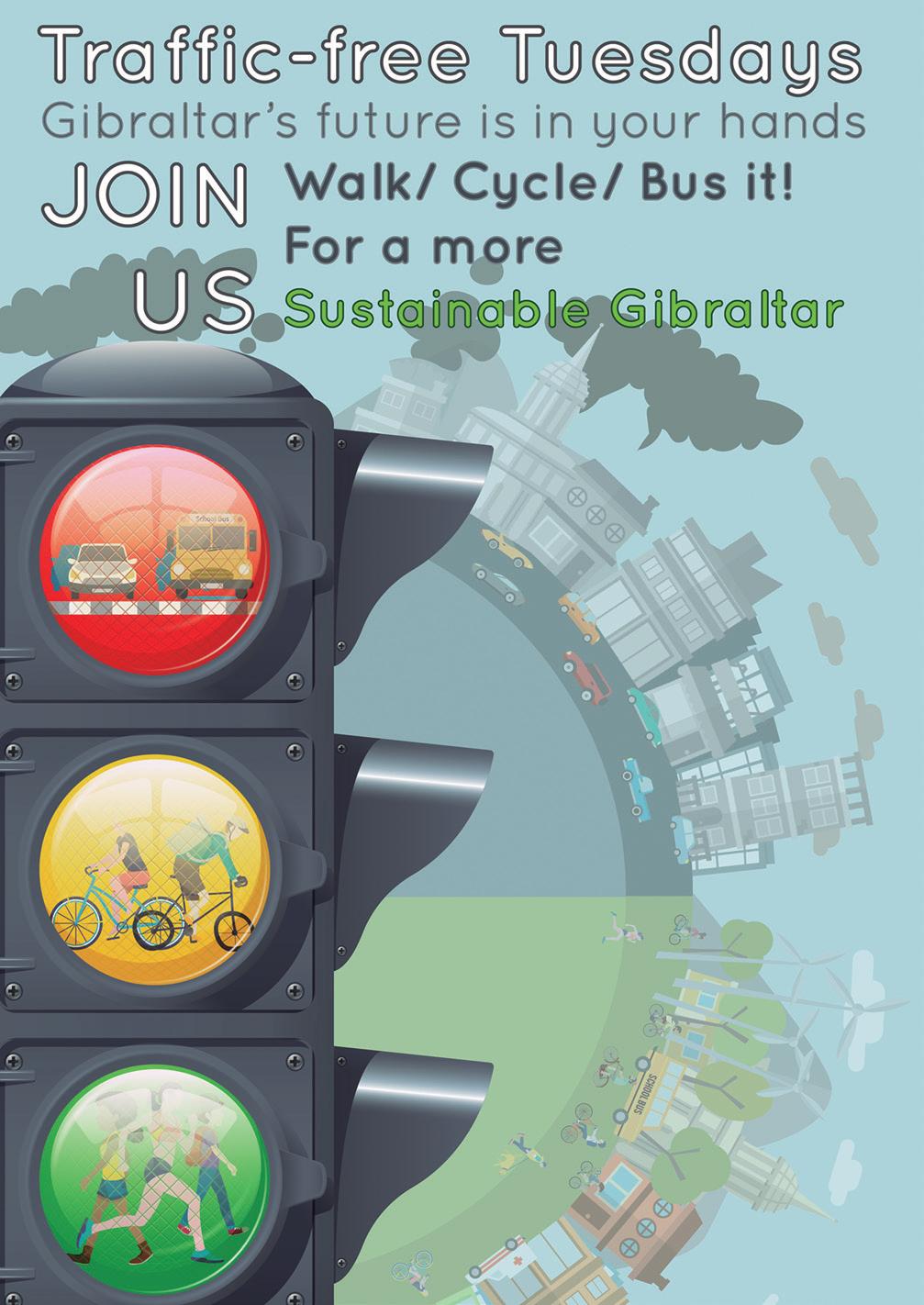


Soap ShampooNut Bars
Champú en pastillas de jabón

Our new range of solid shampoo bars from Living Naturally, UK, are suitable for hair, face, hands and body, they are SLS free and palm oil free, vegan, organic, zero waste and plastic-free: The perfect addition to your plastic-free bathroom and zero waste personal care routine.
We offer two fragrances: Hemp & Patchouli and Lemon & Avocado. They are 90g bars that come packaged in a small cotton bag. Both fragrances contain soap nuts and will gently cleanse without stripping your hair of moisture.
The Hemp & Patchouli bar suits thick, curly or dry hair and skin prone to dryness or inflammation. The organic hemp oil conditions your hair and scalp with its high content of vitamin E. Hemp oil is a natural moisturiser that is soothing and will help to prevent irritation and dryness. This shampoo bar is great for winter because it combats the cold, damaging outdoor air. The other active ingredient, cayenne pepper, is known to promote hair growth because it has a stimulatory effect on the scalp. It also helps with adding shine to lifeless hair.
The Avocado & Lemon bar will moisturize dry, bri-

dañinos en el cabello. El otro ingrediente activo, la pimienta de cayena, favorece el crecimiento del cabello al tratarse de un estimulador del cuero cabelludo, a la vez que añade brillo al cabello dañado. La barra de aguacate y limón, hidrata el cabello seco, quebradizo y dañado, añadiendo iluminación y brillo. Las vitaminas, los aminoácidos y el alto contenido en grasa natural, estimulan el crecimiento celular saludable y son ideales para mantener y curar cuero cabelludo seco, disminuyendo su picazón. La barra está perfumada con Limón, May Chang & Ylang que equilibran y controlan el exceso de grasa, rejuveneciendo el cabello al que dotan de una fragancia muy estimulante.
Nuestra nueva gama de barras de champú sólidas de Living Naturally, Reino Unido, son adecuadas para el cabello, la cara, las manos y el cuerpo, son libres de SLS y sin aceite de palma. Son veganos, orgánicos, sin residuos y sin plástico: el complemento perfecto para un aseo libre de plásticos que permite una rutina de aseo con residuos Cero.
Ofrecemos dos fragancias: Una de cáñamo/pachulí y el segundo limón/aguacate. La presentación es en una pastilla de 90gr, envueltas en una pequeña bolsa de algodón. Son barras de 90 g que vienen empaquetadas en una pequeña bolsa de algodón. Ambas fragancias contienen nueces de jabón, proporcionando una limpieza suave sin resecar el cabello. La barra de cáñamo y pachulí se adapta al cabello más espeso, rizado o seco y a la piel propensa a la sequedad o la irritación. El aceite de cáñamo orgánico acondiciona el cabello y cuero cabelludo por su elevado contenido en vitamina E. El aceite de cáñamo, proporciona hidratación natural a la vez que calma y previene la irritación y la sequedad. Este champú es ideal para el invierno porque combate el frío, evitando que el aire frío nos produzca efectos
ttle and damaged hair, adding shine. The vitamins, amino acids, and high fat content promote healthy cell growth and are great for maintaining and healing dry, itchy scalps. The bar is fragranced with Lemon, May Chang & Ylang which are balancing and will control excess oil production, as well as being rejuvenating with a very uplifting fragrance.
If you are used to using normal commercial shampoo, you will notice that the second wash produces a lot more lather. The first wash is mixing with the dirt and excess oil in your hair so the second wash is working on cleaner hair. The same is true for shampoo bars, so lather up once or twice, but do make sure to rinse well each time. We also recommend a rinse of apple cider vinegar, especially if you are in the transition from commercial shampoo to solid shampoo.
To prolong the life of your soap, don’t leave it in a soap dish to get soggy, or in an area where water is constantly flowing. Allow the bar to dry in between uses.
For more details visit us on: www.ecopassion.es.
Si está acostumbrado a utilizar cualquier champú comercializado actualmente, notará que es el segundo jabonado, el que produce mucha más espuma. El primer lavado, se mezcla con la suciedad y el exceso de aceite en el cabello y es la segunda acción la que produce los efectos, al trabajar en un cabello aseado y aclarado. Lo mismo ocurre con las pastillas de champú. Debe realizar dos enjabonados, realizando un enjuague correcto en cada lavado. Nosotros recomendamos un aclarado con vinagre de manzana, sobre todo, si se encuentra en la transición del champú comercial al champú natural en pastilla.
Para alargar la vida de su pastilla de champú, no lo deje en la jabonera donde permanecerá empapado ni cerca del grifo o ducha. Permita que la pastilla seque de forma correcta entre cada uso.
Si desea conocer más detalles, visítenos en: www.ecopassion.es.

23 22
OTWO 13 / AUGUST 2020 OTWO 13 / AUGUST 2020


By investing in the Trust you are Investing in Gibraltar’s past, its present and its future
When you take out an annual membership, you support Gibraltar and the work that the Trust does to protect and enhance it however, your membership also entitles you to:
• Access to the Trust’s monthly programme of events, including trips and organized excursions.
• Access, by appointment, to the Trust’s reference library of books related to Gibraltar and its past (The Trust is accepting donations of books on Gibraltar to add to this resource).
• Free entry to the Gibraltar Museum.
• Annual Report, our regular e-newsletter direct to your inbox, updates and information on what’s happening on the Gibraltar heritage scene.
HAZTE MIEMBRO HOY
Si colabora por el Patrimonio, usted está invirtiendo en el pasado de Gibraltar, su presente y su futuro.
Siendo miembro durante un año, apoya a Gibraltar y el trabajo que Patrimonio hace para protegerlo y mejorarlo. Además, también le da derecho a:
• Acceso al programa mensual de eventos, incluidos viajes y excursiones organizadas.
• Acceder, con cita previa, a la biblioteca para consultar los libros relacionados con Gibraltar y su pasado (nuestro fondo bibliográfico crece día a día gracias a las donaciones que recibimos).
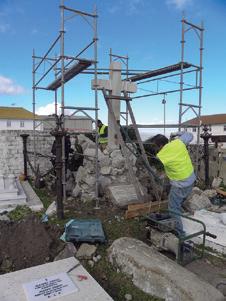
• Free Cable Car Travel from 1st September 2019 to 31st March, 2020 (not to be used before 4pm until 1st November 2019).
• Discounts at the Gibraltar Heritage Trust Shop on our own publications.
• 10% Discount when purchasing 500g of coffee beans from Sacarello’s Coffee Shop
Visit our Website www.gibraltarheritagetrust. org.gi and click on the JOIN US button.
• Entrada gratuita al Museo de Gibraltar.
• También recibirá el Informe Anual y nuestro boletín electrónico enviado regularmente por correo electrónico, actualizaciones e información sobre lo que está sucediendo en la escena del patrimonio de Gibraltar.
• Viaje gratuito en el teleférico desde el 1 de septiembre de 2019 hasta el 31 de marzo de 2020 (no se utilizará antes de las 4 de la tarde hasta el 1 de noviembre de 2019).
• Descuentos de nuestras publicaciones en la tienda Gibraltar Heritage.
• 10% de descuento en la compra de 500 g de granos de café en la cafetería de Sacarello´s Coffee Shop.
Visite nuestro sitio web: www.gibraltarheritagetrust.org.gi y haga clic en el botón JOIN US.
OTWO 13 / AUGUST 2020 25
Green Space Planning: Expand, Share & Connect

Global urbanisation has increased pressures on ecosystems, in particular ones located within cities, resulting in their loss and fragmentation, which is evident through the reduction of green spaces, habitat fragmentation, pollution and contamination of natural environments, as well as decline of biodiversity.
Green infrastructure, that is the development and use of natural vegetative systems or green technologies that replicate ecosystem functions for environmental, economic, and social benefits, offers urban cities and communities a multitude of advantages and significant value, as cities face the impending threats of climate change. Green infrastructure investments are becoming increasingly necessary to
La edificación mundial ha aumentado la presión sobre los ecosistemas, en particular los situados dentro de las ciudades, implicando la pérdida y fragmentación del mismo, poniendo de manifiesto la reducción de los espacios verdes, la división del hábitat, la contaminación y la corrupción de los entornos naturales, así como la disminución de la biodiversidad.
La infraestructura verde, es decir, el desarrollo y uso de sistemas vegetales naturales o tecnologías verdes que reproducen las funciones del ecosistema para obtener beneficios ambientales, económicos y sociales, ofrece a las ciudades y comunidades urbanas multitud de ventajas y valores característicos y relevantes, dado que las ciudades
improve urban resiliency and keep cities safe and liveable, thus remaining fundamental to building and maintaining sustainable cities by protecting cities from climate change risks, improving physical health outcomes, encouraging social cohesion among communities, enriching the quality of life for all people living in cities, thus improving their physical and psychological health, whilst making our cities and neighbourhoods more attractive places to live, visit and work. Components of urban ecosystems offer potential for improvements in water retention and purification, mitigation of the urban heat island effect, the creation of biodiversity hotspots, whilst bringing health and well-being benefits, improvements of local air quality, increases in physical acti-
se enfrentan a las inminentes amenazas del cambio climático.
Las inversiones en infraestructuras sostenibles, son cada vez más necesarias para mejorar la resiliencia urbana y mantener las ciudades seguras y habitables, siendo fundamentales para construir y mantener ciudades sostenibles, que las proteja de los riesgos del cambio climático, mientras mejoran la vida saludable, se fomenta la cohesión social, se enriquece la calidad de vida de sus habitantes con una proyección de su salud física y psíquica al tiempo que permite que nuestras ciudades y barriadas, sean lugares más atractivos para vivir, visitar y trabajar. Los nuevos recursos urbanos permiten potenciar y mejorar el almacenamiento y
26 OTWO 13 / AUGUST 2020 OTWO 13 / AUGUST 2020 27
Planificación de espacios verdes: Expandir, compartir y conectar
Text: Planning Vision

vity, improvements in mental health and a decrease of stress levels.
The recently published concept for ‘Montagu Park’ and the Line ‘Wall Boulevard’ relating to the vision for the improvements to Line Wall Road and the area of Chatham Counterguard, Montagu Curtain and Fish Market Lane, seeks to convey the Government’s commitment to delivering a greener, child friendly Gibraltar and in principle, due to its nature, the proposal is expected to bring improvements and benefits to some extent.
Understanding the importance of applying Sustainable Development Goals (SDGs) within individual projects from the very outset is critical and so is awareness of the fact that success in achieving targets set under one goal, is also applicable to many of the other SDG goals due to linkages and synergies between multiple targets of SDGs.
As the SDGs are regarded as a ‘Think Global -Act Local Approach’, ensuring that the goals are relevant at the project level is essential. A FIVESTEP approach to ensuring that the SDGs are relevant in any local project should be applied from the outset
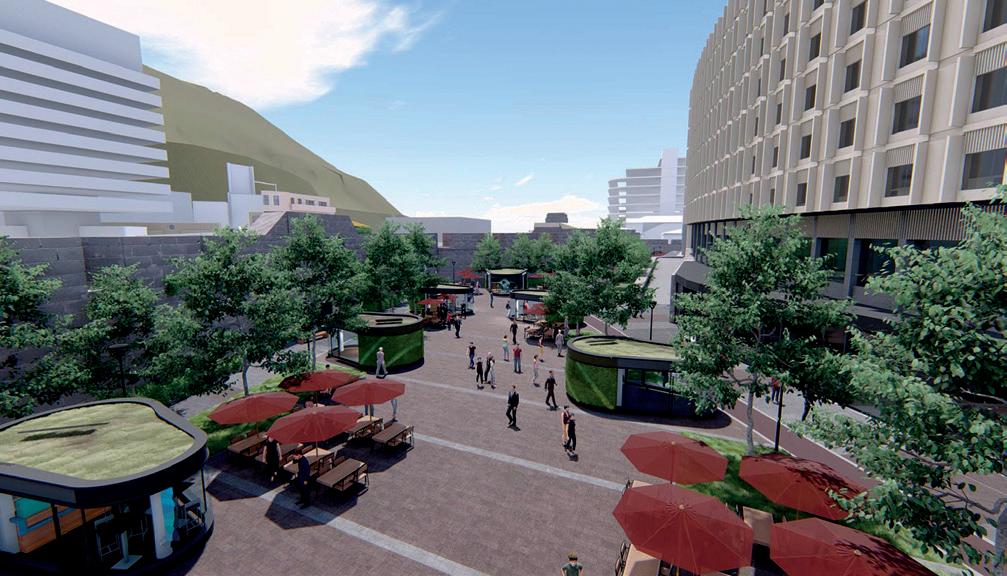
la depuración de agua, mitigar las islas de excesivo calor urbanita, la creación de puntos decisivos de biodiversidad, al tiempo que aportan beneficios para la salud y el bienestar, mejorando la calidad del aire local, pudiendo aumentar la actividad física, propiciar mejoras en la salud mental y disminuir los niveles de estrés.
El concepto recientemente publicado para “Montagu Park” y la línea ‘Wall Boulevard’ en relación con la visión de las mejoras a Line Wall Road y la zona de Chatham Counterguard, Montagu Curtain y Fish Market Lane, busca transmitir el compromiso del Gobierno gibraltareño, fomentando un entorno más ecológico, acogedor para los niños y, se espera, que la propuesta traiga mejoras y beneficios, dada su idiosincrasia.
La importancia de aplicar cada proyecto de los Objetivos de Desarrollo Sostenible (ODS) desde el principio, es fundamental. Hay que tomar conciencia de que el éxito en el logro de los objetivos fijados es también aplicable a cada uno de los muchos Objetivos de Desarrollo Sostenible, dado los vínculos y sinergias existentes entre las múltiples metas
in order to determine whether it is in fact desirable and worthwhile to pursue, as although in principle we expect that proposed project will result in ‘vast benefits’ and ‘significant improvements’, until we follow the necessary steps outlined below, these benefits and their degree, as well as the extent of predicted impact are merely assumed and so is the understanding of the linkages between multiple targets of SDGs with limited at best awareness of trade-offs (negative synergies).
The FIVESTEP Approach
Step 1: Identify and Involve Relevant Stakeholders
Step 1 is similar to many initial stages in project management, whereby the key point is to ensure that the interests of all relevant stakeholders within the project area are taken into consideration, as their interests can contribute positively to improving the sustainability outcome of the project, as all stakeholders of a project are important, with a stakeholder analysis being a recognised method. They are an asset providing information and knowledge that can
establecidas en ellos.
Debido a que los ODS se consideran, “un enfoque global de acción y pensamiento”, es imprescindible asegurar que los objetivos sean relevantes a nivel de proyecto general. Un planteamiento en cinco etapas que asegure la atención de los ODS en cualquier proyecto local, asegurando su aplicación desde un principio para determinar si merece la pena seguirlo por deseable, dado que si esperamos que el proyecto propuesto dé lugar a “grandes beneficios” y “mejoras significativas”, hasta que no se sigan los pasos necesarios, detallados a continuación, estos beneficios y su grado de aplicación, así como el alcance del impacto previsto, serán asumidos como imprescindibles , al igual que la comprensión de los vínculos entre los múltiples objetivos de los ODS, concienciándonos de las compensaciones, (sinergias negativas).
El enfoque FIVESTEP
Paso 1: Identificar e involucrar a las partes interesadas relevantes
El paso 1 es similar a muchas etapas iniciales en
28 OTWO 13 / AUGUST 2020 OTWO 13 / AUGUST 2020 29
lead to an improved and successful project delivery, thus contributing to the desk-based analysis through their context based knowledge, but, if not involved sufficiently, can cause opposition that in turn can cause delays, which in turn increase the cost of the project. Hence, early and timely stakeholder involvement is vital for the successful implementation of any project and is likely to result in the implementation of other, smaller complementary projects proposed and led by other stakeholders.
Step 2: Identify the Most Relevant SDGs
Once the overview of the relevant stakeholders of the project on the backbone of the stakeholder analysis has been completed, selected stakeholders discuss the project in relation to the SDGs, as one of the significant strengths of the SDGs is to provide a common platform or language to discuss various interests. This step allows for various, frequently conflicting interests to be aligned and for the establishment of a common path for the development and design of the project.
Step
3: Assess the Level of Local Impact
Although all SDGs carry equal weight and are equally relevant in the global context, individual projects will unlikely have an impact on all SDGs and not all SDGs will be of the same significance at the local level or have the same urgency. In order to determine how relevant, the identified SDGs are, their level of impact in the context of the project requires evaluation and assignment. The qualitative impact assessment of step 3 and the level of local impact rate of the actions taken are examined according to importance, whilst also allowing for other actions to be formulated to improve the sustainability of the project.
Step
4: Develop an Initial Action Plan
The next step focuses upon consideration and discussion in respect of integrating mitigating measures and improving the performance of the project. At this stage actions, indicators and level of effect, are identified for each SDG target, as well as the synergies and conflicts between them. Relevant stakeholders take responsibility for the actions relevant for their profession and/or interests, thus further reinforcing the ownership of these actions.
Step 5: Monitor and Evaluate
When a project reaches the more analytical phases and the implementation phase, it often changes
la gestión de proyectos, por lo que el punto clave es asegurar que los intereses de todas las partes interesadas y relevantes dentro del área del proyecto se tengan en cuenta, ya que sus intereses pueden contribuir positivamente a mejorar el resultado de la sostenibilidad del diseño. Debido a la importancia de las partes involucradas en el desarrollo de cada idea, el análisis de las partes interesadas procurará el método de reconocimiento. Son el activo que proporciona información y conocimiento que conducirá las mejoras y éxito de la finalización de cada proyecto, contribuyendo al análisis basado los planteamientos y el en contexto. Si las partes no se involucran lo suficiente, la oposición a los ODS causaría retrasos. Por todo ello, la temprana y oportuna participación de las partes interesadas, es vital para la implementación exitosa de cualquier proyecto y es probable que dé lugar a la implementación de otros proyectos complementarios propuestos y dirigidos por otras partes interesadas.
Paso 2: Identificar los ODS más relevantes
Una vez que se ha completado la visión general de las partes interesadas y relevantes del proyecto sobre la columna vertebral del análisis de los participantes, los interesados seleccionados discutirían el proyecto en relación con los ODS, ya que una de las fortalezas significativas de los ODS es proporcionar una plataforma o lenguaje común para dialogar sobre los intereses diverso. Este paso permitirá alinear intereses opuestos, frecuentemente en conflicto, y establecer un camino común para el desarrollo y diseño del proyecto.
Paso 3: Evaluar el nivel de impacto local
Aunque todos los ODS tienen el mismo peso y son igualmente relevantes en el contexto mundial, es poco probable que los proyectos individuales tengan un impacto en todos los ODS y no todos los ODS tendrán la misma importancia a nivel local ni tendrán la misma urgencia. Para determinar cuánto de relevantes son los ODS identificados, su nivel de impacto en el contexto del proyecto requiere evaluación y asignación. La evaluación cualitativa del impacto de la etapa 3 y el nivel de la tasa de impacto local de las acciones tomadas, se examinan de acuerdo con la importancia, al tiempo que se permiten formular otras acciones para mejorar la sostenibilidad del proyecto.
due to feasibility, time schedule, policy etc. It is thus important to reassess the project’s impact on sustainability, when changing parameters occur, as new possibilities may arise, or negative impacts may require mitigation. Ongoing monitoring and evaluation have the benefit of adjusting the project before it deviates from the intended track. It further assists by providing an evaluation of how the project developed, what was intended as oppose to where the final project design concluded, expressed through the SDGs.
We are all responsible for implementing the Sustainable Development Goals and delivering upon the collective promise we made to each other to build a better future for all, hence if you would like to learn more about integrating the SDGs into your project, or require assistance in applying the FIVESTEP approach to your development proposal in order to fully utilise the opportunity it offers to contribute to the local and global sustainability agenda, please contact one of our specialists today by calling 200 65 888 or emailing info@planning.vision. Our Town Planning and Sustainability Consultants are here to help and provide you with sustainable development solutions tailored to your project.
Let’s leave the world a better place than we found it.
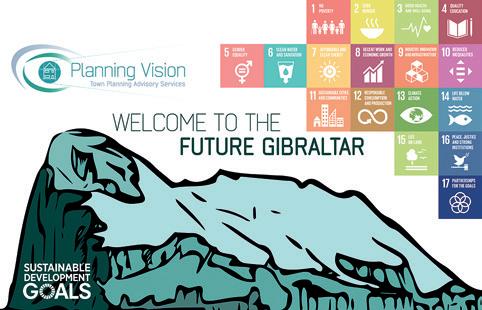
Paso 4: Desarrollar un Plan de Acción Inicial
El siguiente paso se centra en la intervención y el debate con respecto a la integración de medidas de mitigación y la mejora del desarrollo del proyecto. En esta etapa se identifican las acciones, los indicadores y el nivel de efecto para cada meta de los ODS, así como las sinergias y conflictos entre ellos. Las partes relevantes e interesadas asumen la responsabilidad de las acciones relevantes para su profesión y/o intereses, reforzando así la propiedad de estas acciones.
5: supervisar y evaluar
Cuando un proyecto llega a las fases más analíticas y la fase de implementación, a menudo cambia debido a la viabilidad, el horario, la política, etc. Por tanto, es importante reevaluar el impacto del proyecto en la sostenibilidad, cuando se producen parámetros cambiantes, ya que pueden surgir nuevas posibilidades, o los impactos negativos pueden requerir ser mitigados. El seguimiento y la evaluación continuos tienen el beneficio de ajustar el proyecto antes de que se desvíe de la ruta prevista. Además, ayuda mediante una evaluación de cómo se desarrolló el proyecto, lo que pretendía oponerse, dónde concluyó el diseño final del proyecto, expresado a través de los ODS.
Todos somos responsables de implementar los Objetivos de Desarrollo Sostenible y cumplir con la promesa colectiva que nos hicimos mutuamente para construir un futuro mejor para todos, por lo tanto, si desea obtener más información sobre la integración de los ODS en su proyecto, o requerir asistencia en la aplicación del enfoque FIVESTEP a su propuesta de desarrollo con el fin de aprovechar plenamente la oportunidad que ofrece de contribuir a la agenda de sostenibilidad local y global, póngase en contacto con uno de nuestros especialistas hoy llamando al 200 65 888 o enviando un correo electrónico a info@planning.vision. Nuestros Consultores de Urbanismo y Sostenibilidad están para ayudarle y proporcionarle soluciones de desarrollo sostenible adaptadas a su proyecto.
Dejemos el mundo en un lugar mejor de lo que lo encontramos.
30 OTWO 13 / AUGUST 2020 OTWO 13 / AUGUST 2020 31

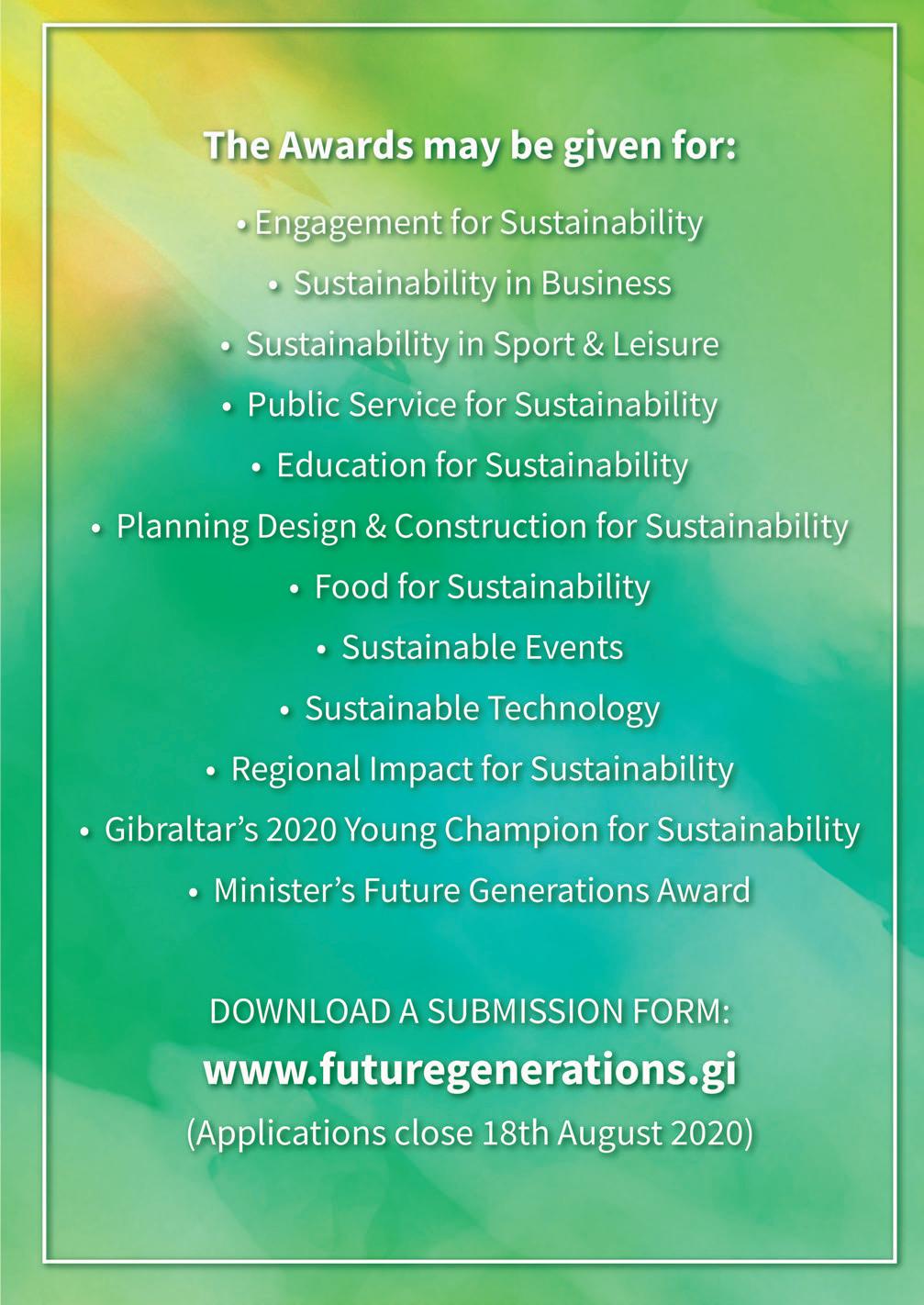

Bahía de Cádiz Natural Park, between the
urban and the divine
Parque Natural Bahía de Cádiz, entre lo urbano y lo divino Antonio Luna del Barco Agencia de Medio Ambiente y Agua de Andalucía
OTWO 13 / AUGUST 2020 35 34 OTWO 13 / AUGUST 2020
The Bahía de Cádiz Natural Park is not your usual protected area. It is intertwined with one of the principal urban cluster in Andalusia. Placed third in the region for the number of its inhabitants after Seville and Malaga. It constitutes 35% of the population of the province of Cádiz, concentrated in densely populated urban centres, with an average of 6,000 inhabitants per km2 and reaching 24,000 inhabitants per km2 in some areas —similar to that of Hong Kong. In short, ten thousand hectares of muddy plains, salt marshes and salt flats surrounded by an urban space permanently inhabited by more than 425,000 Homo Sapiens, to which we must also add several thousand more that arrive daily from the surrounding regions for work or leisure, plus a growing transient population of tourists, that are becoming less seasonal in their visits. A protected space like this, in which human beings are such an abundant species, is not an ordinary occurrence, and invites us to rethink the concept of natural parks, or at the very least, to reconsider the typically applied planning and management models that have been developed and imported from rural areas.
This coexistence between natural and urban space is not a modern phenomenon or solely characteristic of urbanisation processes of the 20th century. It has been a distinguishing character trait of the Bay of Cádiz for three millennia, the foundation of Gadir (Cadiz’s original name) by Phoenician colonisers is considered the introduction of the Western City model. However, despite the presence of humans and urbanisation for a millennia and the subsequent intense management of the territory, the Bay of Cádiz still conserves the largest extension of salt marsh in Spain and constitutes one of the most important coastal wetlands on the Iberian Peninsula. Each year, more than a million aquatic birds comprised of 165 different species migrate through the area, another 120 thousand of 70 species stay for the winter and some 6,500 pairs of 20 different species of birds use the area to procreate. Beating us humans in both their numbers and diversity. About twenty species of threatened flora and many species of endangered fauna inhabit a natural park that has no less than 12 industrial estates as its neighbours – surrounding it from all sides.
Undoubtedly, it is a space of contrasts, evident above all in its unique landscape: a vast, extremely
El Parque Natural Bahía de Cádiz no es un espacio protegido habitual. Se encuentra entrelazado con una de las principales aglomeraciones urbanas de Andalucía. La tercera en número de habitantes tras Sevilla y Málaga. Supone el 35% de la población de la provincia de Cádiz, concentrada en núcleos urbanos densamente poblados, con una media de 6.000 hab/km2 y llegando a alcanzar en alguna zona 24.000 hab/km2 —similar a Hong Kong—. En definitiva, diez mil hectáreas de planicies fangosas, marismas y salinas rodeadas por un espacio urbano habitado por más de 425.000 ejemplares de Homo sapiens sapiens de forma permanente, a los que hay que sumar varios miles más atraídos diariamente desde las comarcas del entorno por trabajo u ocio, más una población flotante turística creciente y cada vez menos estacional. Un espacio protegido como este, en el que el ser humano es una especie tan abundante, no es frecuente y parece invitarnos a repensar el propio concepto de parque natural o, al menos, los modelos de planificación y gestión aplicados convencionalmente, desarrollados e importados desde ámbitos fundamentalmente rurales. Esta coexistencia entre espacio natural y urbano no es un fenómeno moderno propio de los procesos urbanizadores generalizados en el siglo XX. Ha sido un carácter diferenciador de la Bahía de Cádiz desde que, hace tres milenios, la fundación de Gadir por los colonizadores fenicios supusiera la introducción del concepto de ciudad en Occidente. Sin embargo, a pesar de esta milenaria presencia humana y urbana y del intenso manejo del territorio que ha significado, la Bahía de Cádiz conserva la mayor extensión de marisma salada de España y constituye uno de los humedales costeros más importantes de la Península Ibérica. Por él, cada año, pasan en migración más de un millón de aves acuáticas de 165 especies, invernan otras 120 mil de 70 especies y unas 6.500 parejas de 20 especies de aves lo utilizan para procrear. Aún nos ganan en número y diversidad. Una veintena de especies de flora amenazada y otras tantas de fauna amenazada habitan un parque natural que tiene por vecinos —pared con pared— a nada menos que 12 polígonos industriales. Un espacio de contrastes, sin duda, que se evidencian sobre todo en su singular paisaje: una vasta extensión de extrema horizontalidad y obstinada ho-

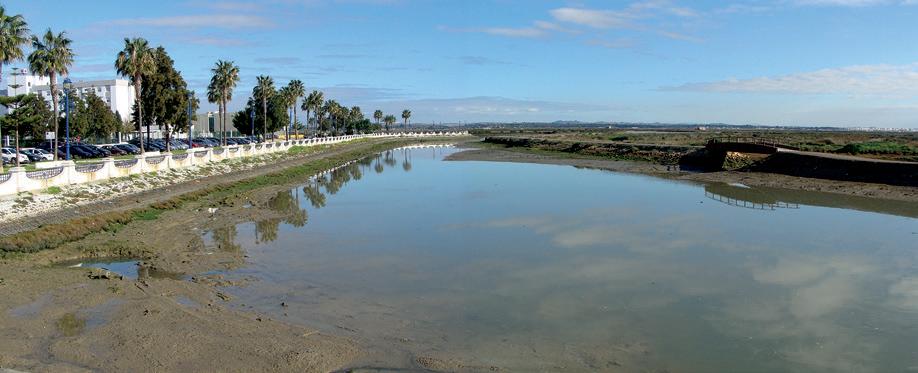

36 OTWO 13 / AUGUST 2020 OTWO 13 / AUGUST 2020 37


flat expanse that is steadfast in its uniformity, inhibited only by urban uses, but not limited in its sense of space and depth, its most conspicuous element is in fact, the sky. In short, a space located between the urban and the divine.
Bahía de Cádiz Central Park
The extraordinary environment in which the Bahía de Cádiz Natural Park is located makes understanding it through its surrounding population also special. It is apparent that in this protected space its local population does not follow the conventions applied to those in other natural spaces, which are usually framed within rural settings. The rustic and nostalgic image of the villager loses all meaning here, adding another facet to this protected space. Three thousand uninterrupted years of urban and cosmopolitan space, together with all that that entails, takes its toll on the collective subconscious. However, this does not mean that the relationship between the population and the natural environment and its resources is not a close one. In the Bay of Cádiz, use of the natural space, especially its marine resources, such as salt farming, fishing, or shell fishing, have remained almost intact since ancient times – even as far back as Prehistory. However, even though the Bay’s population maintains cultural features closely linked to the natural space and its resources, as seen in leisure activities, gastronomy or heritage, the number of its inhabitants who live from these primary activities and the general economic dependence on these occupations is very low compared to rural settings.
This unusual trait of the local population can be seen above all else in its use of the protected area. In the Bahía de Cádiz Natural Park, for example, it is unusual for the typical ecotourist or enthusiast of road trips and country routes, to plan a visit to the area. Here, the use of the natural space is immediate, popular, more local and more conscientious. Increasingly, Natural Parks are considered the major green recreational area of urban environments, used for sports, walking dogs, walking for fitness or to cycle from one municipality to another. This implies habit rather than chance. And more so in the cities of the Bay, where, due to its cramped urban spaces, green areas are scarce. In New York people walk through Central Park, in Madrid, through El Retiro, in the Bay of Cádiz, through its Natural Park.
mogeneidad, solo constreñida por los usos urbanos, pero que apenas limitan su sensación de amplitud y profundidad, y cuyo elemento más conspicuo es, en realidad, el cielo. Un espacio, en definitiva, situado entre lo urbano y lo divino.
Bahía de Cádiz Central Park
El especial contexto en el que se ubica el Parque Natural Bahía de Cádiz hace que sea también especial la forma de entenderlo por la población de su entorno. Es obvio que en este espacio protegido el concepto de población local no sigue los convencionalismos aplicados a otros espacios naturales, enmarcados en entornos rurales. Pierde sentido la imagen bucólica y nostálgica del lugareño, como un elemento más del espacio protegido. Tres mil años ininterrumpidos de espacio urbano y cosmopolita, con todo lo que ello conlleva, hacen mella en el subconsciente colectivo. Esto no quiere decir que la vinculación de la población con el entorno natural y sus recursos no sea también estrecha. En la Bahía de Cádiz se mantienen casi intactos desde la Antigüedad —o incluso desde la Prehistoria— usos del espacio natural ligados a sus recursos marinos, como el cultivo de la sal, la pesca o el marisqueo. Sin embargo, aunque la población de la Bahía mantiene rasgos culturales muy ligados al espacio natural y a sus recursos, que descubrimos en el ocio, en la gastronomía o en el saber popular, el número de sus habitantes que vive de estas actividades primarias y, en general, la dependencia económica de ellas, son muy reducidos en comparación con entornos propiamente rurales.
Este diferente carácter de la población local se aprecia sobre todo en el uso que esta hace del espacio protegido. En el Parque Natural Bahía de Cádiz, por ejemplo, es poco habitual el perfil del usuario ecoturista, coleccionista de itinerarios y rutas campestres, que planifica una visita. Aquí el uso público del espacio natural es más popular, más cercano, más ciudadano, más democrático. Así, y cada vez más, el Parque Natural se concibe como la gran zona verde de esparcimiento de los entornos urbanos, utilizada para hacer deporte, para pasear al perro, para pasearse a sí mismos por prescripción médica o para ir de un municipio a otro en bicicleta. Esto implica hábito más que ocasión. Y más en las ciudades de la Bahía, donde, debido a lo apretado de sus tramas
38 OTWO 13 / AUGUST 2020 OTWO 13 / AUGUST 2020 39
Due to all this, unlike other natural spaces, the local population can play a prominent role in the creation of public use policies and the patrimonial promotion of the Natural Park. Without disregarding foreign and occasional visitors to the area as a method of maintaining the area and its activities, as is the case in any natural space, this parks special position in terms of its public use and the proximity of this protected space to civilisation, means that the local population and the citizens of the Bay of Cádiz, should play a part in its policies particularly as they are the beneficiaries of these measures.
The aim is to improve the local populations understanding, appreciation and connection to the Natural Park, as this relationship is a critical factor in ensuring its conservation, and for the successful development of policies. Although this relationship has improved significantly in recent years, it needs to be strengthened, using the daily and domestic use of the natural park as a peri-urban recreation area as an opportunity.
An approach strategy
The Sustainable Development Plan of the Natural Park and its Socioeconomic Influence Area faces a big challenge in its objectives and measures. The socio-economic revitalization plan, which is currently in progress, indicates that its main goal is to bring the local population closer to the park and involve them in important actions such as environmental education and awareness of the protected area, planning of public use, its infrastructures and equipment, or for citizens to participate in planning and space management.
Above all, schools in the area require a continuous and permanent environmental education programme, with goals that include the use of the Natural Park as a cross-sectional element of the curriculum and that fosters a practical and direct relationship with the natural space, involving the entire educational community, including families. It is especially important to promote the world of salt, traditional salt mines and the cultivation of estuaries to the local population, not just because of its exceptional cultural heritage but also as sustainable and prospective activities considered by students as future professional opportunities. A space that includes activities to make people think and innovate. A connection between the educational system and the Natural Park should not only be included and dee-
urbanas, escasean las zonas verdes. En Nueva York se pasea por Central Park, en Madrid, por el Retiro, en la Bahía de Cádiz, por su Parque Natural. Debido a todo ello, a diferencia de otros espacios naturales, en éste, la población local adquiere una importancia destacada como objetivo de las políticas de uso público y difusión patrimonial del Parque Natural. Sin dejar de considerar a visitantes foráneos y ocasionales al espacio como objetivo de equipamientos y actividades, como lo es en cualquier espacio natural, lo que hace especial a este parque desde el punto de vista del uso público y del acercamiento del espacio protegido a la sociedad es el papel que debe desempeñar la población local, la ciudadanía de la Bahía de Cádiz, como destinataria de dichas actuaciones. Se trata con ello de mejorar el conocimiento, valoración y vinculación con el Parque Natural de la población local, dado que la relación de esta con el Parque Natural es un factor decisivo para su conservación y para el éxito de las políticas de desarrollo basadas en él. Aunque dicha relación ha mejorado notablemente en los últimos años, es necesario fortalecerla, aprovechando como oportunidad ese uso cotidiano y doméstico del parque natural como zona periurbana de esparcimiento. Una estrategía de aproximación
Todo un reto, que el Plan de Desarrollo Sostenible del Parque Natural y su Área de Influencia Socioeconómica afronta plenamente en sus objetivos y medidas. Este plan de dinamización socioeconómica, actualmente en tramitación, implica en ese objetivo de acercamiento de la población local ámbitos de actuación tan importantes como la educación y concienciación ambientales sobre el espacio protegido, la planificación del uso público, de sus infraestructuras y equipamientos, o la participación ciudadana en la planificación y gestión del espacio.
La educación ambiental requiere sobre todo un programa continuado y permanente en los centros escolares del ámbito, que incluya el Parque Natural como elemento transversal de los currículos educativos, fomente la relación experiencial y directa con el espacio natural e implique a toda la comunidad educativa, incluida las familias, en sus objetivos. Especialmente importante es propiciar el acercamiento de la población local al mundo salinero, a las salinas tradicionales y el cultivo de los esteros, no solo
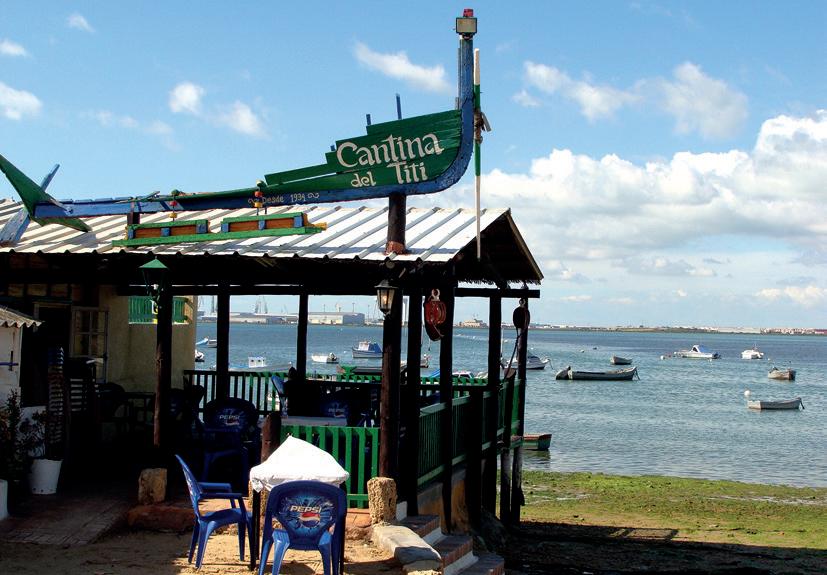
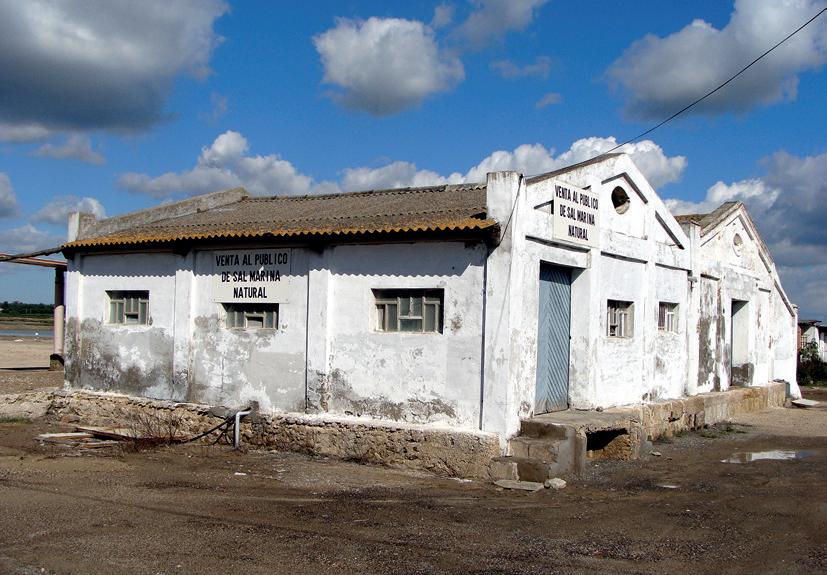
40 OTWO 13 / AUGUST 2020 OTWO 13 / AUGUST 2020 41
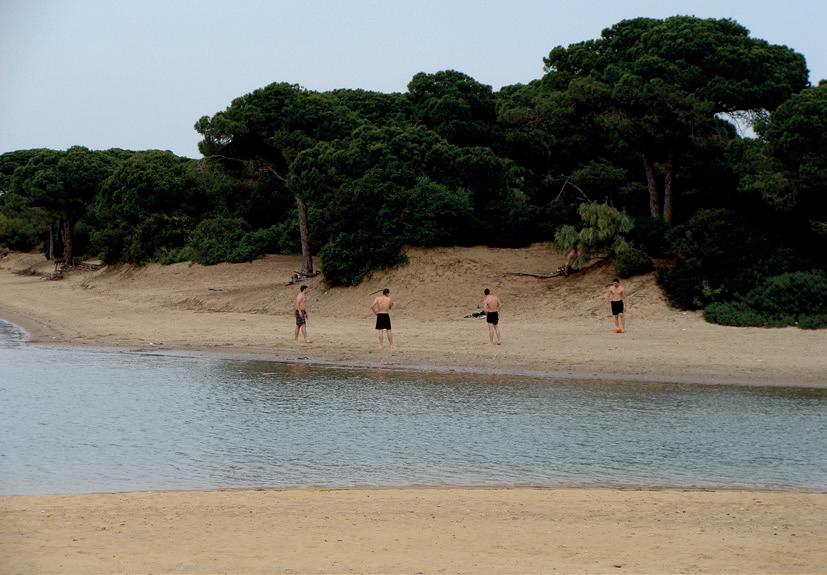

med necessary in early stages of education. The presence of the Puerto Real University Campus situated within and around the Natural Park, where sea and environmental related subjects are mainly taught, represents an opportunity to integrate the Natural Park into academic curricula and to take advantage of the park as a natural laboratory for teaching and research that is both close by and accessible. But encouraging the local population to get closer to and connect with the Natural Park also requires the improvement of physical infrastructure that is not just limited to public use facilities. Integrating the landscape and environment of bordering urban areas with the Natural Park will improve the connection between inhabited urban spaces and the protected parkland and by extension, bring people closer to it. The creation of safe school paths connecting educational centres with the Natural Park, improving connections with the parks network of footpaths and bicycle lanes or the improvement of public amenities and public transport connections to particular areas are some essential actions that will enable the educational community as well as the general population to have a direct and experiential relationship with the natural space.
On the other hand, promoting citizen participation in the planning and management of the Natural Park draws people’s attention to the space thus contributing towards placing the protected space and its conservation among the concerns and interests of local citizens, whilst also allowing the planning and management of the space to be adapted according to real needs and social demands. Some of the actions being considered are; improving both electronic and face to face channels of citizen participation, strengthening the Governing Board of the Natural Park as the main body managing the natural space, the implementation of processes to encourage citizen participation (participatory planning, monitoring and evaluation of public policies and services ...) and measures to promote participation (training, awareness, accessibility ...).
Volunteer initiatives in the Natural Park are also a powerful tool to promote public participation in the conservation, promotion and sustainable development of the Natural Park, through which strong and close links with the natural space are also crea-
como un patrimonio cultural excepcional sino también como actividades sostenibles y con futuro, que puedan contemplarse por el alumnado como salidas profesionales. Un espacio y unas actividades sobre las que también pensar e innovar. La conexión del sistema educativo con el Parque Natural no solo es una necesidad y una oportunidad en las etapas básicas. La presencia del Campus Universitario de Puerto Real dentro y en el borde del Parque Natural, donde se imparten principalmente estudios vinculados al mar y al medio ambiente, supone una oportunidad para integrar el Parque Natural en los currículos académicos y de aprovechar aquel como un laboratorio natural para la docencia y la investigación, cercano y accesible.
Pero el acercamiento de la población local al Parque Natural requiere también mejorar la infraestructura física que posibilita esa conexión y que no se limita a los equipamientos de uso público. La integración paisajística y ambiental de los bordes urbanos con el Parque Natural mejorará la conexión del espacio habitado con el espacio protegido y por ende dicho acercamiento. La creación de caminos escolares seguros que conecten los centros educativos con el Parque Natural, la mejora de las conexiones con su red de senderos y vías ciclistas o la mejora de la conexión en transporte público a enclaves y equipamientos de uso público son algunas acciones esenciales para posibilitar la relación experiencial y directa de la comunidad educativa y de la población general con el espacio natural.
Por otro lado, fomentar la participación ciudadana en la planificación y gestión del Parque Natural permite atraer la mirada de la sociedad sobre el espacio, contribuyendo a situar el espacio protegido y su conservación entre las preocupaciones e intereses de la ciudadanía, a la vez que permite adaptar la planificación y gestión del espacio a las necesidades y demandas sociales. La mejora de los canales de participación ciudadana, tanto electrónicos como presenciales, el fortalecimiento de la Junta Rectora del Parque Natural, como principal órgano de participación en la gestión del espacio, la puesta en marcha de procesos de participación ciudadana (planificación participativa, seguimiento y evaluación de políticas y servicios públicos...) o de medidas de fomento de la participación (formación, sensibiliza-
42 OTWO 13 / AUGUST 2020 OTWO 13 / AUGUST 2020 43
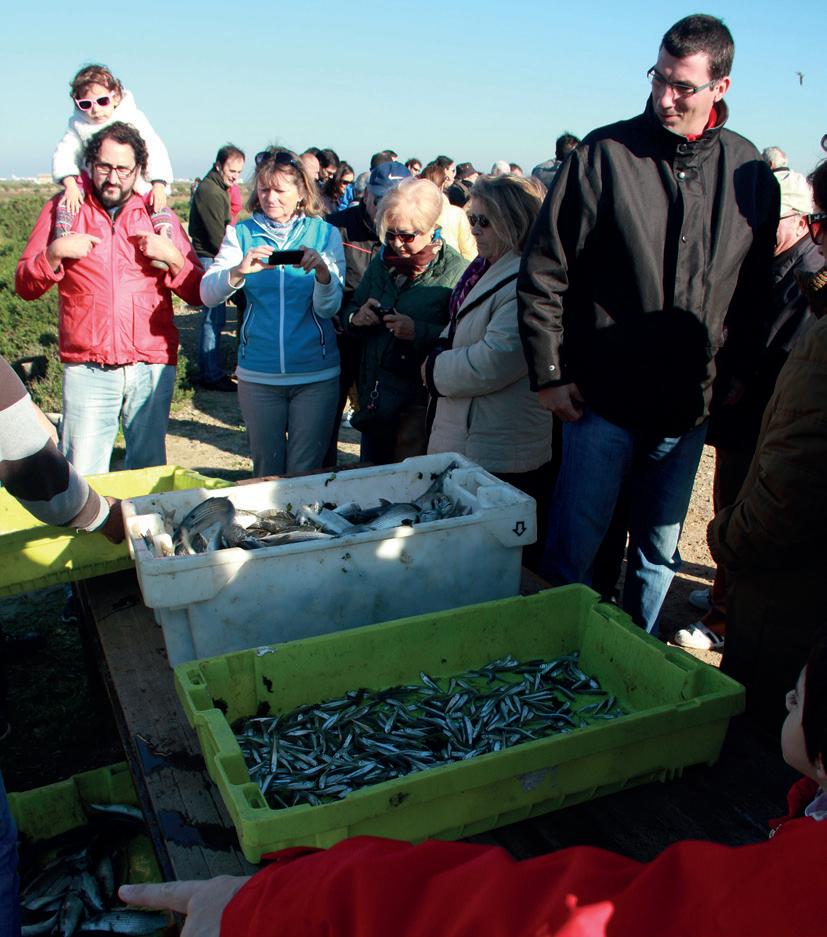
ted. Among these initiatives, projects for social and participatory use of traditional salt farms could be an interesting alternative to allowing these useful exploitation areas to be abandoned due to lack of economic profitability.
In short, due to its intertwined structure and as the backbone of an important urban cluster, the Bahía de Cádiz Natural Park has established a different relationship between the people that inhabit its surroundings to that of other natural spaces. Rather than playing the role of host to tourists, the population living in the Bay of Cádiz should be the primary focus when it comes to policies for public
ción, accesibilidad…) son algunas de las acciones contempladas.
Las inciativas de voluntariado en el Parque Natural constituyen también una potente herramienta de participación ciudadana en los objetivos de conservación, promoción y desarrollo sostenible del Parque Natural, a través de las cuales se generan además vínculos estrechos y sólidos con el espacio natural. Entre esas iniciativas, los proyectos de uso social y participativo de explotaciones salineras tradicionales pueden ser una interesante alternativa al abandono de esos aprovechamientos por falta de rentabilidad económica.

use and the dissemination of the Natural Parks heritage. The objective of these policies, with measures such as those proposed in the Sustainable Development Plan, should be to strengthen the link between the citizens of the Bay of Cadiz and the Natural Park and to increase their involvement. Thereby ensuring the conservation of a natural space located between the urban and the divine.
44 OTWO 13 / AUGUST 2020
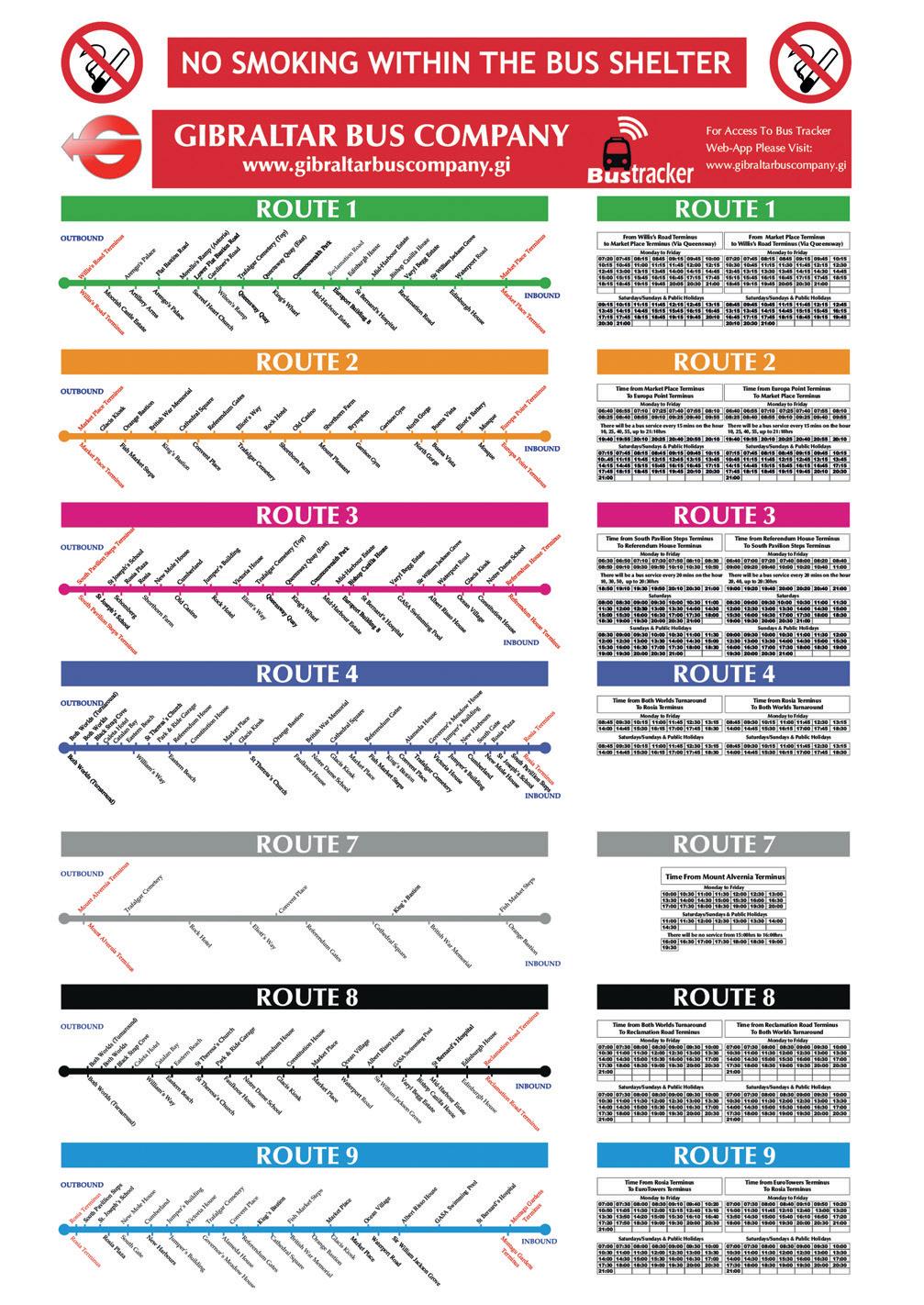


Text and photos: Autor: Felipe Muñoz Secilla, naturalista. Verdemar – Ecologistas en Acción.
OTWO 13 / AUGUST 2020 49
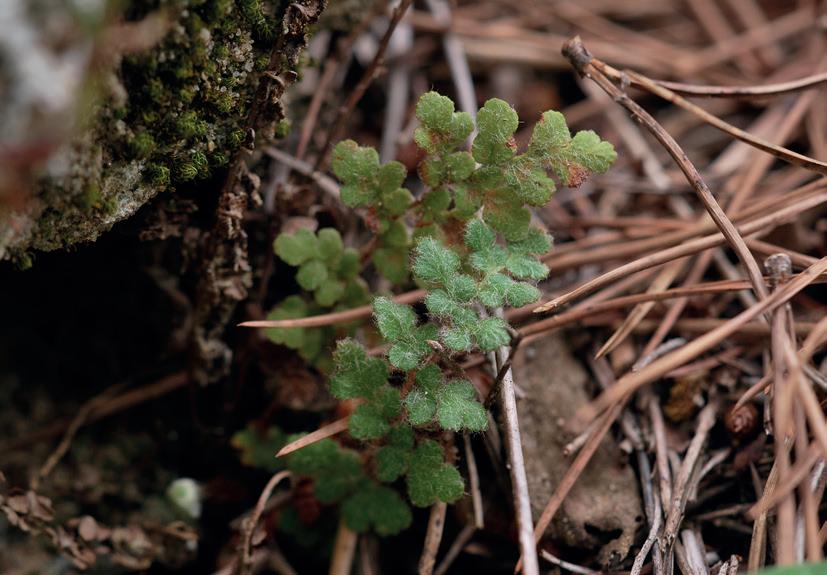
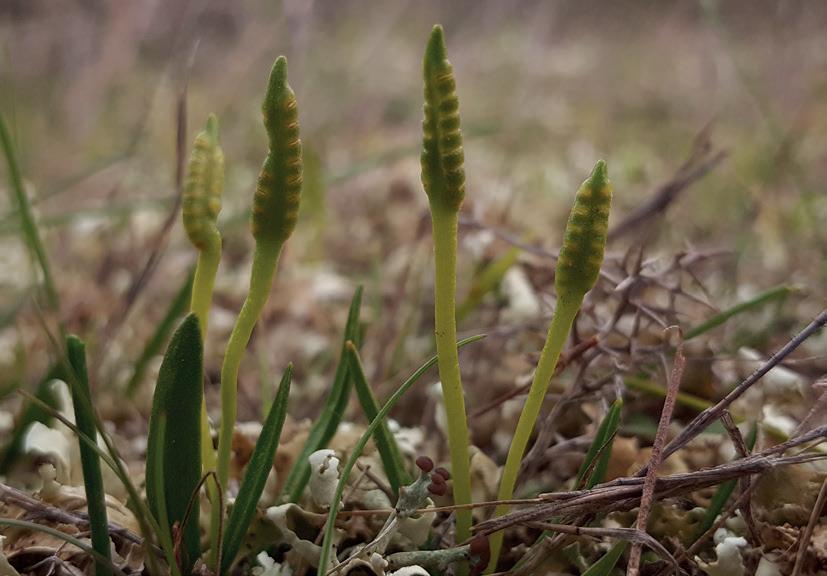
Originally, Pinar del Rey, together with the adjoining ranches of Chapatal and Alcaidesa, formed part of a sandy seabed habitat dating back to the Upper Pliocene era, a geological period that took place approximately 2,500 million years ago. Bioclastic calcarenite outcrops made from these sandy quaternary deposits together with thousands of years of erosion have left mollusk shells, bivalve fragments, and other marine pieces visible, classifying the area as an interior fossil sandbank.
Calcarenite outcrops appear in the upper area of the Pinar, which is clearer of trees and more exposed to the sun. Stone pines, able to adapt to all types of soil are replacing cork oaks trees which are calcifuge plants that are unable to tolerate limestone soil. Substrate soil is more widespread and diverse, with alkaline and basic earth alternating with sandy acidic soil, allowing for immense richness and taxonomic diversity. In this environmental area we are able to find interesting and vulnerable species such as wild tea plants (Osyris quadripartita), juniper (Juniperus oxycedrus), ferns (Cosentinia vellea and Asplenium billotii), as well as heather and low-growing plants such as rockrose, gorse, esparto, rue, etc. Tree species such as stone pine (Pinus pinea) develop in acidic sandy soils, which extend over most of Pinar del Rey. Together with the cork oak (Quercus suber) they form a peculiar mixed forest. In this environmental area, they are mixed together with arboreal bushes such as the narrow-leaved mock privet (Phillyrea angustifolia), the mastic tree (Pistacia lentiscus), the common hawthorn (Crataegus monogyna), the kermes oak (Quercus coccifera), the european falm palm (Chamaerops humilis), the flax-leaved daphne (Daphne gnidium), Armeria (Armeria macrophylla), (Armeria hirta) which are protected species, small plants of interest such as the micro fern (Ophioglossum lusitanicum), commonly called “Least Adder’s Tongue” which blooms throughout the year depending on humidity, also wild garlic (Allium pruinatum) a very rare species commonly called “dwarf red garlic”, in addition to a wide variety of Rockroses or Cystaceae.
There is just one species on the sandbanks, Loeflingia baetica Lag. It is small and difficult to observe and blooms in the spring. Due to its viscosity and as it matures in sunlight it takes on a stone like so-
El Pinar del Rey en su origen, junto con las fincas colindantes del Chapatal y la Alcaidesa, formó parte de un asentamiento arenoso de fondos marinos y data del Plioceno Superior, época geológica aproximada a los 2.500 millones de años. Los afloramientos de calcarenitas bioclásticas de estos depósitos cuaternarios arenosos y la erosión durante miles de años han dejado visibles conchas de moluscos, fragmentos de bivalvos y piezas marinas, que lo identifican como arenal interior fósil.
En la zona alta del Pinar, más despejada de arboleda y más expuesta al sol, aparecen afloramientos de calcarenitas. Los pinos piñoneros que se adaptan a todo tipo de suelo van sustituyendo a los alcornoques que son calcífugos y no soportan la cal. El sustrato del terreno, es más amplio y variado, alternándose los suelos alcalinos o básicos con los arenosos ácidos, lo que permite una gran riqueza y diversidad taxonómica. En esta unidad ambiental podemos encontrar especies de interés como, el bayón (Osyris quadripartita), el enebro (Juniperus oxycedrus), helechos (Cosentinia vellea y Asplenium billotii) especies vulnerables, brezos y plantas de bajo porte como las jaras, aulagas, esparto, rudas, etc.
En los suelos arenosos ácidos, que se extienden por la mayor parte del Pinar del Rey, se desarrollan especies arbóreas como el pino piñonero (Pinus pinea), que junto con el alcornoque (Quercus suber) forman un peculiar bosque mixto. En esta unidad ambiental, se entre mezclan con arbustos de porte arbóreo como, el labiérnago (Phillyrea angustifolia), el lentisco (Pistacia lentiscus), el majuelo (Crataegus monogyna), la coscoja (Quercus coccifera), el palmito (Chamaerops humilis), el torvisco (Daphne gnidium), Armerias (Armeria macrophylla), (Armeria hirta) especies protegidas, plantas pequeñas de gran interés como el micro helecho (Ophioglossum lusitanicum) llamado vulgarmente “Lengua de culebra” que florece a lo largo del año en función de la humedad, también el ajo (Allium pruinatum) una especie rarísima llamado “ajo rojo enano”, además de una amplia variedad de Jaras o Cistaceas.
En los arenales existe una especie, Loeflingia baetica Lag. Es una planta de pequeño porte y difícil de observar, la cual florece en primavera, que por su viscosidad y en la medida que el sol la va madurando coge una textura sólida como la piedra (Loeflingia
50 OTWO 13 / AUGUST 2020 OTWO 13 / AUGUST 2020 51
Cosentinia vellea
Ophioglossum lusitanicum
lid texture (Loeflingia baetica), vulnerable VU (Law 8/2003 ), NT (Red List of Vascular Flora of Andalusia).
Rainwater drains very easily from these sandbanks, retaining humidity throughout most of the year under the mulch of the pines fallen leaves, especially on humid easterly days, creating favourable conditions for the proliferation of a wide variety of mushrooms when the first rains fall. These soils are also suitable for thousands of insects, including beetles of particular interest such as Buprestis splendens, Cerambyx cerdo and other species such as, Nemoptera bipennis, Geotrupes stercorarius, both of which are pollinators and drivers of symbiosis with plants as well as habitat recyclers, resulting in great biodiversity.
Nemoptera bipennis is an endemic species of the Iberian Peninsula, more common in the south but rare. Since ancient times, these Neuropterans have been considered a mixture of dragonflies and butterflies. Their larvae is collected by ants along with plant seeds and they take 2 years to grow, they are carnivorous, feeding on anthill larvae, when they are adults their diet consists of pollen, pollinating the plants on which the ants depend.
The black spider of Los Alcornocales, Macrothele calpeiana, was classified by Walckenaer in 1805, with specimens collected in Gibraltar and is named in reference to Mount Calpe, the rock of Gibraltar. It is included in the Berne Convention and later in Directive 92/43 / EEC, known as the Habitat Directive. And in the National Catalogue of Threatened Species.
Along the route of the Laja stream, where the groundwater table from the underground aquifer comes to the surface at various natural sources, the riverside forest clearly differs from other areas. The humid and darker environment results in a proliferation of large trees, forming a path towards the sun, here we observe the Andalusian gall oak (Quercus canariensis), black poplar (Populus nigra), common alder (Alnus glutinosa), narrow-leafed ash (Fraxinus angustifolia), shrubs such as buckthorn (Rhamnus alaternus), common ivy (Hedera helix), oleander and river plants such as Mentha aquatica, Melissa officinalis.
The name of the stream comes from its passage through the slabs of sandstone rock in Los Charco-
baetica), vulnerable VU (Ley 8/2003), NT (Lista Roja de la Flora Vascular de Andalucía).
Estos arenales drenan el agua de lluvia con mucha facilidad, manteniendo la humedad bajo el mantillo de las hojas caídas de los pinos, durante casi todo el año, sobre todo en los días húmedos de levante, favoreciendo la proliferación de una gran variedad de setas, con las primeras lluvias. También son suelos apropiados para miles de insectos, entre ellos coleópteros de interés comunitario como el Buprestis splendens, Cerambyx cerdo y otras especies como, Nemoptera bipennis, Geotrupes stercorarius, que son los polinizadores y generadores de esta simbiosis con las plantas y recicladores del hábitat, que dan como resultado esta gran biodiversidad.
La especie Nemoptera bipennis, es una especie endémica de la península Ibérica, más frecuente en el sur y rara. Estos Neurópteros han sido considerados desde antiguo como una mezcla de libélulas y mariposas. Sus larvas son recolectadas por hormigas junto con las semillas de las plantas y se desarrollan durante 2 años, son carnívoras, alimentándose de las larvas del hormiguero, cuando son adultas su dieta es el polen, polinizando las plantas de las cuales dependen las hormigas.
La araña negra de los Alcornocales, Macrothele calpeiana fue descrita por Walckenaer en1805, sobre material recolectado en Gibraltar y recibe el nombre en referencia al monte Calpe, el peñón de Gibraltar. Está incluida en el convenio de la Berna y más tarde en la Directiva 92/43/CEE, conocida como Directiva Hábitat. Y Catálogo Nacional de Especies Amenazadas.
En el recorrido del arroyo de la Laja, donde el nivel freático del acuífero subterráneo aflora en varias fuentes en su curso natural, el bosque de ribera se diferencia claramente de otras zonas, el ambiente húmedo y más oscuro hace proliferar arboles de gran porte que hacen su camino hacia el sol, observándose el quejigo andaluz (Quercus canariensis), el álamo (Populus nigra), el aliso (Alnus glutinosa), el fresno (Fraxinus angustifolia), arbustos como el sanguino (Rhamnus alaternus), la Hiedra (Hedera helix), la adelfa y plantas de rio como Mentha aquatica, Melissa officinalis
El nombre del arroyo viene, de su paso por las lajas de rocas areniscas en los Charcones, entre la fin-

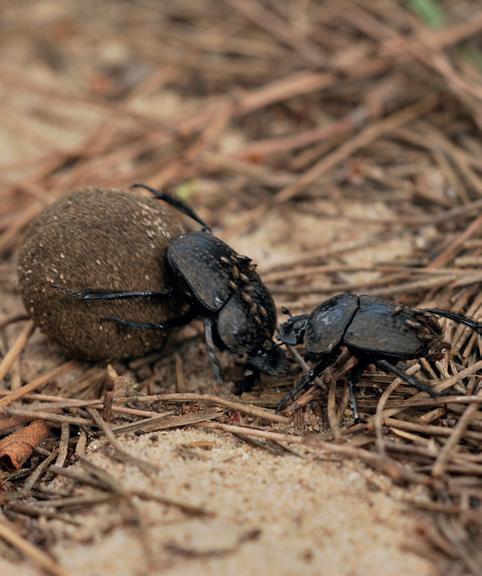


52 OTWO 13 / AUGUST 2020 OTWO 13 / AUGUST 2020 53
Loeflingia baetica
Escarabajo pelotero (Geotrupes stercorarius)
Nemoptera bipennis
Macrothele calpeiana
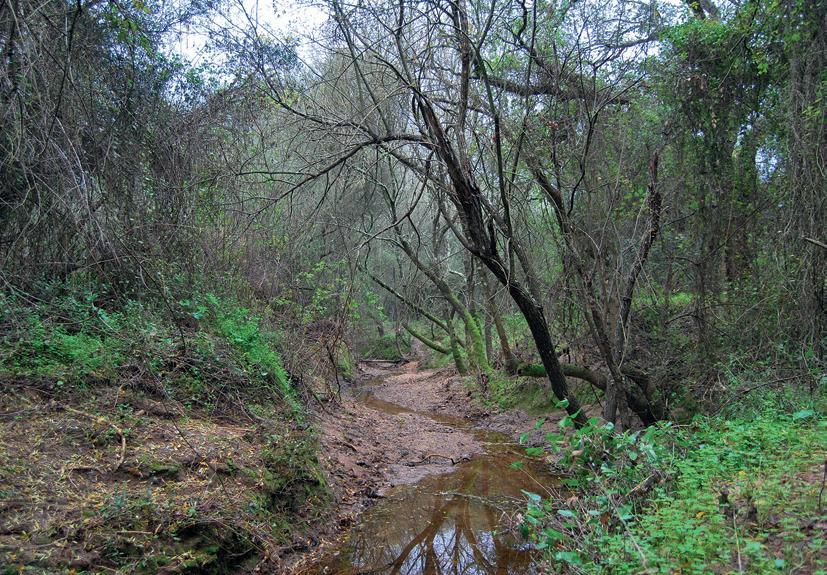
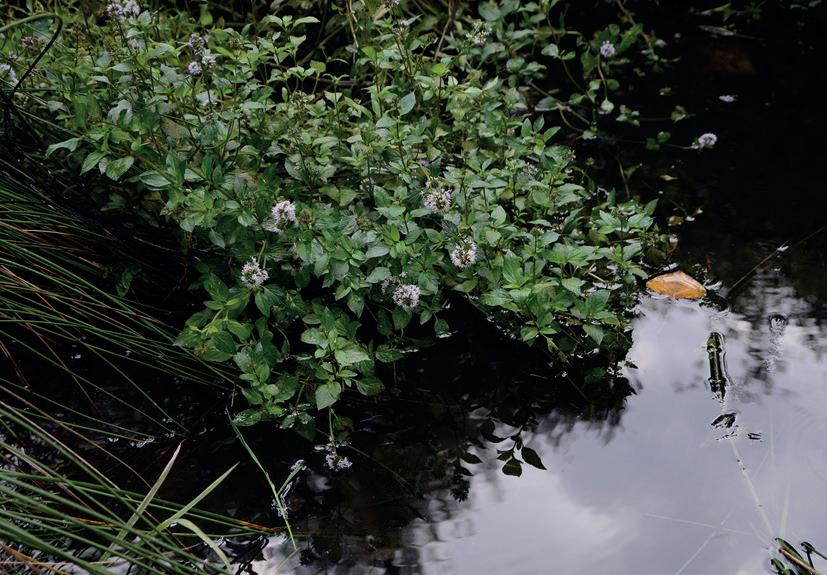
nes, between the Alcaidesa estate and Pinar del Rey. This stream fundamentally depends on hydrological cycles and the levels of its aquifer, drying out in high areas during the summer. On its journey through humid and shady areas, interesting species such as Umbilicus heylandianus, Scrophularia laxiflora, Ruscus hypophyllun, Rubia agostinhoi and other more common species such as wild blackberry, common soapwort, periwinkle, lotus, etc.
North of Pinar del Rey, in the charcones, where the La Laja stream crosses from Alcaidesa, the soil takes on a sandy character, cork oak and other species are replacing the stone pine, returning the landscape to its original state. Here, plants of the sandbank coalesce with plants from oak forests.
Located 10 kilometres from the coast, Pinar del Rey still maintains many elements of coastal vegetation. This makes the area one of great importance, as it remains an isolated stronghold, removed from the coasts’ brutal onslaughts, siltation and the urban maelstrom. Its biodiversity is generated from the lithological variety of its substrate and the weather conditions. Consisting mainly of sandstone, calcareous outcrops and clayey soil areas, has made this place enormously rich in plant variety. The taxa of: Sideritis Perezlarae, Hymenostemma pseudoanthemis, Loeflingia baetica, Narcissus gaditanus, Linaria munbyana, Mercurialis elliptica, Armeria macrophylla etc., are a living example of the more than thirty threatened or protected plant species still preserved in this wonderful enclave.
Extending across 360 hectares, the Pinar del Rey is classified as “Monte de Dominio Público” in the General Strategy for Urban Planning of the San Roque City Council, “Recreational Adaptation Area” in the Plan for the Territory of Campo de Gibraltar, and currently included in the Junta de Andalucia’s Official Newsletter as “Los Alcornocales Natural Park” a green corridor to Guadalquitón.
These classifications however have not prevented the development of some highly damaging activities on its soils, such as sports and recreational facilities together with their consequent infrastructures. This valuable area has undergone a big transformation in recent years due to human pressure. The main reasons are; the continued use of the area without effective control by public administrations causing
ca de la Alcaidesa y el Pinar del Rey. Este arroyo, depende fundamentalmente de los ciclos hidrológicos y del nivel de su acuífero, secándose en las zonas altas de su curso durante el verano. En su recorrido por zonas húmedas y sombrías, se dan especies interesantes como Umbilicus heylandianus, Scrophularia laxiflora, Ruscus hypophyllun, Rubia agostinhoi y otras más comunes como la zarza, la jabonera, la vinca, la unciana, etc.
Al norte del Pinar del Rey, en los charcones, cuando el arroyo La Laja cruza desde la Alcaidesa, el suelo toma un carácter arenoso Aljabico, el alcornoque y otras especies van sustituyendo al pino piñonero, retornando el paisaje a su estado original. Aquí confluyen plantas del arenal con otras propias del alcornocal.
El Pinar de Rey, situado a 10 kilómetros de la costa, aún mantiene una gran cantidad de elementos vegetales del litoral. Este hecho le confiere una gran trascendencia, al mantenerse como un reducto aislado y fuera de las grandes agresiones que padece la costa, por la colmatación y la vorágine Urbanística. La variedad litológica del sustrato y la climatología, generan su biodiversidad. Constituida mayormente por areniscas, afloramientos de calcarenitas y zonas arcillosas, convierten a este lugar en un sotobosque enormemente rico en variedad vegetal. Los taxones de: Sideritis Perezlarae, Hymenostemma pseudoanthemis, Loeflingia baetica, Narcissus gaditanus, Linaria munbyana, Mercurialis elliptica, Armeria macrophylla etc., son un vivo ejemplo de las más de treinta especies vegetales amenazadas o protegidas que aún se conservan, en este maravilloso enclave. Con una extensión de 360 hectáreas, el Pinar del Rey catalogado como “Monte de Dominio Público” en el Plan General de Ordenación Urbanística del Ayuntamiento de San Roque, “Área de Adecuación Recreativa” en el Plan de Ordenación del Territorio del Campo de Gibraltar, y actualmente incluido en el Boletín Oficial de Junta de Andalucía como “Parque Natural de Los Alcornocales” corredor verde hasta Guadalquitón.
Estas clasificaciones no impiden que en sus suelos se sigan desarrollando algunas actividades altamente perjudiciales para su conservación, tales como instalaciones deportivas y recreativas, con sus consecuentes infraestructuras. Esta valiosa zona,
54 OTWO 13 / AUGUST 2020 OTWO 13 / AUGUST 2020 55
Arroyo de La Laja
Mentha aquatica
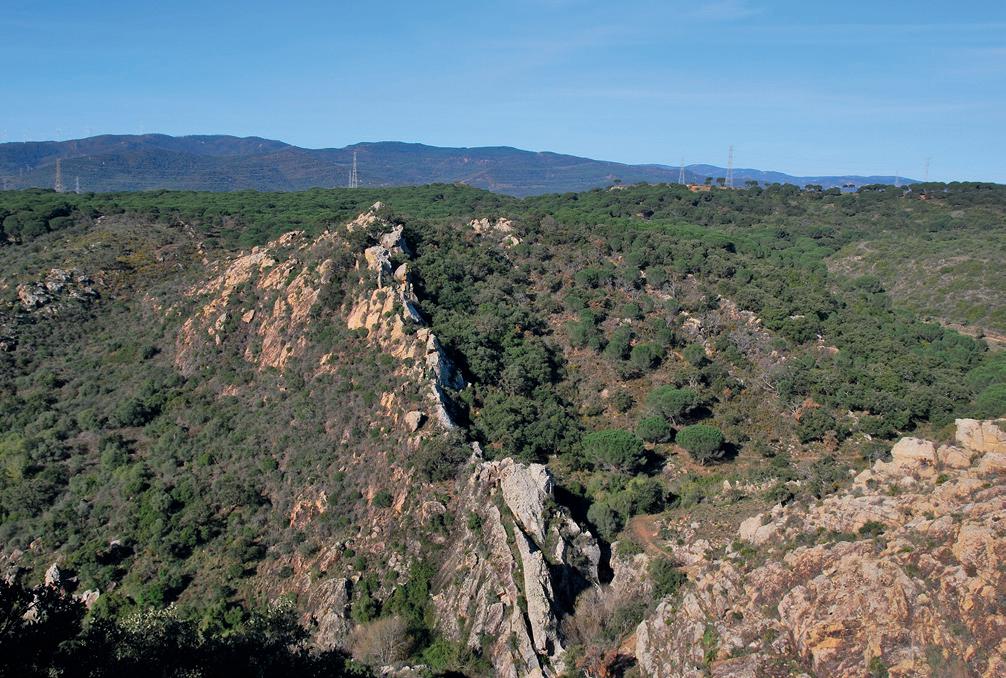
overcrowding, with entry into the park reaching up to 5,000 vehicles and more than 10,000 people in a single day on some weekends, negatively impacting the flora and associated fauna. The indiscriminate use of the Pinar del Rey aquifer with more than 30 open wells, with drilling projects reaching the Romeral in Castellar and more than 20 wells in Marajambú in case of drought, but also for use in new tourist constructions – for sports facilities and industrial purposes, which could mean the loss of the aquifer and, consequently, the La Laja stream, which is vital for Pinar del Rey. The presence of a large network of high-voltage cables to output energy exported from the electrical substation located next to this enclave, make the area especially vulnerable to forest fires. The A7 motorway extension which after 15 years is still being considered in political circles and would cross the entrance of Pinar del Rey, if this were to occur it could be the beginning of the end for this forest, a place of great importance from an ecological and environmental point of view.
Pinar del Rey, a stronghold of coastal sandbanks with a lithological variety of more than 700 plant
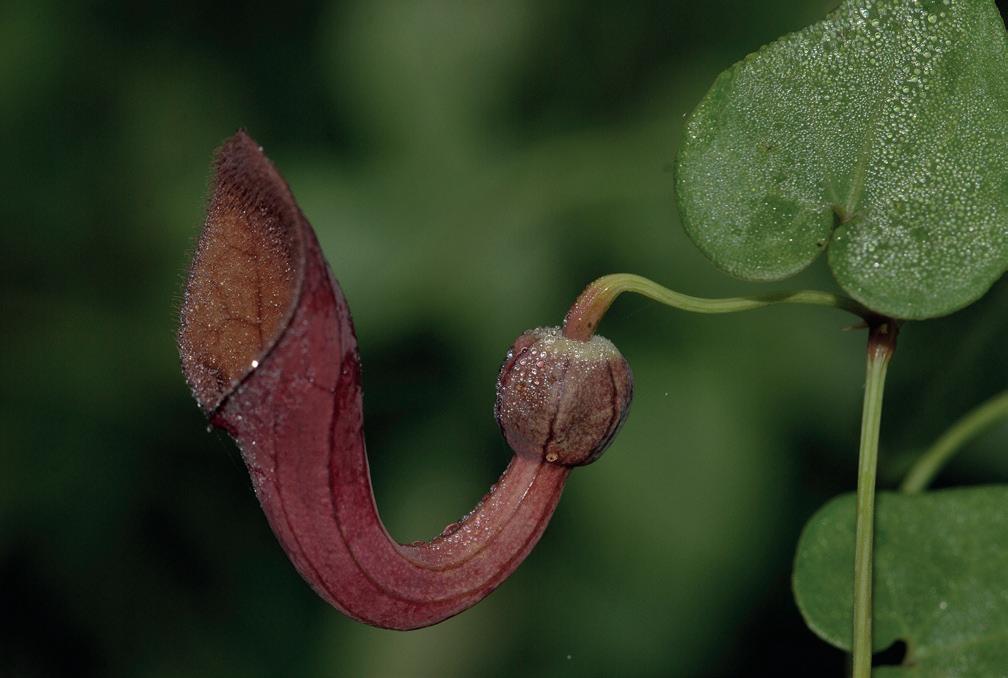
viene soportando una gran transformación en los últimos años debido a la presión humana. Los principales motivos son: El uso continuado del mismo por parte de la población, sin un control efectivo de las administraciones públicas, está provocando la masificación de este entorno, llegándose a contabilizar la entrada de 5.000 vehículos en un solo día y más de 10.000 personas algunos fines de semana, repercutiendo negativamente en la flora y en la fauna asociada. El uso indiscriminado del acuífero del Pinar del Rey con más de 30 pozos abiertos, llegando las perforaciones hasta el Romeral en Castellar, más de 20 pozos en Marajambú, para consumo de los ciudadanos en caso de sequía, pero también de uso para nuevas construcciones turísticas – deportivas e industriales, que pueden suponer la pérdida del acuífero y, por consiguiente, la del arroyo de la Laja, vital para el Pinar del Rey. La existencia de una gran red de cables de alta tensión, para dar salida a la energía exportada por la subestación eléctrica, ubicada junto a este enclave, hacen que sea especialmente vulnerable a los incendios forestales. El proyecto de la variante A7 que después de 15 años
species, of which we have created a photographic inventory, including the more than 30 protected or threatened species. The special characteristics of this environment has caused a large number of animals to flourish, including mammals, amphibians, fish, reptiles, a large number of birds in their migratory cycles and numerous insects, including important beetle varieties and other protected species.
Verdemar - Ecologists in Action, wants to promote the environmental importance that this natural enclave has in the history of San Roque. We need to value it enough to protect future generations.

sigue sonando en los círculos políticos y pretende cruzar la entrada del Pinar del Rey, este hecho podría suponer el principio del fin para este bosque, de una gran importancia desde punto de vista ecológico y medioambiental.
Pinar del Rey, reducto de los arenales costeros, con una variedad litológica de más de 700 especies vegetales, de las cuales hemos realizado el inventario fotográfico y entre ellas, más de 30 especies protegidas o amenazadas. La especial característica de este entorno hace que proliferen gran cantidad de vida animal encontrándonos representantes de mamíferos, anfibios, peces, reptiles, gran cantidad de aves en sus ciclos migratorios y numerosos insectos, entre ellos coleópteros de interés comunitario y otras especies protegidas.
Verdemar – Ecologistas en Acción, quiere dar cuenta de la importancia ambiental que este enclave tiene y tuvo en la historia de San Roque. Es necesario que lo valoremos lo suficiente para protegérselo a las generaciones futuras.
56 OTWO 13 / AUGUST 2020 OTWO 13 / AUGUST 2020 57
Las Lajas, rocas de areniscas en los Charcones
Aristolochia baetica
Interview with Steven Barea

Could you tell us a bit about yourself, your background and your involvement with ESG?
Ever since I was a boy of nine, I’ve always been very keen to learn how radio receivers worked, and how radio waves travelled through space. An avid reader in those days of hobby magazines like ‘Electronics Now’ and ‘Bernard’s & Babani’ series of Hobbyist & Technical books. No computers then in the late 60’s and TV was mostly two channels in Spanish. I spent hours building simple powerless AM radio receivers called crystal sets. Physics was my favourite subject, but mostly electricity. After completing a Grammar School education in Gibraltar, the idea of joining the Dockyard to pursue radio engineering became a dream come true. Trained at HMS Collingwood UK in Radio and Communications diagnostic works. Passed all Technician’s exams required at the ‘Gibraltar and Dockyard Technical College’ now known as the Gibraltar College. Totally unexpected, after seven years working for the MOD, I was successful in securing a full time job as a Lecturer at the college lasting over 35 years teaching. I qualified as a teacher in 1980, and obtained a BSc (Hons) in Electronics and Telecommunications Engineering. Finally retired from teaching in 2015 as ‘Head of ICT’. It was summer, 1st August 2012, when a group of concerned neighbours/residents informed me, that two Gibtelecom GSM 1800MHz mobile phone antennae were going to be placed right above their homes in Waterport Terrace estate. This project was presented to DPC by the operators for approval. We, the concerned neighbours, organised a petition with over 300 signatures and handed it to DPC. The installation never materialised, and those concerned residents were relieved. During that particular DPC session, I met Janet Howitt of the ESG, and we mutually agreed to work together on other areas of public concerns in Gibraltar.
What is 5G and what are your concerns about its rollout across Gibraltar and globally?
5G is a fifth generation of mobile phone technology that supersedes 2, 3, and 4G by providing faster speeds, improved latency, and greater information carrying capacity. Users of mobile phones will be able to download films ten times faster than 4G. It will be possible to have download speeds of 1,000Mbit/s (1Gbit/s), so a 1GB movie could be comfortably down-
¿Podría contarnos algo de usted, su pasado y su implicación en el ESG?
Desde la edad de nueve años he tenido gran interés en aprender el funcionamiento de los receptores de radio así como la forma en la que las ondas de radio viajan por el espacio. Con aquella edad era un ávido lector de revistas como ‘Electronics Now’ y ‘Bernard’s & Babani’, series de los libros Hobbyist & Technical. No había ordenadores en esos últimos años sesenta y la televisión consistía básicamente en dos canales en español.
Dediqué horas a construir receptores de radio AM, sin corriente, denominados ‘crystal sets’. La física era mi asignatura favorita, y de ella sobre todo la electricidad. Tras finalizar mi ciclo educativo en Gibraltar, la idea de entrar en los astilleros para dedicarme a la ingeniería de radio se convirtió en un sueño convertido en realidad. Me formé en trabajos de diagnóstico en radio y comunicaciones en HMS Collingwood, Reino Unido. Aprobé todos los exámenes técnicos requeridos en el entonces llamado ‘Gibraltar and Dockyard Technical College’, el Gibraltar College en la actualidad. De forma totalmente inesperada, tras siete años trabajando para el Ministerio de Defensa, conseguí un empleo a tiempo completo como profesor en la universidad, una labor que se desarrollaría durante 35 años. Me licencié como profesor en 1980 y obtuve una licenciatura en Ingeniería Electrónica y de Telecomunicaciones. Me jubilé finalmente de la enseñanza en 2015 como jefe del departamento de Tecnologías de la Información y la Comunicación.
Fue en verano, el 1 de agosto de 2012, cuando un grupo de ciudadanos y residentes me manifestó su preocupación por la instalación de dos antenas GSM 1800MHz por parte de Gibtelecom justo encima de sus casas en la zona residencial Waterport Terrace. Tal proyecto había sido presentado para su aprobación. Los residentes recogieron más de 300 firmas y las presentaron al departamento de Urbanismo. La instalación nunca se llevó a cabo para alivio de esos residentes. Durante aquella sesión de Urbanismo, conocí a Janet Howitt, del ESG, y acordamos colaborar en otras cuestiones de relevancia pública local.
¿En qué consiste el 5G y en qué le preocupa su desarrollo en Gibraltar y a nivel global?
El 5G es la quinta generación de la tecnología
OTWO 13 / AUGUST 2020 59 58
loaded in 3 seconds. The concerns on the rollout of 5G are complex as there are varying frequency choices under the 5G umbrella each with different characteristics and concerns. There are lower frequency bands (already used for over 20 years), medium bands (used in some WiFi routers), and higher frequency bands (a bit of an unknown quantity). The lower and medium bands range between 600MHz–6GHz, and the higher ranges from 24GHz-86GHz. Currently being deployed in Gibraltar and in most of the world during stage 1 are the lower range of microwaves 600MHz – 3.6MHz (also being used in 3G and 4G). Countries going onto stage 2 are deploying the 24GHz upwards range, also known as millimetre waves (MMW). It is precisely these MMW which is causing a great deal of concern throughout independent, non industry funded, scientific community for their lack of reliable, and independent meaningful testing showing its 100% safe. Those limited tests show that MMW penetrate just a few millimetres under the skin and do not affect major organs. But scientists argue that our skin is in itself, the largest organ of our bodies. It is feared that sweat glands appear as helical coiled antennae, and resonate as a tuned receiving antenna to MMW, causing overheating under our skin surface and mild temperature rises at levels of exposure well below those recommended by the WHO and ICNIRP (International Commission for Non Ionising Radiation Protection) deemed to be safe. It is strongly felt that our peripheral nervous system under our skin will be affected. For this reason we have ‘The 5G appeal’ by scientists and doctors world wide, who call for a moratorium on the rollout of 5G. A substantial and convincing amount of scientific studies are showing many adverse health effects and health hazards from microwave radiation at the lower band 5G frequencies. These are similar to current 4G and 3G used for many years, and have been rated as harmless. ICNIRP’s exposure standards are not fit for purpose anymore. They are just concerned with the heating effects during a six minute use of a mobile phone exposure; they totally reject proven biological effects manifesting at levels way below those deemed safe by them and the WHO.
However, no truly independent evaluation of health effects, nor of effects on the wildlife and the environment have been undertaken by industry for the
telefónica móvil que rebasa los 2, 3 y 4G por proporcionar mayor velocidad, una mejora en los tiempos de espera y mayor capacidad para el almacenaje de información. Los poseedores de teléfonos móviles podrán descargar películas diez veces más rápido que con los 4G. Será posible acceder a velocidades de descarga de 1,000Mbit/s (1Gbit/s), de modo que en tres segundos podrá descargarse fácilmente una película de 1 giga. La preocupación en torno al lanzamiento del 5G es compleja por existir múltiples opciones de frecuencia. Hay bandas de frecuencia más baja (que ya llevan usándose más de 20 años), bandas medias (utilizadas en algunos routers wifi) y bandas de frecuencia más altas (de una cantidad algo desconocida). Las bandas baja y media oscilan entre los 600MHz y los 6GHz y las más altas entre 24 y 86GHz. En la actualidad, en Gibraltar como en la mayor parte del mundo, la fase 1 consiste en el uso de la gama más baja de microondas (de 600 a 3,6MHZ, también empleada en los 3 y 4G). Los países que entran en la fase 2 están proporcionando la gama de 24GHZ hacia arriba, también conocida como ondas milimétricas (MMW). Estas MMW son las que están generando gran preocupación dentro de la comunidad científica independiente y no financiada por empresas debido a la escasez de pruebas fiables que acrediten al 100% que no es una tecnología peligrosa. Las pruebas realizadas, limitadas, demuestran que las MMW penetran apenas unos milímetros en la piel y no afectan a los órganos principales. Pero hay científicos que argumentan que nuestra piel es precisamente el mayor de nuestros órganos. Se teme que las glándulas sudoríparas actúen como antenas helicoidales que, al funcionar como receptoras de MMW, produzcan un sobrecalentamiento bajo nuestra superficie cutánea e incrementos suaves de temperatura, a niveles de exposición, muy por debajo de aquellas recomendadas como seguras por la OMS y la ICNIRP (Comisión Internacional de Protección contra la Radiación No Ionizante). Existe un convencimiento sólido de que el sistema nervioso periférico bajo nuestra piel resultará afectado. Es por ello que disponemos del ‘Llamamiento 5G’, que reúne a científicos y médicos de todo el mundo en reivindicación de una moratoria para el lanzamiento del 5G. Una cantidad sustancial y convincente de estudios científicos vienen mos-
MMW (higher frequency bands). There is no research showing safety either from 5G alone, or from the combined exposure to 5G + already existing radiation from GSM, 3G, WiFi, 4G etc. It is feared that 5G in general is adding another layer on top of all existing non ionising radiation to what is already out there. Much more testing is needed to prove that it is safe before pushing this out and further exposing humans, animals and plants.
The World Health Organisation classifies 5G (together with all radio frequency radiation, including Wi-Fi) as ‘possibly carcinogenic’. Alcohol and processed meats are classified as higher risk due to more scientific evidence. What do you think about this rating and what evidence and information has compounded your concerns?
This is true, all RF were classified in 2011 by WHO’s cancer branch IARC, as ‘possible carcinogenic’ to humans, Class 2B similar to lead, chloroform and DDT. Lead has now been eliminated from petrol, chloroform is no longer used as anaesthetics in the medical industry, and DDT has been banned from use in the agricultural field.
It is not a question of more scientific evidence shown for alcohol, processed meats etc., but one of important evidence being omitted. ICNIRP is influenced by the wireless industry, which has been advising most European governments, including the UK for over 25 years. They have been shown to cherry pick research in favour of no harm. Quoting from Prof Dariusz Leszczynski@brhp who was part of IARC during 2011, 2B classification:
• They are a ‘private club’ where members elect members without need to justify selection.
• Lack of accountability before anyone.
• Lack of transparency of their activities.
• Complete lack of supervision of its activities
•Skewed science evaluation because of the close similarity of the opinions of all members of the Main Commission and all of other scientists selected as advisors to the Main Commission.
It is also worth noting, Dr Sarah Starkey, a neuroscientist, who carried out an investigation which
trando varios efectos nocivos para la salud a causa de la radiación microondas en las frecuencias de la banda más baja del 5G. Éstas son similares a las usadas actualmente en los 4G y las empleadas durante años en los 3G y han sido catalogadas como inofensivas. Los baremos de exposición de la ICNIRP ya no resultan adecuados. Sólo se ocupan de los efectos de calentamiento durante la exposición durante seis minutos a un móvil en uso. Rechazan de plano los efectos biológicos, demostrados, que se manifiestan a niveles muy por debajo de aquellos calificados como seguros por este organismo y la OMS. No obstante, no se ha realizado evaluación alguna, totalmente independiente, respecto a los efectos de las bandas MMW de frecuencia más alta sobre la salud, la flora y fauna y el medioambiente. No existen trabajos que acrediten que el 5G sea seguro, ni empleado de forma única ni combinado su uso con tecnología GSM, 3G, wifi, 4G, etc. Se teme que el 5G añada otra capa encima de toda la radiación no ionizada ya existente. Se necesitan muchas más pruebas, de cara a demostrar que se trata de algo seguro, antes de lanzarlo y exponer a personas, animales y plantas.
La Organización Mundial de la Salud clasifica el 5G (junto a toda la radiofrecuencia, incluido el wifi) como “probablemente cancerígeno”. El alcohol y carnes procesadas están clasificadas como de riesgo más elevado a raíz de más pruebas científicas. ¿Qué opina de esta calificación y qué pruebas e información han agravado sus temores?
Esto es cierto. La rama de la OMS dedicada al cáncer, IARC; clasificó en 2011 todas las radiofrecuencias como “posiblemente cancerígenas” para los humanos, situándolas en la categoría 2B en una línea similar al plomo, el cloroformo y el DDT. El plomo ha sido eliminado de la gasolina, el cloroformo no se emplea ya en los anestésicos de la industria farmacológica y se ha prohibido el DDT en la agricultura.
No se trata tanto de que se haya recogido más evidencia científica para el alcohol o las carnes procesadas sino de que se está haciendo omisión de pruebas relevantes. La ICNIRP está influenciada por el sector inalámbrico, que lleva más de 25 años asesorando a la mayoría de los gobiernos europeos,
60 OTWO 13 / AUGUST 2020 OTWO 13 / AUGUST 2020 61

showed unprecedented damning information. She presented it in London, to the ‘Physicians’ Health Initiative for Radiation and Environment’ (PHIRE) on 5th Nov 2018. AGNIR (UK’s ‘Advisory Group for Non Ionising Radiation’) was disbanded in May 2017, just 5 months after Dr Starkey published her report. In 2012 AGNIR published a highly influential and now controversial report on the safety of non-ionising radiation, which is still being used today around the world as a point of reference to set standards and deflect criticism of wireless radiation in general. Since May 2017, responsibility for supposedly monitoring this public health issue has been shifted to COMARE (Committee on Medical Aspects of Radiation in the Environment). Not surprising, AGNIR Chair and some other members, were also part of ICNIRP:
• Conflict of interests.
• No matter what the evidence was, it would be difficult for ICNIRP members to admit to effects below ICNIRP guidelines. In terms of a public health scandal, the HPA (PHE) clearly became implicated in a cover-up. As Dr Starkey concludes:

incluido el de Reino Unido. Les ha sido inculcada una forma de investigar selectiva para mostrar unos efectos inofensivos. Citando al profesor Dariusz Leszczynski@brhp, que formaba parte del IARC en 2011, la calificación 2B:
• Es un club privado donde los miembros eligen a otros miembros sin necesidad de justificar su decisión.
• No tiene que rendir cuentas ante nadie.
• No existe transparencia respecto a sus actividades.
•Sus actividades carecen totalmente de supervisión.
• La evaluación científica está sesgada debido a la gran similitud entre la opinión de la Comisión Principal y la de todos los demás científicos elegidos como asesores de la Comisión Principal. También conviene mencionar a la doctora Sarah Starkey, quien llevó a cabo una investigación que reveló una información condenatoria sin precedentes. La presentó en Londres a la Iniciativa Médico Sanitaria para la Radiación y el Medio Ambiente (PHIRE),
“PHE and AGNIR had a responsibility to provide accurate information about the safety of RF fields. Unfortunately, the report suffered from an incorrect and misleading executive summary and overall conclusions, inaccurate statements, omissions and conflicts of interest. Public health and the well-being of other species in the natural world cannot be protected when evidence of harm, no matter how inconvenient, is covered up.”
ICNIRP, AGNIR, the HPA, (which was also later disbanded) now known as PHE, and Government, were, and are not in the business of protecting people due to economic considerations, they are purely in the business of protecting and advancing the interests of the telecommunications industry and others.
A very recent ninety page study titled, ‘ICNIRP: Conflict of Interest, corporate interests and the push for 5G, Brussels June 2020, published by two members of the European Parliament – Michele Rivasi and Dr Klaus Buchner. It deals more specifically with how the scientific debate has been hijacked by corporate interests from the Telecom industry.
In this report, Rodney Croft became the Chair of ICNIRP in May 2020. Croft is a psychology researcher, with no knowledge of RF engineering nor is he a neuroscientist. This study investigates each and every member of ICNIRP exposing undeclared conflicts of interests.
Lastly, In March 2019, in a comprehensive report, How much is Safe?, by Investigate Europe, a collective of investigative journalists from all over Europe described ICNIRP as follows:
The report highlighted the close links that exist between ICNIRP and other important organisations in the field of health protection.
Most European governments and radiation protection authorities rely mainly on these four scientific bodies for advice on non-ionizing radiation protection:
•The international commission on non-ionizing radiation protection, ICNIRP.
•The EU Scientific Committee on Health, Environment and Emerging Risk, SCENIHR / SCHEER.
• The World Health Organisation WHO’s International EMF Project.
• The WHO Cancer Unit IARC, International Agency for Research on Cancer.
el 5 de noviembre de 2018. El Grupo Consultor para la Radiación no Ionizada (AGNIR) fue disuelto en mayo 2015, apenas cinco meses después de que la doctora Starkey publicara su estudio. En 2012 AGNIR publicó un estudio de importante influencia y ahora controvertido sobre la seguridad de la radiación no ionizada, un documento que sigue utilizándose hoy en todo el mundo para fijar baremos y replicar las críticas a la radiación inalámbrica en general. Desde 2017, la responsabilidad para supuestamente supervisar esta cuestión de salud pública recae en COMARE (Comité sobre los Aspectos Médicos de la Radiación en el Medio Ambiente). No sorprende que la presidencia de AGNIR y de otros miembros de este organismo fuesen parte también del ICNIRP, dando pie a:
• Un conflicto de intereses.
• Con independencia de las pruebas, les resultaría difícil a los miembros del ICNIRP reconocer efectos nocivos que rebasaran las líneas maestras del ICNIRP. En el contexto de un escándalo de salud pública, la HPA (Agencia de Protección de Salud del Reino Unido) y con ella la agencia de salud PHE, incurrieron de forma clara en un encubrimiento. Según concluye la doctora Starkey:
“La PHE y AGNIR tenían la responsabilidad de proporcionar información precisa y clara sobre los campos de radiofrecuencia. Lamentablemente, el estudio venía lastrado por un sumario y unas conclusiones generales equívocas así como por omisiones y conflictos de interés. No se puede proteger a la salud pública y al bienestar de otras especies de nuestro entorno natural cuando se ocultan las pruebas de nocividad”.
ICNIRP, AGNIR, la HPA (que también resultaría desmantelada y es ahora conocida como la PHE), y el gobierno, ni se dedicaron ni se dedican a proteger a la ciudadanía, y ello se debe a que están en la tarea de proteger y potenciar los intereses de las telecomunicaciones y otros sectores. Un estudio muy reciente de 90 páginas titulado ‘ICNIRP: Conflicto de intereses, intereses corporativos y el apoyo al 5G’, publicado en junio de 2020 en Bruselas por dos europarlamentarios (Michele Rivasi y Klaus Buchner) trata de manera más concreta cómo el debate científico ha sido velado por los intereses
62 OTWO 13 / AUGUST 2020 OTWO 13 / AUGUST 2020 63
Investigate Europe showed the close links between especially the first three bodies. “The groups, however, are to a remarkable degree, staffed by the same experts,” it stated. “Of 13 ICNIRP scientists, six are members of at least one other committee. In the WHO group, this applies for six out of seven (members).” The SCENIHR Working Group on EMF also counts two ICNIRP-members.
4G and its predecessors have been operating for years. What is the difference between 4G and 5G and do you feel the latter poses a greater risk?
4G stands for fourth generation of mobile phone technology, so next one up is 5G. As explained previously, it’s a matter of improvements in the download speeds, smaller latency, and improved information carrying capacity. However, frequency wise, there is little difference when it comes to the lower bands being used in 5G, which are currently also in use for 4G, namely 700MHz to 3500MHz (3.5GHz). In this scenario, both 4G and 5G carry similar risks. When and if 5G MMW are deployed in Gibraltar, the risks are pretty much unknown, other than what was described previously.
Aside from health concerns, are there any worries that 5G may have a negative environmental impact?
Once again, very little if any meaningful experiments have been carried out to show that 5G is safe for the environment. For this to happen, one would rely on a few hundred or even thousands of tests before coming to any consensus either way. We simply don’t know enough yet! As I’ve quoted in previous articles: “Absence of evidence is not evidence of absence. Can we become comfortable that the absence of clear evidence in such cases means that there is no risk, or only a negligible one?”
What do you think about the many 5G conspiracy theories currently circulating online and do you feel that they negatively impact the concerns that yourself and ESG have been attempting to put forward to the public?
The only conspiracy theory that comes immediately to mind is the automatic linking of 5G and the spread of Covid-19 in places where 5G had been recently installed. The burning down of hundreds of masts was unwarranted as there was no scien-
corporativos de la industria de telecomunicaciones.
En dicho estudio se explica que Rodney Croft accedió a la presidencia del ICNIRP en mayo de 2020. Croft es un especialista en psicología que carece de conocimientos de ingeniería de radiofrecuencias y tampoco es neurólogo. El documento investiga a cada miembro del ICNIRP y revela conflictos de intereses no manifestados.
Finalmente, en marzo de 2019 el informe denominado ‘How much is Safe?’ (¿Cuánto significa seguro?) y realizado por Investigate Europe, un colectivo de periodistas de investigación integrado por profesionales de toda Europa, describe al ICNIRP de la siguiente manera:
El informe subrayó las conexiones cercanas entre el ICNIRP y otros organismos relevantes en el campo de la protección de la salud.
La mayoría de los gobiernos europeos y organizaciones dedicadas a la protección contra la radiación dependen principalmente de los siguientes organismos dedicados al asesoramiento en la protección contra la radiación no ionizada:
• La comisión internacional sobre la protección contra la radiación no ionizada, ICNIRP.
• El Comité Científico de la Unión Europea sobre la Salud, el Medio Ambiente y los Riesgos Emergentes, SCENIHR / SCHEER.
• El informe del Proyecto EMF para la Organización Mundial de la Salud.
• La Unidad contra el Cáncer IARC (Agencia Internacional de Investigación contra el Cáncer) de la OMS.
Investigate Europe reveló los vínculos cercanos existentes, especialmente, entre los tres primeros organismos. “En una proporción reseñable, estos grupos están compuestos por los mismos expertos”, señaló. “De 13 científicos del ICNIRP, seis lo son también de al menos otro comité. En el grupo de la OMS, esta coincidencia se aplica a seis de siete miembros”. El grupo de trabajo SCENIHR del EMF cuenta también con dos miembros del ICNIRP. Hemos usado tecnología 4G y sus precedentes durante años. ¿Cuál es la diferencia entre el 4G y el 5G? ¿Considera que la segunda representa un riesgo mayor?
4G significa cuarta generación de tecnología te-
tific connection proven to date. Admittedly, there were some studies carried out which showed some correlation, but no causation. There would need to be hundreds, if not thousands of peer reviewed studies, backed up by epidemiological research before any meaningful hypothesis or conclusions could be drawn. Of course, there were also conspiracy theories been circulated, of industry funding riots, for the burning of masts so as to publicly ridicule, and devalue any of the real scientific work been done towards 5G concerns by non industry funded scientific researchers, and by NGOs like ourselves, the ESG.
A few 5G masts have already been erected in Gibraltar with more due to be installed in the coming months. Considering ESG’s concerns, how do you think Gibraltar should tackle and address the imminent rollout of 5G to ensure that it is safe?
Gibraltar unfortunately does not have the scientific expertise to conduct its own research as many other countries have decided to do like for example Switzerland. But there should be more information

lefónica móvil así que la siguiente es el 5G. Como expliqué antes, el cambio consiste en una mejora en los tiempos de descarga, menos esperas y mayor capacidad de almacenaje de información. No obstante, en cuanto a las frecuencias, hay poca diferencia entre las bandas más bajas del 5G, que se emplean también en el 4G, desde 700 hasta 3500MHz (3,5GHz). En este escenario, el 4G y el 5G conllevan riesgos similares. Cuando empecemos con las microondas del 5G en Gibraltar, no sabemos hasta dónde llegará el riesgo más allá de lo descrito previamente.
Aparte de la preocupación por la salud, ¿existe inquietud sobre un posible impacto negativo del 5G en el medio ambiente?
He de insistir en que apenas se han llevado a cabo experimentos específicos para determinar que el 5G es seguro para el medio ambiente. Para que ello ocurriera, considero que se necesitan unos cientos o incluso miles de pruebas antes de llegar a conclusiones tajantes en uno u otro sentido. Aún no sabemos lo suficiente. Como cité en artículos anteriores: “La ausencia de evidencia no es evidencia de

64 OTWO 13 / AUGUST 2020 OTWO 13 / AUGUST 2020 65
coming from official health departments advising the public on what measures could be taken on board that could help minimise exposure. I am a strong proponent of the precautionary principle and I would like Gibraltar to move in this direction. For example, why must Gibraltar adopt ICNIRP guidelines? They are no longer fit for purpose. Many countries have adopted their own reduced exposure guidelines, like Italy, for example, as a stopgap measure until research can clearly show otherwise.
5G will also run inside homes under the ‘Internet of Things’ (IoT). How about embracing the ‘Council of Europe Resolution 1815’ published on the 27th May, 2011, which advocates the protection of children and the general public at large when using WiFi. They recommend giving preference to wired Internet wherever possible (schools). A single fibre optic cable is still a hundred times faster than any 5G WiFi or 5G mast. It is a question of educating the public on these matters so they can take their own measures to reduce their exposures as much as possible. Of course, as an environmentalist, I would insist on a moratorium of the 5G rollout.
My final concern on 5G, both in Gibraltar and globally, concerns the testing and measuring of exposure levels by operators and regulators. The Gibraltar Regulatory Authorities (GRA) measure on a yearly basis exposure levels for all current 2, 3 and 4G antennae around Gibraltar, but these are not ‘multiple beam forming technology’, they are a constant beam radiating antennae. In the ninety page of the 2020 study quoted previously by Michele Rivasi and Dr Klaus Buchner, quote:
“With 5G we are entering unknown territory. “Although fields are highly focused by beams, they vary rapidly with time and movement and so are unpredictable, as the signal levels and patterns interact as a closed loop system. This has yet to be mapped reliably for real situations, outside the laboratory. The problem is that currently it is not possible to accurately simulate or measure 5G emissions in the real world.”
Lastly, in the words of Senator Robert Blumenthal, addressing US congress, heads of FCC and FDA during question time, on the possible health concerns from 5G, he said, “We’re kind of flying blind here” .
ausencia. ¿Podemos sentirnos cómodos con la idea de que la ausencia de evidencias claras para casos como este significa que no hay riesgos o que el peligro es insignificante?”.
¿Qué opina de las muchas teorías de la conspiración sobre el 5G que circulan por las redes?
¿Cree que son un factor perjudicial respecto a los motivos de preocupación que usted y el ESG están intentando transmitir a la ciudadanía?
La única teoría de la conspiración que se me ocurre es la de la conexión entre el 5G y el contagio del Covid-19 en lugares donde se había implantado recientemente esta tecnología. El incendio de cientos de torres carecía de fundamento dado que hasta la fecha no había correlación científica probada. Ciertamente, se llevaron a cabo algunos estudios que revelaban alguna relación, pero no causa-efecto. Habría que realizar cientos, si no miles, de estudios tipo revisados y sustentados en estudios epidemiológicos antes de establecer ninguna hipótesis o conclusión seria. Claro que también circularon teorías de la conspiración según las cuales la industria habría alentado el incendio de torres de cara a ridiculizar públicamente y devaluar la validez del trabajo científico real llevado a cabo por parte de investigadores científicos no financiados por la industria así como por ONGs como el ESG, con respecto a las preocupaciones en torno al 5G. En Gibraltar se han erigido ya unas cuantas torres de 5G de cara a una instalación definitiva en los próximos meses. Teniendo en cuenta las inquietudes del ESG, ¿cómo cree que debe Gibraltar hacer frente y gestionar el inminente lanzamiento del 5G con garantías de que resulte seguro?
Lamentablemente, Gibraltar carece del nivel profesional necesario para llevar a cabo sus propios estudios en el modo en el que otros países sí han podido hacer, caso de Suiza. Pero los departamentos oficiales de salud deberían facilitar más información asesorando a la ciudadanía respecto a qué medidas podrían adoptarse para minimizar la exposición a las ondas. Soy un firme defensor del principio de prevención y precaución y quisiera que Gibraltar avanzara en esa dirección. Por ejemplo, ¿por qué debe Gibraltar adoptar las directrices del ICNIRP? Ya no resultan adecuadas. Muchos países han adoptado

sus propias directrices reducidas, caso de Italia, como medida provisional hasta que estudios más precisos permitan tomar decisiones. El 5G también operará en los hogares a través del internet de las cosas (IoT). Por qué no acogerse a la resolución 1815 del Consejo Europeo, publicada el 27 de mayo de 2011, que reivindica la protección de los menores y de la ciudadanía en general con respecto al uso de tecnología wifi. Recomiendan dar preferencia, en la medida de lo posible, a la conexión por cable (en colegios). Una fibra óptica simple sigue siendo cien veces más veloz que cualquier wifi o torre 5G. Se trata de educar a la ciudadanía en estas cuestiones de modo que puedan adoptar sus propias medidas para reducir el nivel de exposición hasta donde sea posible.
Como ecologista, por supuesto que insistiría en la necesidad de una moratoria en la implantación del 5G. Mi inquietud final respecto al 5G, tanto en Gibraltar como a nivel global, se refiere a las pruebas y mediciones de niveles de exposición por parte de operadores y reguladores. Las autoridades reguladoras de Gibraltar (GRA) miden anualmente los niveles de exposición para todos los sistemas actuales de antenas de 2,3 y 4G, pero éstas no constituyen ‘tecnología de formación de haces múltiples’ dado que son antenas de radiación de haz permanente. En la página noventa del estudio publicado en 2020 por Michele Rivasi and Klaus Buchner y que ya cité anteriormente se dice que:
“Con el 5G estamos entrando en un territorio desconocido. Aunque los campos se centran en los haces, varían de forma muy rápida con el tiempo y el movimiento, de modo que resultan impredecibles y los niveles y patrones de señal interactúan como un sistema de bucle cerrado. Este funcionamiento está pendiente de ser descrito de forma fiable de cara a situaciones en el mundo real, fuera de los laboratorios. El problema reside en que en la actualidad no se pueden simular o medir el funcionamiento e impacto de las emisiones de 5G en el mundo real”.
Finalmente, según dijo el senador Robert Blumenthal cuando se dirigía los presidentes del FFC y FDA, en un turno de preguntas en el congreso estadounidense, y en relación a los posibles riesgos para la salud pública a causa del 5G, “estamos volando un poco a ciegas”.
66 OTWO 13 / AUGUST 2020 67
EMF RADIATION


EMF radiation from mobile phone masts and other WiFi equipment was part of an intense campaign by the ESG back in 2014-2015. It resulted in a Government policy on mast installation, which promoted the precautionary principle and holistic planning for all operators. This helped the overall situation considerably. As growing evidence on health impacts from this invisible pollution becomes available, especially on effects on young children, the elderly and infirm, we would like for more to be done in this area. For example, there are a growing number of countries that are banning WiFi in nurseries and first schools, and even wi-
thin hospital wards, promoting the use of cabled alternatives. This is an on-going concern that we shall continue to discuss with the authorities, as greater awareness must be raised about potential health impacts on young children with the almost permanent use of ipads and other such equipment.
5G – Gibraltar continues to follow the spread of mobile technology, which is highly popular at a personal and business level. The ESG follows all aspects of this story given there are legitimate concerns raised about 5G by health and scientific professionals everywhere as well as from governing bodies from around the world. Our issue isn’t
that 5G is lethal and should not be installed in our hometown. Our issue is simply that if this new technology which is ‘milder” but effectively saturates exposure in order to provide a service – is not harmful in any way, then Government – as the ultimate authority – and companies wanting to bring this service in - are duty bound to provide reports/ studies and reassurance to the public that concerns voiced globally are groundless. To date none have been forthcoming.
Update: In the past 6 months the ESG has held a debate with all stakeholders and members of the public providing a balanced and informed forum to
discuss these issues openly and fully. The idea was to follow up with further debates and televised discussion which was interrupted because of the Covid Virus. Aware that the 5G rollout could happen soon we have picked up this issue once again and are in the throes of discussion with industry, business and Government to ensure that our concerns are well understood and that we can campaign and lobby for the best possible outcome from this apparently unstoppable telecommunication evolution.
We shall press for the application of the precautionary principle, utmost transparency, best practice and science to be used to ensure public safety.
OTWO 13 / AUGUST 2020 69 68 OTWO 13 / AUGUST 2020
Extract from ESG List of Objectives 2019
Extracto de la lista de objetivos de ESG para 2019
RADIACIÓN EMF

RADIACIÓN EMF
La radiación EMF de las torres de telefonía móvil y demás equipamiento Wifi supuso parte de una intensa campaña del ESG allá por los años 2014 y 2015. Dio pie a una normativa gubernamental sobre las instalaciones de torres que promovió el principio de precaución y planificación holística para todos los operadores. Esto contribuyó a mejorar la situación general de forma significativa. A medida que crece la evidencia respecto al impacto sobre la salud de esta contaminación invisible, particularmente en cuanto a los efectos sobre la población infantil, la tercera edad y los enfermos, querríamos que se avance mucho más en este terreno. Por ejemplo, hay un número creciente de países que están prohibiendo el wifi en guarderías y escuelas de educación infantil e incluso en salas de hospital, promoviendo como alternativa el uso del cable. Es esta una preocupación permanente que seguiremos discutiendo con las autoridades dada la necesidad de una mayor concienciación respecto a los riesgos potenciales de salud en los niños pequeños debido al uso constante de ipads y tecnología similar. 5G – Gibraltar sigue en la ola de la expansión de la tecnología móvil, muy extendida a nivel personal y empresarial. El ESG hace seguimiento de los acontecimientos dado que existe preocupación fundamentada por el 5G a cargo de científicos profesionales de todas partes así como de organismos gubernamentales de todo el mundo. Nuestro posicionamiento no estriba en que el 5G sea letal y no debiera ser instalado en nuestra ciudad. Nuestro posicionamiento se basa simplemente en que si existe una tecnología
menos agresiva pero realmente satura su exposición para proporcionar un servicio –no resulta nociva de ningún modo, así que tanto el gobierno, como autoridad de mayor competencia, como las empresas que desean explotar este servicio tienen la obligación de proporcionar estudios e informes que confirmen que los temores existentes carecen de fundamento. No se ha hecho nada de ello hasta la fecha.
Actualización: En los últimos seis meses el ESG ha llevado a cabo un debate con las partes interesadas y miembros de la ciudadanía, creando con ello un foro equilibrado e informado para hablar de estos temas de manera abierta y en profundidad. La idea de ahondar en esta iniciativa con más discusiones y debates televisados fue interrumpida a causa del virus Covid. Al tanto de que la implantación del 5G podría suceder en breve, hemos retomado este tema y estamos en proceso de debate con el sector, las empresas y el gobierno para garantizar que se entiendan nuestras inquietudes y poder hacer campaña para conseguir la mejor solución posible a tenor de esta aparentemente imparable evolución tecnológica.
Presionaremos para conseguir la aplicación del principio de precaución, máxima transparencia, mejores prácticas y el uso de la ciencia para garantizar la salud pública.
OTWO 13 / AUGUST 2020 71 70 OTWO 13 / AUGUST 2020

The sublime conquest of the environment
Aves: La sublime conquista del medio
Text and photography: José Antonio Gil García
OTWO 13 / AUGUST 2020 73 72 OTWO 13 / AUGUST 2020


Of all the animal groups, few are as eye-catching and as interestingly diverse in their colouring, behaviour, etc. and make studying them as exciting as that of birds.
The nine thousand bird species that exist worldwide, represent ten percent of all land vertebrate species, and are one of the most evolved classes of animal. In addition to being the only animals that have feathers on their external morphology, they are the only ones that have managed to develop complex modifications in their anatomy to enable them to fly and cope comfortably in any type of environment, be it air, land or water. A clear example of this is the Yellow-legged Gull, which, thanks to its extraordinary dietary and reproductive adaptations, made possible by its opportunistic behaviour and coupled with a shortage of natural predators, has increased its number so much that in some places there is drastic overpopulation.
Birds originate from reptiles and first appeared on Earth during the Mesozoic Era toward the end of the Jurassic period, approximately one hundred and forty million years ago, although modern bird species appeared one hundred million years ago.
Amongst its remarkable adaptations, homeothermy (warm blood) stands out, a characteristic they share with mammals. The most important of their anatomical modifications are the separation of the ventricles, as opposed to the reptiles where they are connected, the large development of the cerebellum, and their many hollow, light, and simultaneously strong bones. Within their wide range of sizes, shapes and colours, we find examples ranging from the size of a bumblebee, such as tiny hummingbirds, the smallest of which is the Bee Hummingbird or Zunzuncito which is only five centimetres in length and whose diet seems more typical of that of insects, all the way up to the long-necked, rapid, yet unable to fly – ostriches. In between there are a never-ending number of varying shapes and sizes, especially when it comes to beaks and legs, which together with their unique habits and behaviours, fit perfectly into the ecological niche that they inhabit. Male Great Bustards, weighing more than twelve kilograms, are the heaviest birds that have not lost their ability to fly, and are placed right on the limit from which soaring through the air would be impossible. Albatrosses
De todos los grupos animales, pocos son tan vistosos e interesantes en diversificación, colorido, comportamiento, etc. y que hagan tan apasionante su estudio como las aves.
Las nueve mil especies de aves existentes en todo el mundo, representan el diez por ciento de todas las especies de vertebrados terrestres, siendo una de las clases animales más evolucionadas. Además de ser los únicos animales que presentan plumas en su morfología externa, son los únicos que han conseguido desarrollar complejas modificaciones en su anatomía para poder volar y desenvolverse cómodamente en cualquier tipo de medio, ya sea aéreo, terrestre o acuático. Un ejemplo significativo de este hecho lo representa la Gaviota Patiamarilla, la cual, gracias a sus extraordinarias adaptaciones alimenticias y reproductivas, posibilitadas por su comportamiento oportunista, unido a la escasez de predadores naturales, ha aumentado tanto su número que en algunos lugares existe una acusada superpoblación. Las aves proceden de los reptiles y su aparición en la Tierra tiene lugar en la época Secundaria, a finales del período Jurásico, hace aproximadamente ciento cuarenta millones de años, aunque las modernas aparecieron hace cien millones. Entre sus magníficas adaptaciones destaca la adquisición de la homeotermia, característica que comparten con los mamíferos, y como modificaciones anatómicas más importantes se observan la separación de los ventrículos, en contraposición con los reptiles, que los tienen unidos., el gran desarrollo del cerebelo y el poseer muchos de sus huesos huecos, ligeros y al mismo tiempo resistentes. Dentro del amplio abanico de tamaños, formas y colores que presentan, encontramos aves desde el tamaño de un abejorro, como es el caso de los diminutos colibríes, siendo el más pequeño el Pájaro Mosca o Zunzuncito, con tan sólo cinco centímetros de longitud total, cuya alimentación parece más propia de los insectos., hasta las cuellilargas y veloces, aunque no voladoras avestruces, pasando por un sinfín de formas y tamaños intermedios, sobre todo del pico y las patas, que unido a estrategias y comportamientos singulares, encajan perfectamente en el nicho ecológico que explote la especie en cuestión. Los machos de Avutarda, que llegan a pesar más de doce kilogramos, son las aves más pesadas que no
OTWO 13 / AUGUST 2020 75 74 OTWO 13 / AUGUST 2020
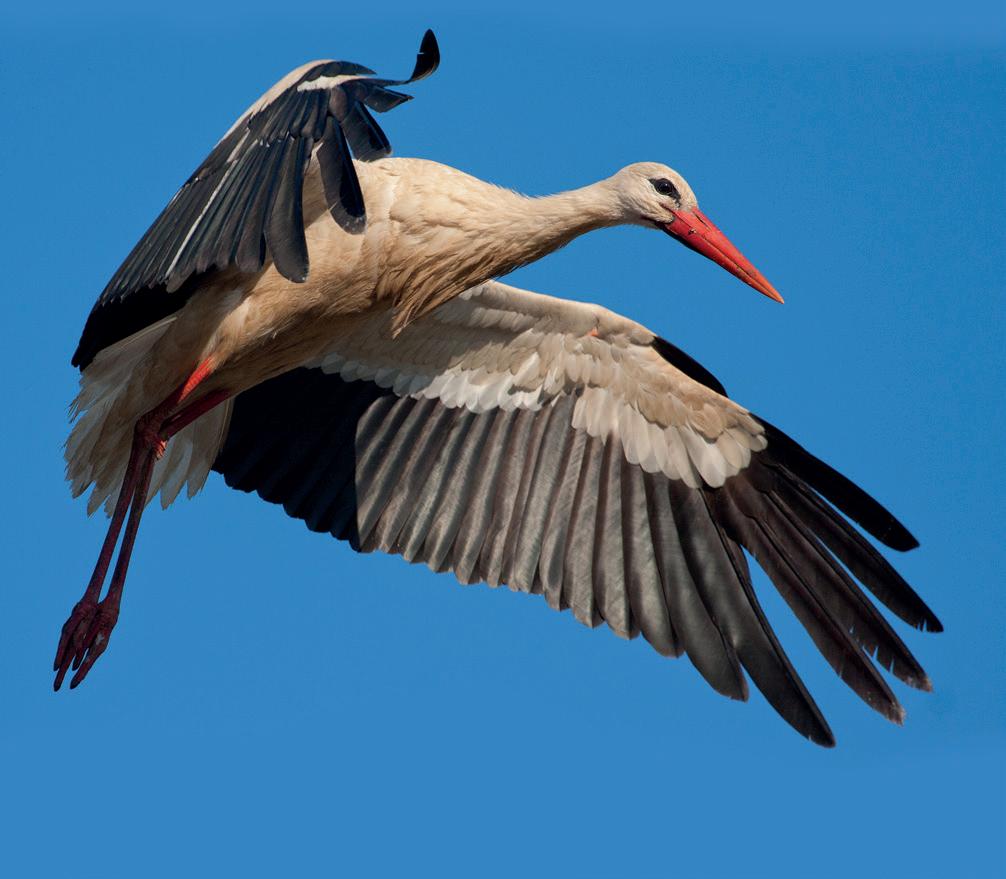
meanwhile have the largest wingspans of all flying creatures on the planet, the Wandering Albatross has a four metres from tip to tips of its wings. The colouring of their plumage also plays an important role in their lives. In general, the plumage of birds that inhabit open spaces, such as those from the Lark family, have more effective protective colouration than that of birds that live in forest areas, such as tits.
A remarkable biological feature of many bird species is the latitudinal movements they make twice a year in search of food and better climatic conditions. Although it may seem incredible, there are birds such as the Arctic Tern, capable of traveling twenty thousand kilometres from the north pole to

han perdido su capacidad de vuelo. Se sitúan justo en el límite a partir del cual remontarse por los aires resultaría imposible, mientras que los albatros poseen las mayores envergaduras de todas cuantas vuelan en el planeta, llegando a alcanzar el Albatros Viajero, los cuatro metros entre las puntas de sus alas. El colorido de sus plumajes también juega un importante papel en sus vidas. En general, el plumaje de las aves que habitan espacios abiertos, como el de la familia de los Aláudidos por ejemplo, posee una coloración protectora más eficaz que el de las aves que viven en zonas forestales, como en el caso de los Páridos.
Un hecho destacable en la biología de muchas especies son los desplazamientos latitudinales que
the south pole, while small insectivorous birds, with some species barely reaching ten grams in weight (genus Phylloscopus, among others), can migrate four thousand kilometres on a ninety-hour nonstop flight, several kilometres above sea level. Some mountaineers have seen yellow-billed chough flying at a height of over eight thousand metres, an altitude that some Anatidae reach during their migrations. The record for speed within the animal world goes to the Peregrine Falcon, which when making a dive can exceed speeds of three hundred kilometres per hour. To be able to breathe at such speed, their nostrils have evolved and undergone unusual modifications, and in some species, such as the Atlantic Alcatraz, their nostril have disappeared completely, preven-
realizan dos veces al año en busca de alimento y mejores condiciones climáticas. Aunque parezca increíble, existen aves como el Charrán Ártico, capaces de recorrer veinte mil kilómetros desde el polo norte al polo sur, mientras que pequeños pajarillos insectívoros, cuyo peso no llega en algunas especies a los diez gramos (género Phylloscopus, entre otros), pueden realizar migraciones de cuatro mil kilómetros en un vuelo sin escalas de noventa horas a varios kilómetros de altura. Algunos alpinistas han visto chovas piquigualdas sobrevolando los ocho mil metros, altura que suelen alcanzar ciertas anátidas durante sus migraciones. El récord absoluto de velocidad dentro del mundo animal corresponde al Halcón Peregrino, que en vuelo picado puede sobrepasar los
76 OTWO 13 / AUGUST 2020 OTWO 13 / AUGUST 2020 77
ting them from taking in water when diving from a height of twenty or more metres. The evolutionary removal of said passages is a necessary and spectacular adaptation of the fishing techniques practiced by birds.
Birds have always attracted the attention of humans, who have hunted, captured, observed or simply admired them, either attracted by the colour of their plumage, by their melodious songs or by their main characteristic; the ability to fly. The latter is what makes them more accessible for observation, more so than other animals that use survival tactics based on remaining unnoticed and cautionary behaviours.

trescientos kilómetros por hora. Para poder respirar a tal velocidad, sus narinas han sufrido curiosas modificaciones, llegando a desaparecer por completo en el caso del Alcatraz Atlántico, para impedir la entrada de agua al realizar picados desde veinte e incluso más metros de altura. La eliminación de dichos conductos es una necesaria adaptación a la más espectacular de las técnicas de pesca puesta en práctica por un ave.
Desde siempre, las aves han llamado la atención del hombre, el cual las ha cazado, capturado, observado o simplemente admirado, bien atraído por el colorido de sus plumajes, por sus melodiosos cantos o por su principal característica, la capacidad de
OTWO 13 / AUGUST 2020 79 78 OTWO 13 / AUGUST 2020
The science and study of birds is called Ornithology and one of the most important aspects of its use as an educational resource should be for the promotion of ethical and behavioural awareness for the reasonable use and enjoyment of our natural resources, without actually depleting them and the urgent need to ensure the survival of the other species on this planet, not only to propagate a romantic notion, but because, sooner or later, the survival of our species is at stake.
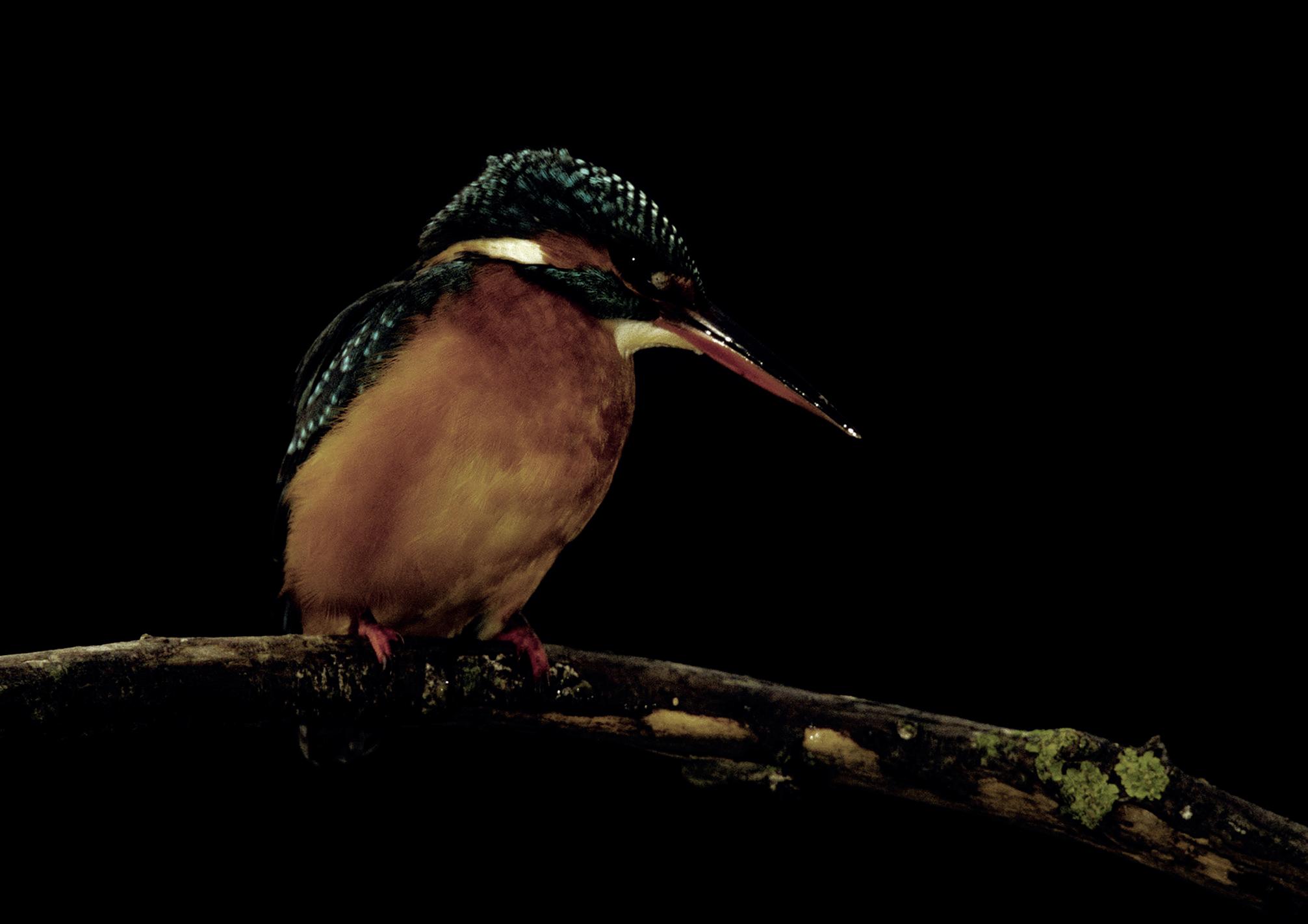
volar, hecho éste que las hace más accesibles para su observación que otros animales que basan su supervivencia en el desapercibimiento y en la cautela de su conducta.
La ciencia que estudia las aves se denomina Ornitología y uno de los aspectos más importantes del empleo de ésta como recurso didáctico debe ser su uso como herramienta de concienciación ética y conductual de cada persona en la utilización racional de las riquezas naturales, ante el disfrute de los bienes comunes sin llegar a esquilmarlos y la imperiosa necesidad de la supervivencia del resto de las especies que con nosotros comparten el planeta, no sólo por propugnar un cierto romanticismo conservador, sino porque está en juego, a plazo más o menos largo, nuestra propia supervivencia como especie.
OTWO 13 / AUGUST 2020 81 80 OTWO 13 / AUGUST 2020
CHAPTER NINE / CAPÍTULO NUEVE
The Sheshia, the headdress of the Rif
Las Shashyas, los sombreros del Rif

Juanlu González Article and images

If there were to be two defining elements of the outfits of the women of the Rif, predominantly for those who live in the mountains, it would be the mendil, a kind of wool or cotton striped apron knotted at the waist, and the large and striking hat made out of plant fibres that covers their heads, called the sheshia or taraza. They are, as recognised today, two basic garments that are staples of any rural woman’s wardrobe, from the poorest to the wealthiest. As strange as it may seem to us at first, a woman that goes out without these items will be accused of being inadequately dressed or not very elegant.
The hats popular name may seem misleading as it refers to many types of bonnets and caps worn throughout the Maghreb. In Egypt, sheshia refers to a cap around which is a cloth wound to form a turban. In Tunisia, the chechia is considered the national cap, curiously of Andalusian origin, taken there by the last Moorish people expelled from Spain simply because they were suspected of not being good Christians, not because they were not Spanish. Today, their proud descendants keep their traditions alive by making this old hat in medinas and souks across the country.
But, beyond the name, there is nothing similar between the hats of North of Africa and those of the Rif. Basically, it is a large palm hat that many outsiders immediately associate with Mexican hats, especially those that are adorned with small hanging pom poms along the rim, but other than that there are few similarities.
Sheshias are made with plant fibres obtained from the leaves and buds of the fan palm, a small palm tree that is very common on both sides of the Strait of Gibraltar, used as the base for many handicrafts such as basketry and the manufacture of everyday objects, such as trunks, bags , bottle racks, mats, brooms, fans, etc. The base of each hat is braided palm, sewn together concentrically, from the crown to the brim, to achieve the desired shape and size. The thinner the braid, the sheshia will have a better the finish and the finer the craftsmanship.
Obviously, its function is to protect the wearers head from the effects of the sun and the heat, especially during the rigorous summers, which are usually particularly hard when working in the fields. Hence the need for shade over the head and shoulders and
Si hay dos elementos definitorios del atuendo de la mujer del Rif, principalmente de las que viven en las montañas, esas son el mandil (mendil), una especie de delantal de rayas de lana o algodón que se anuda en la cintura, y el enorme y llamativo sombrero de fibras vegetales que cubre su cabeza, la shashya o taraza. Son, como las denominaríamos hoy, dos prendas básicas que no pueden faltar en el guardarropa de cualquier mujer rural, desde las más pobres a las más pudientes. Por muy extraño que pueda parecernos a simple vista, una mujer que salga sin él será tachada de mal vestida o poco elegante. El nombre popular de este sombrero puede parecer equívoco y referirse a muchos tipos de bonetes y gorros usados en todo el Magreb. En Egipto, shashya alude al casquete que se coloca en la cabeza y alrededor del cual se enrolla un paño para formar un turbante. En Túnez, la chechia es considerado el gorro nacional, curiosamente de origen andalusí, fue llevado allí por los últimos moriscos expulsados de España por el simple hecho de ser sospechosos de no ser buenos cristianos, no por no ser españoles. Hoy, sus orgullosos descendientes, mantienen viva la tradición de confeccionar su antiguo gorro en las medinas y zocos de todo el país.
Pero, más allá del nombre, seguro que no hay nada parecido en el norte de África a los sombreros rifeños. Básicamente, no deja de ser un enorme sombrero de palma que muchos forasteros enseguida asocian a los sombreros mexicanos, sobre todo a los que adornan el contorno con pequeños pompones colgantes, pero hay pocas similitudes más que destacar.
Las shashyas se elaboran con fibras vegetales obtenidas de las hojas y cogollos del palmito, una pequeña palmera muy común en ambas orillas del Estrecho de Gibraltar, base de múltiples artesanías relacionadas con la cestería y la fabricación de objetos cotidianos, como baúles, bolsos, botelleros, esteras, escobas, soplillos, etc. La base de cada sombrero son las trenzas de palma, que se van cosiendo unas a otras de forma concéntrica, desde la copa hasta el ala, para lograr las formas y tamaños deseados. Cuanto mas delgada sea la trenza, mejor terminada estará la shashya y más fino será el trabajo.
Obviamente, su función es proteger la cabeza de los efectos del sol y del calor, especialmente de los
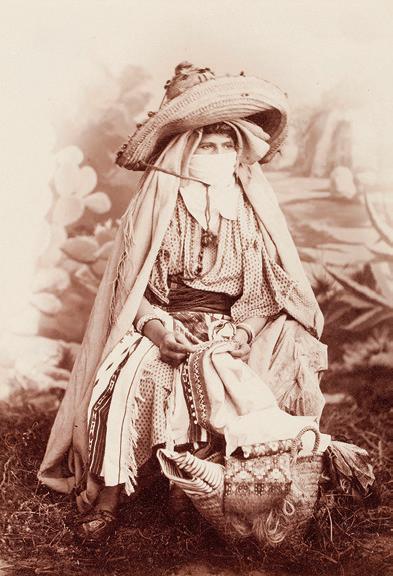



84 OTWO 13 / AUGUST 2020 85 OTWO 13 / AUGUST 2020

materials that allow for perspiration. However, they are also identity related, as many are unique to, or at least characteristic of each tribe or kabyle.
They generally measure a little less than half a metre around the brim, although they can reach up to 75 cm in some rural communes near Tangier. The crown can easily be around 20 cm high and can be anything from very square to slightly conical. The most common sheshia found in souks has four thick blue wool straps that start from the top of the crown to the edge of the brim, finished with a pompom made from the same wool, which prevents the cord from coming loose. The purpose of the straps is to keep the hat’s structure intact and to prevent the -brim from sagging or folding downward under its own weight. Today, most of the sheshia’s that are manufactured are usually smaller in diameter and may not need as much reinforcement, but when consulting old photographers taken more than a century ago, their large brim feature is plain to see, some well approaching a metre in width. However, the wool strips are still present for a purely ornamental and identifying purpose.
It is likely that need for the essential wool strap reinforcement led to the wool and palm combination - popular now in artisan mats - and ended up adorning the hats in a multitude of ways, although not as much as those worn by the charming water carriers of southern Morocco . The dark pom-poms gave way to other multi-coloured strips of wool that encircled the crown, and even small pieces of inlaid mirrors and dangling tassels can be seen all over the edge of the brim. Ordinarily, there are two rows of brightly coloured pom poms circling both the brim and the bottom of the crown.
It goes without saying that in rural settings, there is a vast variety of this ubiquitous garment depending on their use. There are everyday sheshias and even ones for celebrations or for getting married. The traditionally made ones are impossible to find in souks and markets and are only made to order, they are personalised for the wearer and are relatively expensive compared to the other hats.
Despite relating the use of Riffian hats mainly to women, they are also worn by men. They generally prefer palm hats with hardly any ornamentation, at best with a few colour-tinted strips, but it is not un-
rigores del estío, que suelen ser particularmente duros para las tareas del campo. De ahí la necesidad de la sombra sobre la cabeza y los hombros y el uso de materiales que permitan la transpiración. Sin embargo, también cumplen una misión identitaria, ya que muchos de ellos son exclusivos o al menos característicos de cada tribu o cabila.
Por lo general miden algo menos de medio metro de ala, aunque pueden llegar hasta los 75 cm. en algunas comunas rurales cercanas a Tánger. La copa rondará fácilmente los 20 cm de altura y podrá ser, desde muy cuadrada, hasta ligeramente cónica. La shashya más común en los zocos es la que presenta cuatro tirantas gruesas de lana azul que parten desde la parte superior de la copa hasta el reborde del ala, rematados en un pompón hecho con la misma lana, que impide que el cordón se salga. La misión de las tiras es mantener la estructura del sombrero intacta e impedir que el reborde ceda y se pliegue hacia abajo por su propio peso. Hoy día, la mayoría de las shashyas que se fabrican suelen ser de menor diámetro y es posible que no necesitasen ese refuerzo, pero en fotografías que hemos podido consultar con más de un siglo de antigüedad, se observa perfectamente su función en alas, que bien podrían acercarse al metro de anchura. Sin embargo, las tiras se mantienen con una función puramente ornamental y de pertenencia.
Probablemente, esa necesaria función de sostén diera entrada a la combinación de lana y palma — que tanto gusta ahora en esterillas artesanas— y acabó ornamentando los sombreros hasta lo indecible, aunque no tanto como los que usan los pintorescos aguadores del sur de Marruecos. Los pompones oscuros dieron paso a otros multicolores o a bandas completas de lana que circundaban la copa e incluso se llegan a ver pequeños trozos de espejos incrustados y borlones colgantes por todo el borde del ala. Lo más normal es ver como dos filas de pompones de colores vivos circundando, tanto el ala, como el reborde de la copa
Ni que decir tiene que una prenda tan ubicua en los entornos rurales, presenta una gran variabilidad de tipos según los usos. Hay shashyas para diario, para ir fiestas e incluso para casarse. Las más historiadas son imposibles de encontrar en zocos y mercados, solo se hacen por encargo, están muy perso-
OTWO 13 / AUGUST 2020 87

common to see djiblis, the men of the mountains, wearing the sheshia.
In fact, circulating amongst the people of the northern Amazigh fields, there is a curious legend about the origin of these hats, indicating that initially they were exclusively male attire. It is said that in one of the Dutch-Portuguese wars, the Sultan of Morocco brought a large number of Riffian soldiers who intervened in a battle near the Straits. The battle did not go well for them, and when the survivors returned home, they did so with great shame and regret. But, as if that were not enough, the women imposed a penance on the returning men: they had to wear ridiculous hats to remember their disgrace. Over time, they got used to wearing them until, finally, it became an irreplaceable part of their characteristic dress and was extended to women who, originally, considered it a horrible garment.
Obviously, this is just a fable, but just like many other such myths, it contains one truth. At first glance, Seshias may seem strange or even ridiculous, but when we look at them closely and in their proper context, they will surprise us with their beauty, originality and functionality.
nalizadas para su futura usuaria y tienen un coste relativamente alto en comparación con el resto de sombreros.
A pesar de vincular el uso de los sombreros rifeños con las mujeres, también los usan los hombres. Generalmente prefieren los sombreros de palma apenas sin ornamentos, a lo sumo con algunas tiras vegetales teñidas de color, pero no es extraño ver a djiblis, a los hombres de las montañas, usando las shashyas.
De hecho, por los campos amazighs norteños circula una curiosa leyenda sobre el origen de las estos sombreros que los sitúa como atuendo inicial exclusivamente masculino. Se cuenta que en una de las guerras luso-portuguesas, el sultán de Marruecos realizó una gran leva de soldados rifeños que intervinieron en una batalla en las proximidades del Estrecho. El resultado fue adverso para ellos y, cuando los supervivientes volvieron a sus casas, lo hicieron con gran vergüenza y pesar. Pero, por si eso no fuera poco, sus mujeres le impusieron una penitencia: debían llevar unos sombreros ridículos en recuerdo de su deshonra. Pasado el tiempo, se acostumbraron a llevarlos hasta que, finalmente, se convirtió en parte insustituible de su atuendo característico y se extendió a las mujeres que, en principio, lo consideraban como una prenda horrible.
Obviamente se trata solo de una fábula pero, como todas ellas, encierra una verdad. Las sashyas, tras una primera vista, pueden parecer extrañas o incluso ridículas, pero si las observamos detenidamente y en su adecuado contexto, nos sorprenderán por su belleza, originalidad y funcionalidad.

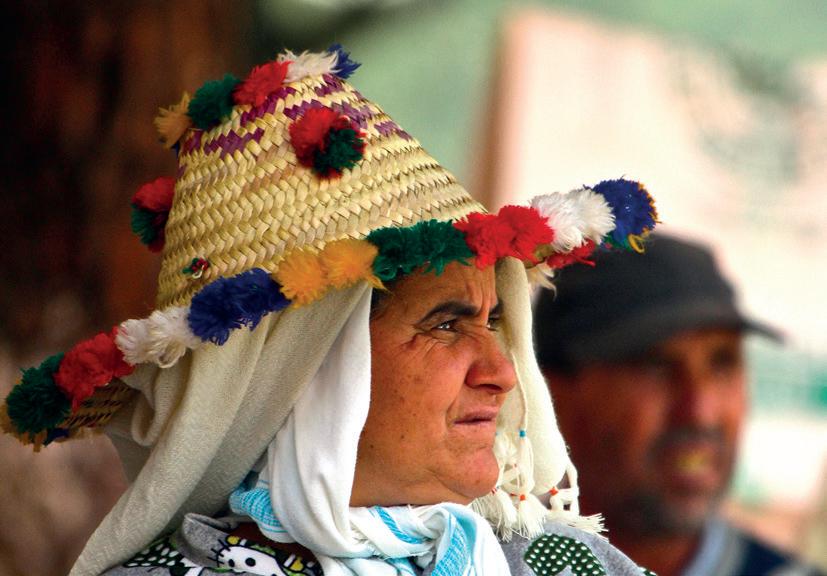

88 OTWO 13 / AUGUST 2020 OTWO 13 / AUGUST 2020 89

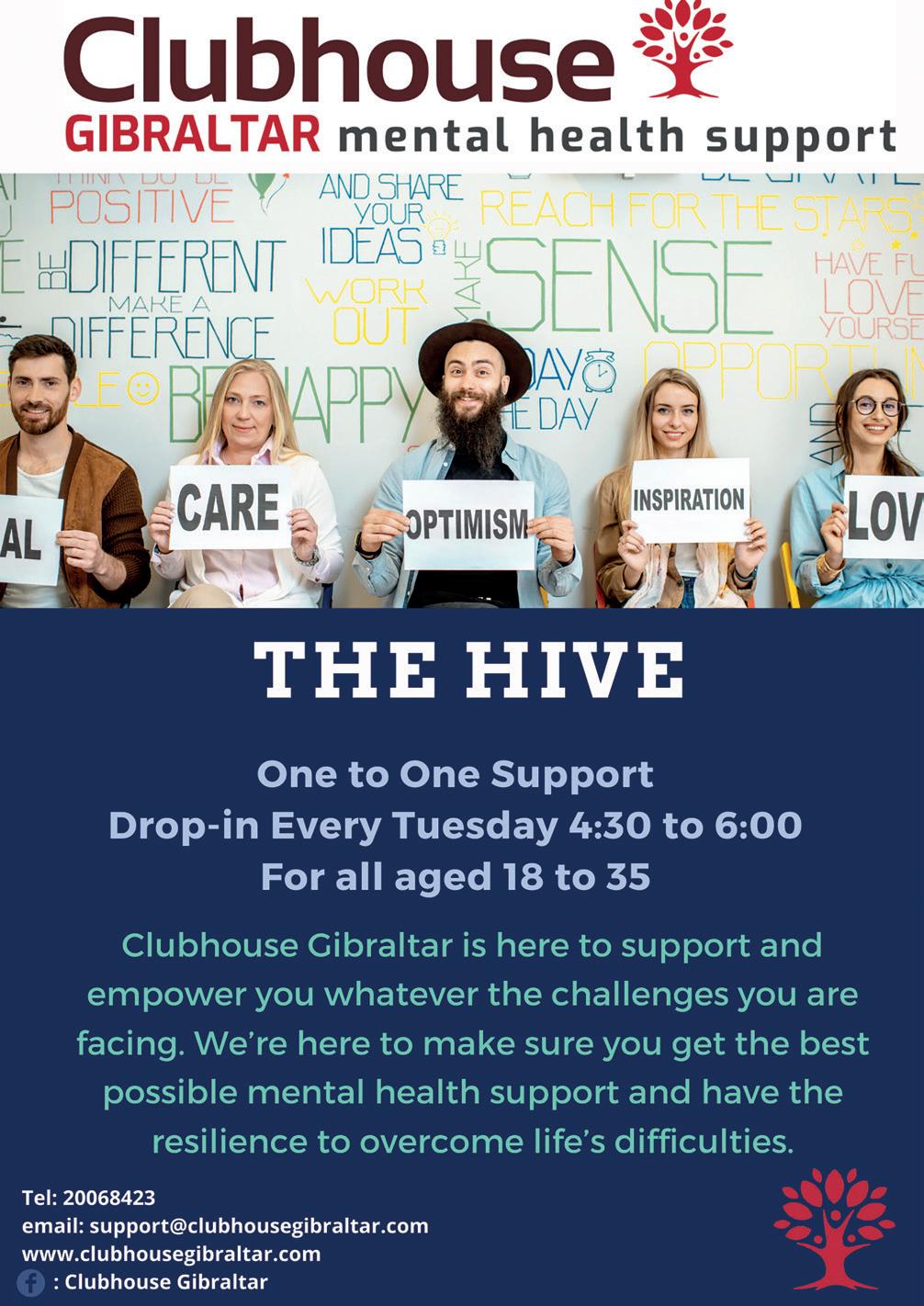
Guía rápida de: Andalucía
Explore closer to home / Explora más cerca de casa



Language: Spanish
Currency: Euro
Capital: Sevilla
Famous for:Tapas, flamenco, stunning architecture and natural spaces.
Idioma: Español.
Moneda: Euro.
Capital: Sevilla.
Famoso por: Tapas, flamenco, impresionante arquitectura y espacios naturales
Algunos de los mejores lugares: Disfruta de las increíbles playas de arena blanca de la Costa de la Luz. Explore la histórica y bella ciudad de Sevilla. Descubre la Reserva de la Biosfera de la UNESCO de La Sierra de Cazorla.
Observa flamencos, ciervos y el lince ibérico en peligro de extinción en el Parque Nacional de Doñana. Pasea por el magnífico Palacio de la Alhambra de Granada. Escápese de las multitudes y disfrute de la hermosa costa del Parque Natural de Cabo de Gata-Níjar. Camina, escala o monta en bicicleta los numerosos senderos naturales de la Sierra de Grazalema
Actividades: Senderismo, deportes acuáticos, natación, buceo, barranquismo, esquí, camping, turismo.
Clima:
De Jebulon - Trabajo propio, CC BY-SA 3.0, https://commons.wikimedia.org/w/index.php?curid=22050175
Some top places: Enjoy the incredible white sand beaches of the Costa de la Luz. Explore the historic and beautiful city of Sevilla. Discover the UNESCO Biosphere Reserve of La Sierra de Cazorla. Spot flamingos, deer and the endangered Iberian Lynx at the Doñana National Park. Wander at the magnificent Alhambra Palace in Granada. Escape the crowds and enjoy the beautiful coastline of the Parque Natural de Cabo de Gata-Níjar. Hike, climb or cycle the many nature trails of the Sierra de Grazalema
Activities: Hiking, water sports, swimming, scuba diving, canyoning, skiing, camping, sightseeing.
Weather:
High Season (Jul-Sep) Hot weather, busy. Shoulder (Apr–May & Sep–Oct) Milder weather, average crowds.
Low Season (Nov–Mar) Cooler weather, fewer crowds.
Eco fact: Andalucía has the most protected natural areas of any autonomous region in Spain
Eco resorts:
Budget: Hotel & Spa Sierra de Cazorla from £50 per night (Jaen).
Mid: Casa SiempreViva from £120 per night (Torrox Costa).
Luxury: La Bobadilla, a Royal Hideaway Hotel from £175 per night (Villanueva de Tapia, Granada).
Temporada alta (julio-septiembre) Clima caluroso, ocupado.
Medio (abril – mayo y septiembre – octubre) Clima más templado, multitudes promedio.
Temporada baja (noviembre-marzo) Clima más frío, menos multitudes.
Hecho ecológico: Andalucía tiene las áreas naturales más protegidas de cualquier región autónoma en España.
Eco resorts:
Economico: Hotel & Spa Sierra de Cazorla desde £ 50 por noche (Jaén).
Medio: Casa SiempreViva desde £ 120 por noche (Torrox Costa).
Lujo: La Bobadilla, un Royal Hideaway Hotel desde £ 175 por noche (Villanueva de Tapia, Granada).
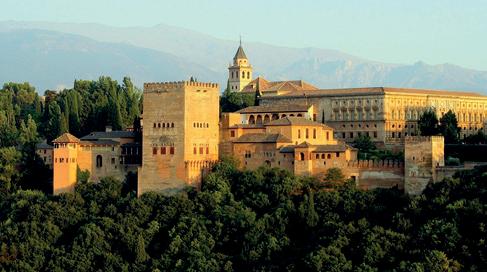
93 OTWO 13 / AUGUST 2020 92 OTWO 13 / AUGUST 2020

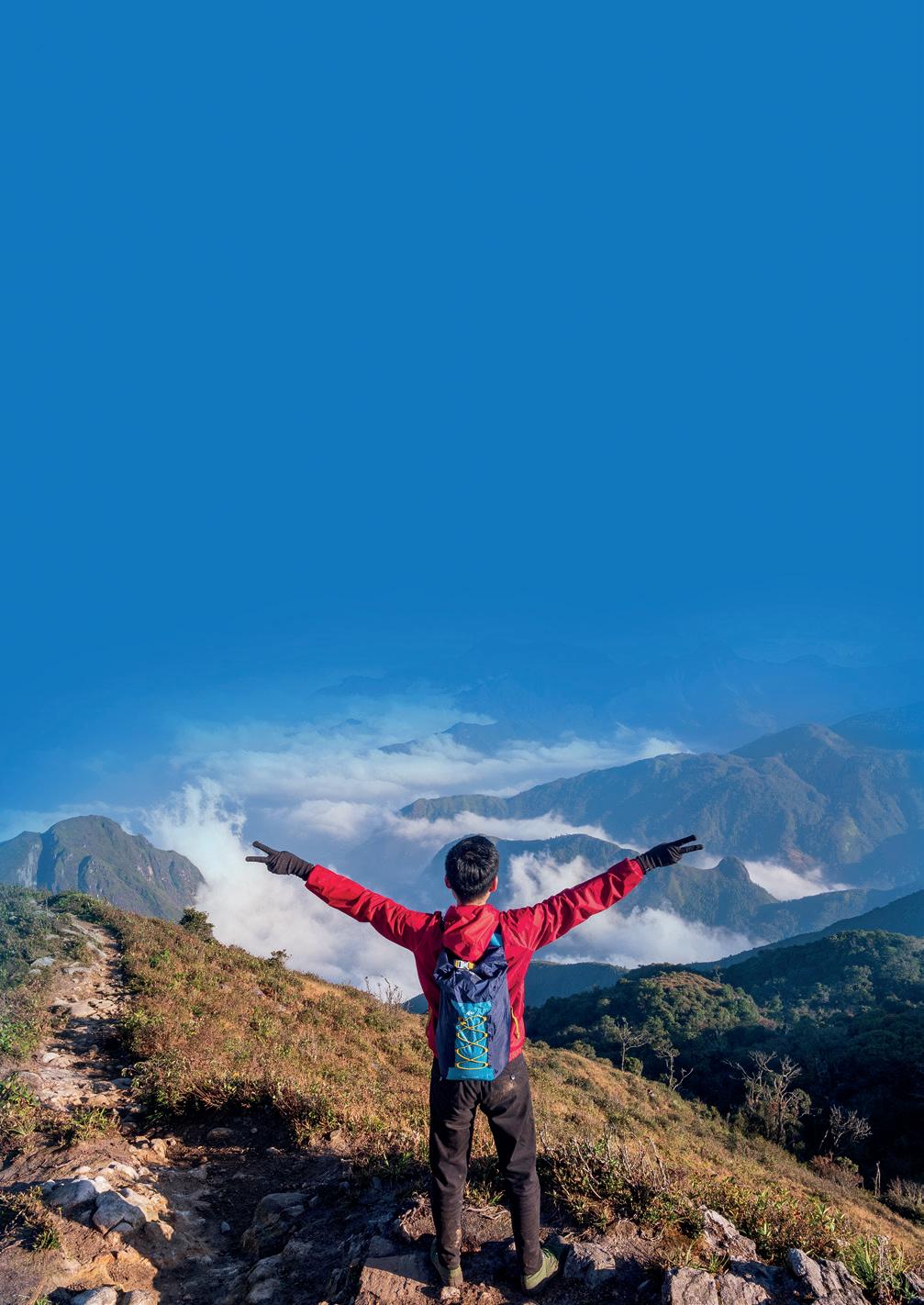
Organized by: OTWO Magazine
Tel. +00350 22500799 / info@otwomag.com
Transport available for groups.Check with us for your requirements. OTWO is a facilitator on these packages. All activities are contracted directly between the respective centre operator and the client. Prices are for the month of July only, please contact us for other dates.
Transporte disponible para grupos. Consultenos si estás interesado. OTWO es un mediador de estos paquetes. Todas las actividades se contratan directamente entre el operador y el cliente. Precios válidos solo para el mes de julio, consulte para otras fechas. Catálogo de Experiencias. Verano
20 SUMMER CATALOG 20

Reserveonlineonthedayofyourtour andusePromocode:OTWO10togeta10%discount! (subjecttoavailability)
ReservaonlineeneldíadeturecorridoyusarelPromocodeOTWO10 paraundescuentodel10%(sujetoadisponibilidad) www.ebike-gibraltar.com
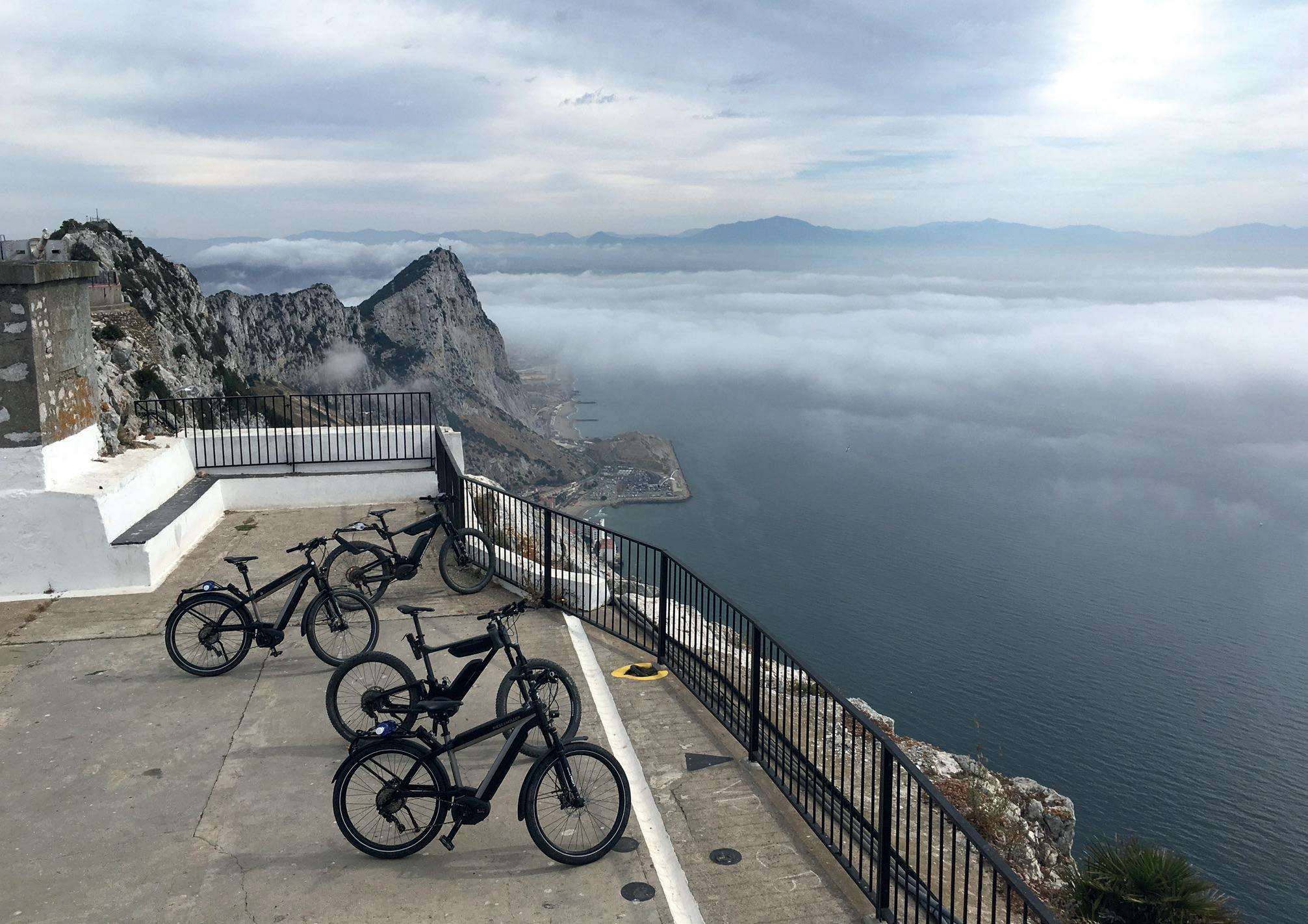
EBIKES DAILY ROCK TOURS Gibraltar
EBIKES DAILY ROCK TOURS. Gibraltar
Enjoy breath taking views across 3 countries and 2 continents, explore Gibraltar’s fascinating history and be introduced to our most famous inhabitants, the Barbary macaques – the only free roaming monkeys in Europe!
Highlights:
Europa Point and Lighthouse, Upper Rock Nature Reserve, Pillars of Hercules Monument, Windsor Suspension Bridge, O’Hara’s Battery (top of Rock 424m), kywalk, Ape’s Den, Great Siege Tunnels, Moorish Castle...and many more. What’s included?
Premium e-bike by Riese&Müller. Cycle helmet. Safety instructions. Entrance fee into the Nature Reserve. An official tour guide. Bottled water.
Duration:
3 hours. Suitable for everyone over 155 cm, over 12 years old and capable of riding a bicycle.
EBIKES GROUP TOURS. GIBRALTAR
Disfrute de las impresionantes vistas de 3 países y 2 continentes, explore la fascinante historia de Gibraltar y conozca a nuestros habitantes más famosos, los macacos de Berbería, ¡los únicos monos que se desplazan libremente en Europa!
Puntos destacados:
Punta de Europa y el Faro, Reserva Natural Upper Rock (Parte superior del peñon), Monumento de las Columnas de Hércules, Puente colgante de Windsor, Bateria de O’Hara (parte superior del peñon - 424m), El Skywalk, Guarida de los monos, Gran túneles de asedio, Castillo Arabé. …y muchos más ¿Qué está incluido?
Alta calidad E-bike de Riese&Müller. Casco de bicicleta. Instrucciónes de seguridad. Entrada a la reserva natural. Guía oficial. Agua embotellada.
Duración:
3 horas. Adecuadas para todos los que midan más de 155 cm, tengan más de 12 años de edad y puedan montar en bicicleta.
£69 per person (por persona)
OTWO 13 / AUGUST 2020 97 OTWO 13 / AUGUST 2020
TAKE A PADDLE DOWN GIBRALTAR’S BREATHTAKING COASTLINE Gibraltar

With In2Adventures, experience first-hand the natural beauty of Gibraltar’s coastline whilst being at one with the ocean. This experience will begin with a short safety briefly allowing you to take to the water feeling ready and confident. Your instructor will be on hand at all times to guide you through this exploration of the eastside of Gibraltar’s majestic coastline as well as opening up the opportunities to witness the sea life, whether it be Dolphins, Sun fish or even Fin Whales.
The SUP Safari lasts for approximately two hours and can be tailored to suit the abilities and needs of the group made up of a total of six people (over the age of 9 years), with some SUP or swimming experience. The price for this activity is £30 per person, inclusive of all equipment.
What to bring?
• Towel
• Swimwear
• A drink
• Sun Cream
Recorrer la costa gibraltareña a bordo de una tabla de paddle.
Con In2Adventures, experimente de primera mano la belleza natural de la costa de Gibraltar mientras se une al océano. Esta experiencia comenzará con una breve lección que le permitirá adentrarse en el mar con seguridad y confianza. Su instructor estará disponible en todo momento guiándole en esta aventura en la que explorará la majestuosa costa este gibraltareña, así como propiciar la posibilidad de avistar curiosidades de la vida marina desde delfines a pez luna, incluso algún rorcual (ballena). El recorrido del SUP Safari tiene una duración aproximada de dos horas y permite adaptarlo a las habilidades y necesidades de un grupo de hasta seis personas donde los niños mayores de nueve años, con cierta experiencia en SUP y desparpajo en la natación, son bienvenidos. El precio de esta actividad es de 30 euros por persona, incluyendo el equipo.
¿Qué debe llevar?
• Toalla
• Traje de baño
• Una bebida
• Protección solar
OTWO 13 / AUGUST 2020 99 98 OTWO 13 / AUGUST 2020
Located in the extreme north west of the province, the landscape ranges from countryside to marshes, the former being employed in agriculture, the latter, near the mouth of the River Guadalquivir, consisting of unspoiled scenery of extreme beauty. The highlights of the Doñana Natural Park.
Trebujena marshes were used by Steven Spielberg in many scenes from his film Empire Of The Sun (1987).
The village, located atop a gentle hill which affords fine views of the whole municipal AREA, is of Arabic origin; worthy of note are the remains of Perez de Guzman Castle (s. XV) and La Purisima Concepcion Church (s. XVI).
We invite you to stay in a delightful country estate of 7.000m2, surrounded by vineyards, close to the town of Trebujena and just 5km from Doñana National Park.
The estate is an oasis of tranquility, treating our senses to almond, carob, fig, plum, pomegranate, apricot, loquat and plum trees, grape vines, oleander, rosemary, lavender, a vegetable garden and the best sunset in Doñana.
Casa Martinete is a charming house of 136 m2 in which you’ll be able to enjoy, in total privacy and exclusivity, the best of Cádiz and Andalucia. It offers a comfortable living-dining room with chimney, three double rooms, two bathrooms, a fully equipped kitchen, laundry room, terrace and solarium, large porch and garden.
We offer ornithological tours, visits to saltpans, wineries and vineyards – Gastronomic experiences. Send us an email at info@otwomag.com with dates you would like to come and visit, how many people will be joining you and details of any tours you would be interested in and we will provide you with the full cost of your stay.

VISIT DOÑANA IN THE BEST ENVIRONMENT CASA MARTINETE
Visita Doñana
en el mejor entorno de Trebujena CASA MARTINETE
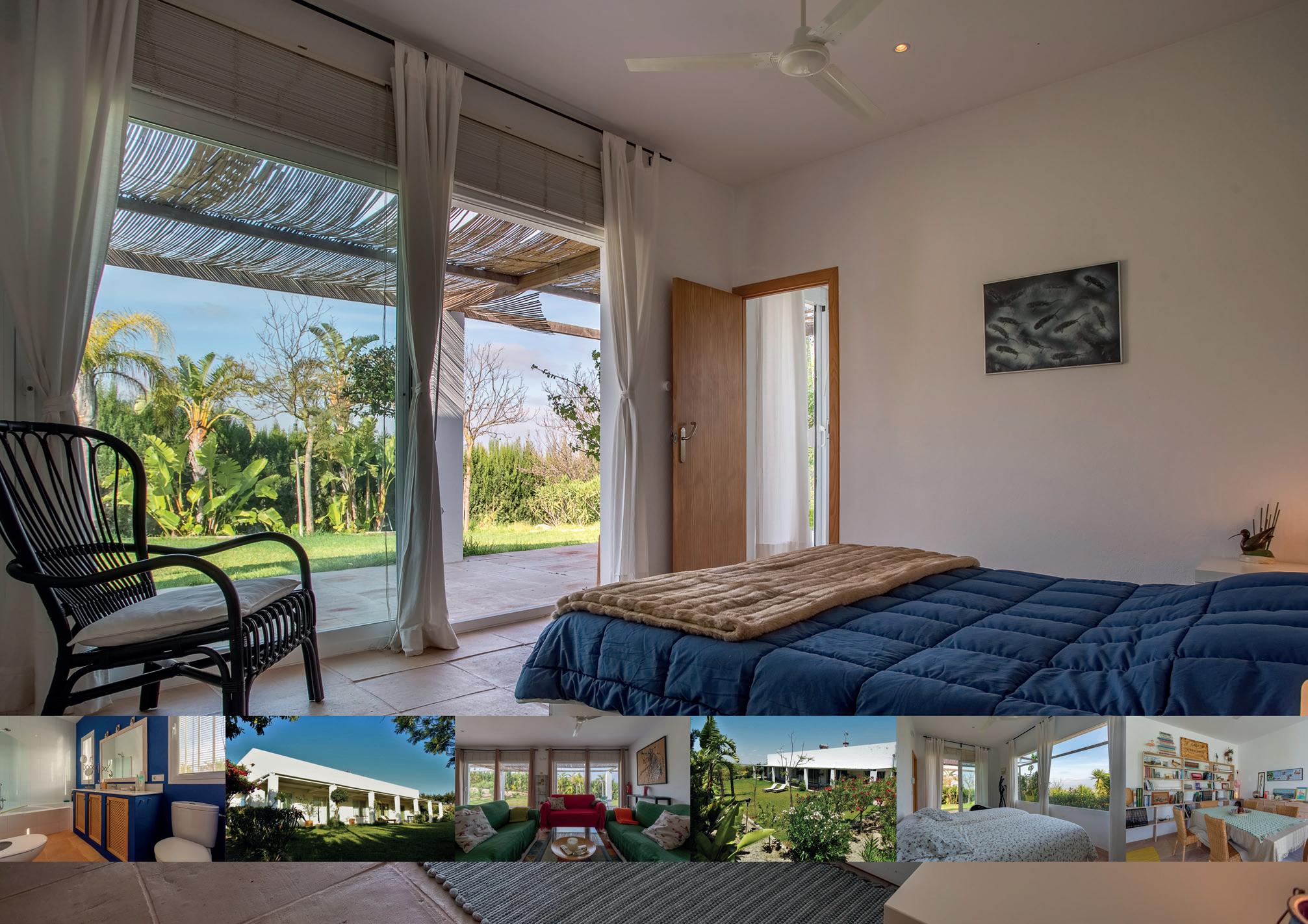
Situado en el extremo noroeste de la provincia, el paisaje se extiende desde el campo hasta las marismas. El primer paisaje enumerado, se emplea en el desarrollo agrícola. El segundo, cerca de la desembocadura del río Guadalquivir, recorre paisajes vírgenes de extrema belleza. Lo más destacado del Parque Natural de Doñana.
Las marismas de Trebujena, fueron utilizados por Steven Spielberg en muchas escenas de su película El Imperio del Sol (1987).
El pueblo de origen árabe, está situado en lo alto de una suave colina, y ofrece unas magníficas vistas del Parque Natural dentro del del municipio gaditano; son dignos de mención los restos del Castillo de Pérez de Guzmán (s, XV) y la Iglesia de la Purisima Concepción (s.XVI).
Le invitamos a que te alojes en una encantadora finca rural de 7.000m2, rodeada de viñedos, cerca de la localidad de Trebujena y a tan solo 5km del Parque Nacional de Doñana.
La finca es un oasis de tranquilidad, que invita a nuestros sentidos a disfrutar de los almendros, algarrobos, higueras, ciruelos, granados, albaricoques, nísperos, vides, adelfas, romero, lavanda, un huerto y la mejor puesta de sol en Doñana.
Casa Martinete, es una encantadora casa de 136 m2 en la que podrá disfrutar, con total privacidad y exclusividad, de lo mejor de Cádiz y Andalucía. Cuenta con un cómodo salón-comedor con chimenea, tres habitaciones dobles, dos baños, una cocina totalmente equipada, lavadero, terraza y solarium, amplio porche y jardín. Se orece al visitante tours ornitológicos, visitas a las salinas, bodegas y viñedos -experiencias gastronómicas. Envíenos un correo electrónico a info@otwomag.com con las fechas en las que le gustaría visitar Casa Martinete, el número de personas que le acompañarán y los detalles de las excursiones que le pueden interesar, y le indicaremos el coste total de su estancia.


